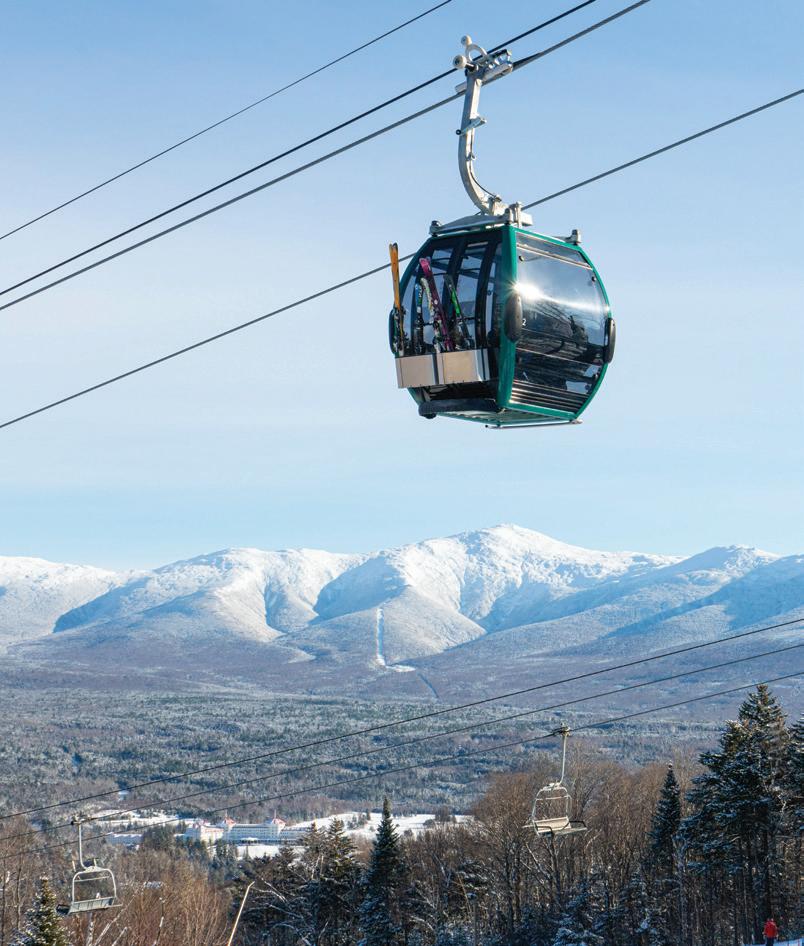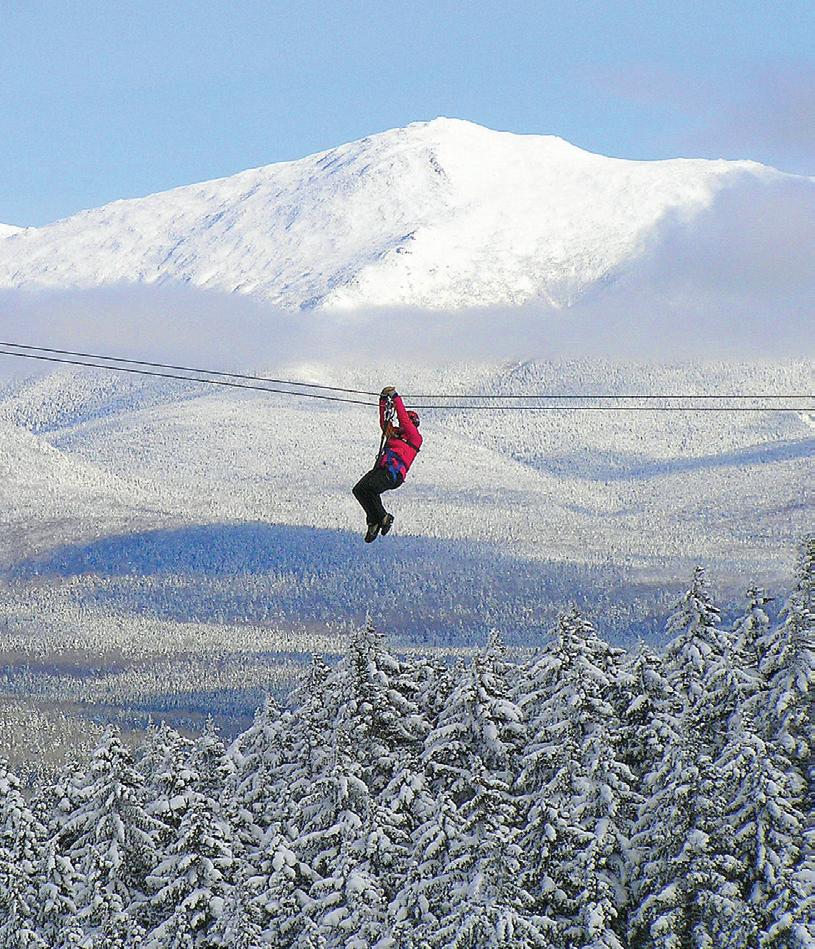


















58 /// Winter
From outdoor adventures to indoor delights, we’ve got the 35 best reasons to stick around New England this season.
Elin Hilderbrand’s hold on her avid readers comes to life on a Nantucket January weekend. By Meg Lukens Noonan
Skaters take a harborside twirl against a pictureperfect backdrop at Rhode Island’s Newport Harbor Island Resort. “Winter Fun Guide,” p. 58

How a ski jump that was once the pride of the North Country may rise up once again. By Bill Donahue 94 /// The Storm
Cathie Pelletier’s new book, Northeaster, puts a spotlight on ordinary people caught in extraordinary circumstances.
With skill, patience, and a bit of luck, Roger Irwin captures nature photos that reveal a world of wonder.
Hitting the trails at the Jackson (New Hampshire) Ski Touring Center. Photo by Cait Bourgault
Yankee (ISSN 0044-0191). Bimonthly, Vol. 87 No. 1. Publication Office, Dublin, NH 03444-0520. Periodicals postage paid at Dublin, NH, and additional offices. Copyright 2022 by Yankee Publishing Incorporated; all rights reserved. Postmaster: Send address changes to Yankee, P.O. Box 37128, Boone, IA 50037-0128.
ON THE COVER Publishing Incorporated; all rights reserved. Postmaster: Send address changes to Yankee
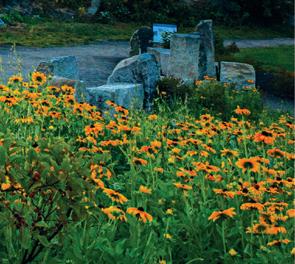





























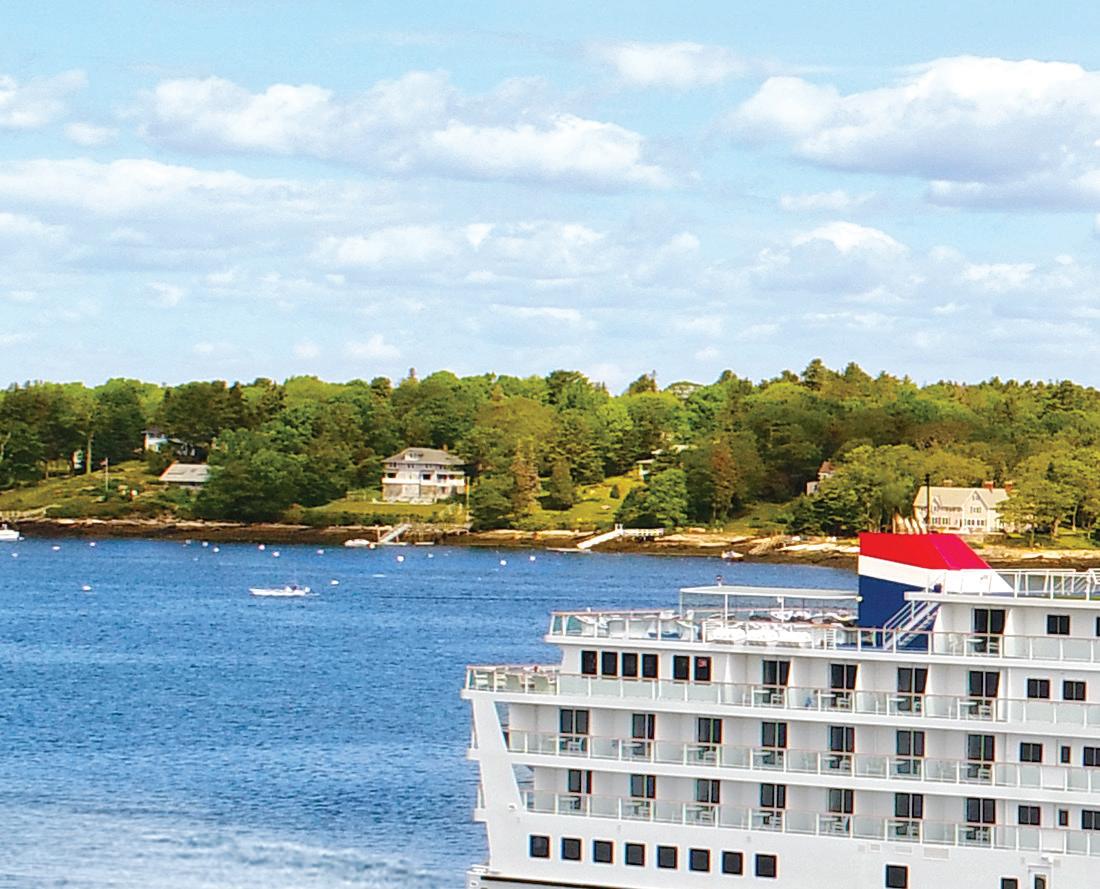


Discover how a southern Vermont saltbox from the 1980s was rebuilt as a timeless mountain ski home. By Lisa Gosselin Lynn

On the South Shore of Massachusetts, Danielle Driscoll’s creative reinvention has become a family affair. By Annie Graves
In midcoast Maine, melty cheese known as raclette is at the heart of a simple, cozy meal. By Amy Traverso

40
With the Super Bowl right around the corner, we’ve got two crowd-pleasing appetizers to warm up the home team.
By Amy Traverso
With camera in hand, our Canadian correspondent shares how to enjoy his beautiful hometown, Québec City, in winter. Story and photos by Renaud Philippe

54

Under-the-radar ski mountains offer a bit of elbow room for your next downhill run. Compiled by Katherine Keenan
56
Fireplace fans, look no further: Warmed by flickering hearths of all shapes and sizes, these New England inns and restaurants excel at offering the cozy side of winter. Compiled by Bill Scheller
Contemplating the two faces of winter—a season that rewards our loyalty even as it tests our resilience.
By Mel Allen
Joe Bills
Ben Hewitt








moved to Maine during a January snowstorm over half a century ago.
I had known only mid-Atlantic winters, and soon I discovered a different season altogether, snow drifting past windows, cold plunging to 20 below. I learned what happens to an old car’s engine when antifreeze runs low. But I also came to appreciate the comforting sound of plows during the night, the warmth from a woodstove, the rush of clicking into Nordic skis and taking off into a forest. My young career as a freelance writer was made possible by Mainers who headed to warmer climes and needed someone to keep their home safe. One winter I lived by the sea near Biddeford Pool, another time in Portland, another in Yarmouth. I did my part and was sheltered for free.
I understand why some people leave before December’s first flurries, not to return until buds blossom on the trees. But as our “Winter Fun Guide” [p. 58] shows, there is a special satisfaction here when you dress in layers and embrace all that awaits, along with the special quality of light and beauty that belongs to no other season quite like this. Photographer Renaud Philippe makes the case that few places celebrate colder months like his home of Quebec City [“Weekend Away,” p. 44]. And “The Queen of Summer … in Winter” [p. 72] shows that even Elin Hilderbrand, whose novels set in beach-season Nantucket have
become best-sellers, finds deep pleasure in the inward turn that winter leads us to.

New Englanders also understand that winter tests our resilience, too. The news this autumn has been filled with storms: first Hurricane Fiona and then, of course, Hurricane Ian. We read about homes swept away, and lives lost. Rarely, though, do we get to know the people who made it through and those who did not. Using her novelist’s eye for detail, Maine writer Cathie Pelletier re-creates what happened to those whose world was forever changed by another storm, one that buried northern New England in the winter of 1952. Her new book, Northeaster, brings us into the lives of ordinary Mainers, and of one family on the New Hampshire coast, who found themselves needing to call on every ounce of courage and endurance—and even pure luck—to make it through. And she lets us see the hard, intimate moments when that is not enough. Though that blizzard happened 70 years ago, our adapted excerpt [“The Storm,” p. 94] shows how connected and vulnerable we all are when nature unleashes such force. A force that connects us past and present, now and far into the future.
Mel Allen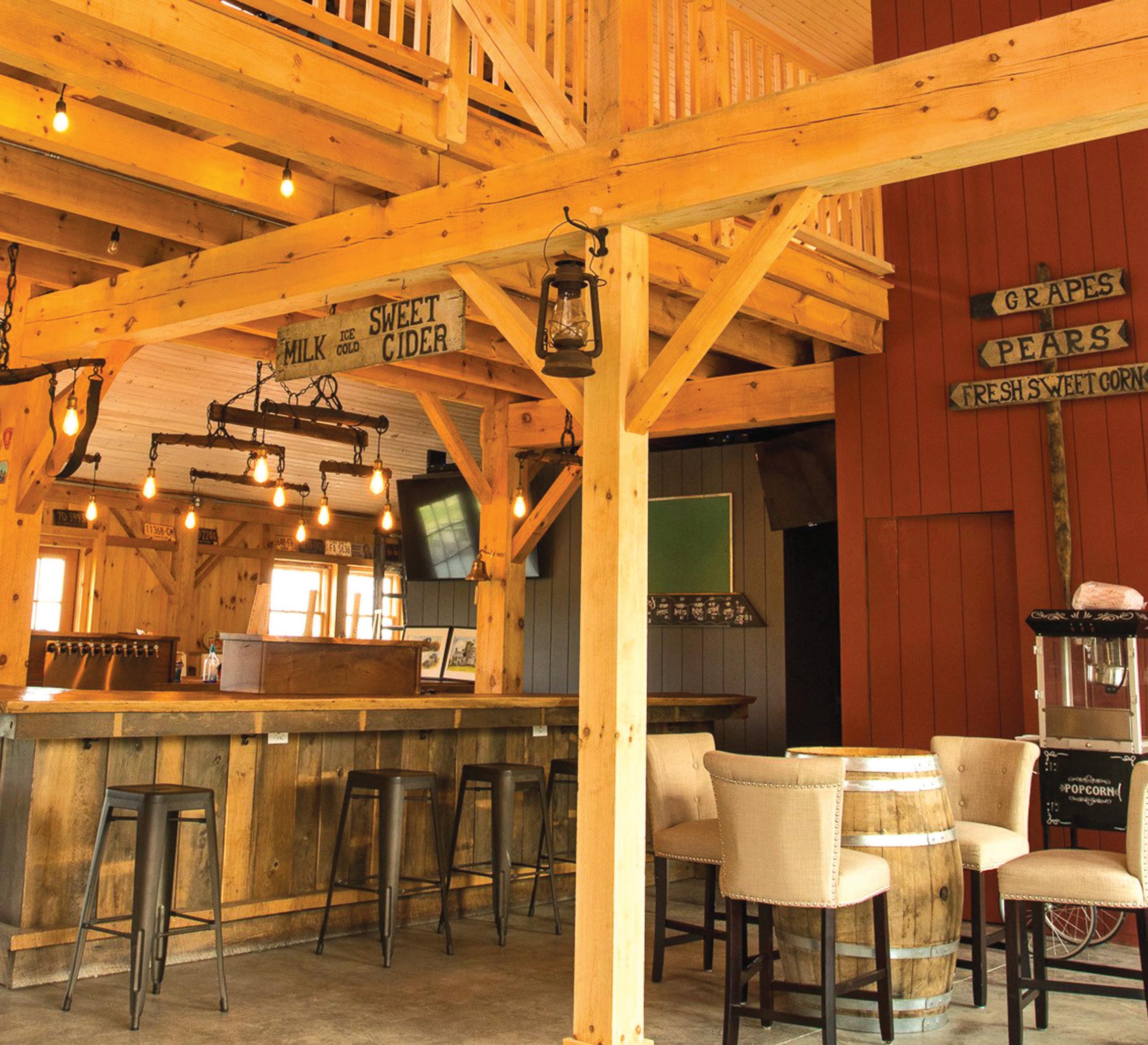


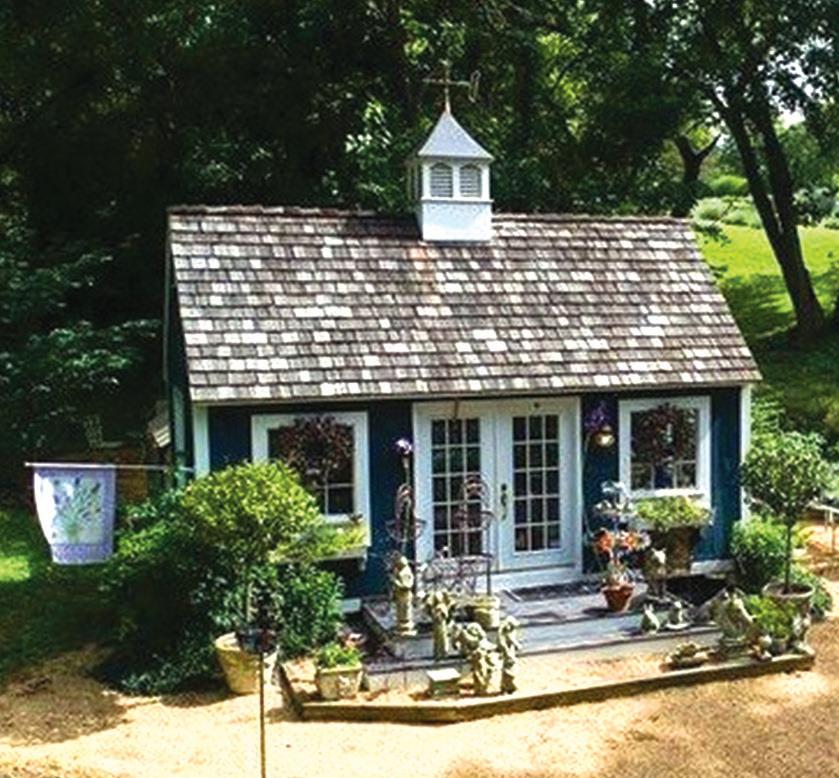





Though she had read some of Nantucket author Elin Hilderbrand’s books (“on the beach, of course!”), Noonan didn’t know much about her before reporting “The Queen of Summer … in Winter” [p. 72]. “In spending time with her, I learned that while she is, in many ways, living the kind of fabulous sun-kissed life she writes about, she’s also a highly disciplined writer who takes her craft and her fans—and her impending retirement—very seriously.”




“The Storm” [p. 94] is an excerpt of Pelletier’s latest book, Northeaster—whose title may give some readers pause. But the acclaimed author, who hails from northern Maine, believes the use of “nor’easter” is about as authentically Maine as the accents in Murder, She Wrote. And as Pelletier notes in her book, “The Oxford English Dictionary gives the term nor’easter an origin as early as the 1500s, long before any New Englander read a weather report.”

As an independent documentary photographer, Philippe has traveled everywhere from Haiti to Nepal, but he relished the chance to turn his lens on his hometown, Québec City [“Weekend Away,” p. 44]. “This is a city that, for my work, I often leave and find again, that I rediscover year after year, season after season,” he says. “We don’t reinvent classic places like this, but instead find new ways to look at them.”
This Brooklyn-based illustrator and graphic designer from Buenos Aires, Argentina, provides the endearing artwork for editor Mel Allen’s essay about teaching in rural Maine [“The Boy Who Walked on the Moon,” p. 10]. “I related to the feeling of having a teacher/safe haven who created space for a child to dream,” Mello says. “I think I am where I am, and what I am, in large part because of a teacher like that.”
“I like to say that my life was built one cookie at a time,” says Gallant, who grew up running around her mother’s bakery in Newburyport, Massachusetts. That early love of food pointed the way to her eventual career as a Bostonbased food photographer who works for the likes of Food & Wine, Condé Nast Traveler, America’s Test Kitchen, and, of course, Yankee, for which she created the stunning photos in this issue’s food feature, “A Winter Feast” [p. 34].

A graphic designer and illustrator whose work has appeared in Esquire, The New York Times, and Wired, among others, Rogers lives in Texas but had no problem channeling the feeling of our “Winter Fun Guide” [p. 58]. The assignment came right on the heels of working on a big holiday campaign for another client, “so my head was already very much in the snow! Which is ironic, since we just came off one of the hottest summers on record!”
Thank you for the powerful interview with JerriAnne Boggis [“Conversations,” November/December]. It challenges us all to step back and try to understand the feelings of those who may feel different from a perceived majority in any community.
All skin colors matter; all emotional, mental, and social feelings matter. All people have unique strengths which need to be identified and valued. Yes, attitudes about the human condition have been strongly influenced by the media, politics, money, and more. But those things don’t have to stop us from personally reaching out in our own communities to people who are not just like us and who are hurting because of feelings of exclusion.
JerriAnne Boggis sees herself as “a warrior, not a victim.” What a great mentor. Americans, listen up.
 Susan Conroy Jacksonville, Florida
Susan Conroy Jacksonville, Florida
The young men and women in Erin Rhoda’s article “Lessons of the Field” [September/October] will cherish the memories and work ethic ingrained by the Aroostook County potato harvests. In most parts of America, people

do not even know where their food comes from, let alone anything about the people who harvest it with care and commitment. These young people will know the where, when, why, and how—and will be able to translate that experience into whatever life they build for themselves in Maine or elsewhere. Bravo to them for carrying on the great American tradition of hard work and dedication! I would advise them to keep it up, because the country needs people with that kind of can-do ethos.
James Babashak via NewEngland.com
Ben Hewitt’s essay on gun ownership, “Loaded Questions” [November/ December], drew plenty of letters from Yankee readers with strong feelings on the subject. Here’s a sampling of what they shared:
Kudos to Yankee and author Ben Hewitt for a well-thought-out and relatively balanced article on guns. Journalism at its best tries to present both sides of any discussion, but it is rare to see today in any media. I envy Mr. Hewitt’s freedom in Vermont; as a resident of the state with the most oppressive—and ineffective—gun laws in the nation, I am frustrated daily with the hassle of trying to abide by them.
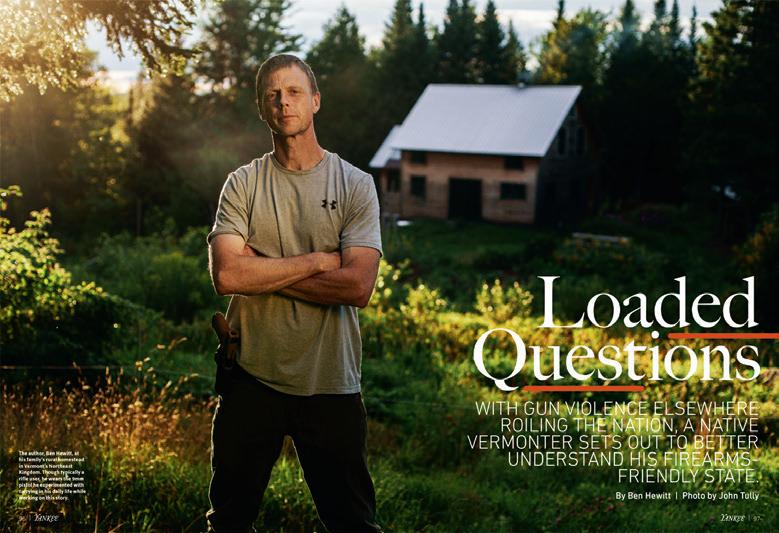
Bill Donahue’s article on North Atlantic right whales and the New England lobster industry [“Collision Course,” September/October] sparked a flurry of comments on Yankee ’s social media and website, with many feeling it showed Maine lobstermen in a poor light. One reader pointed out that there hasn’t been a single documented right whale death caused by Maine fishing gear in two decades, and suggested, “Don’t you think you should have said that?” Another reader, however, praised the article’s reporting as balanced, saying, “How is it that both sides of this ‘collision course’ come out seeming sympathetic?” Read for yourself, and weigh in at newengland.com/ rightwhales. —The editors

We want to hear from you! Write to us at editor@yankeepub.com. Please include your name and hometown, and note that letters may be edited for length and clarity.
Much as with alcohol during Prohibition, the anti-gun people hope that if they make guns illegal, gun violence will go away. But if you want to end “gun” violence, you have to focus on the causes and cures of the violence, not the tool.
John Willsie Jamestown, New YorkBen Hewitt’s thoughtful article was not only a timely read given today’s news headlines, but also a balanced examination of the issue of carrying handguns.
That said, Hewitt chooses to describe his experience of carrying as a “sinister” feeling. As a multidecade holder of a CCP (concealed carry permit) from two Eastern states, I have never felt “sinister,” but instead “prepared” to not become a helpless victim of crime. The difference between the two words speaks volumes.
Mike Van Winkle Sorrento, Maine
I always look forward to Ben Hewitt’s column when each new Yankee arrives, so I turned right away to “Loaded Questions” to see what his ever-reasonable approach to gun ownership would be. Well... off to a bad start when I see Ben’s “Make my day!” photo on p. 96, complete with holstered pistol and accompanying assertion that guns make him feel “powerful.” Come on, Ben! All we need to know is that Japan has one civilian-held firearm per every 330 citizens, and in 2021 that country experienced a total of one firearm death. It’s not complicated. Ban guns!
Ken PotterSan Diego, California Gun Owners of Vermont president Eric Davis says [in the article], “We don’t have a gun problem, we have a psychological problem.” Can he mean that countries with sane gun laws—where mass shootings are a rare occurrence—are less crazy than we are? It would seem so, as they have apparently determined how to keep guns out of the wrong hands.
And, if guns represent freedom to Americans, the question must be asked: Are those countries less free? If you mean less free to worship, watch a movie, shop, attend a concert, or go to school without fear of being shot, the answer is no.
David Crane Stockbridge, Massachusetts


 ILLUSTRATION BY EUGENIA MELLO
ILLUSTRATION BY EUGENIA MELLO
was in my early 20s when I taught my first fourth-grade class in a small Maine town. My only experience was that once I had been 10 years old. I was hired because the district wanted a male teacher for a group that had frustrated their educators in earlier grades. I had just returned from the Peace Corps, and the thinking seemed to be that if I could survive the rigors of an equatorial mountain town, I could tame 27 country kids with attitudes.

I taught 80 children during my three years, and today they are pushing 60; no doubt a number have grandchildren, perhaps even some entering fourth grade. Occasionally I get the urge to see my former students again, because I knew them when they were young, and I wonder what happened after. And maybe, I want to know if they remember, too. Back then, want-
ing to help them succeed often kept me awake at night.
One winter day there was a knock on the classroom door. A woman stood there, and beside her was a boy. She said he was from another town and he had come here to live with a foster family. He was short, sandyhaired, unsmiling. He said his name was Faron. The other kids looked on in silence, aware there might now be a shift in the class dynamic.
I asked him to write his name on the blackboard. He didn’t move. I thought he was shy and said I’d walk with him to the board. He motioned to me. I leaned down, and he whispered, “I don’t know how.”
This was back when instruction was done in groups separated by ability, especially in reading. Faron and I became a group of two, and each day we sat together reading “books” I wrote
for him. They were no more than 10 handwritten pages, stapled together, and they came with bold titles in black Magic Marker. Faron flew with Neil Armstrong and Buzz Aldrin on Apollo 11, and as Armstrong stepped onto the lunar surface, so, too, did Faron. He fought through cold and ice-choked waterways to plant a flag at the North Pole with Admiral Robert E. Peary. He stood with Edmund Hillary on top of Everest. He set sail from Plymouth, England, aboard the Mayflower. He was a scout with Lewis and Clark. He was the lone survivor at Little Big Horn. He found his way to this little Maine town where he was brave enough to tell me what he did not know.
I don’t know whether he learned to read that year or whether, as I suspected, he memorized the stories from all the times we read them, and the words flowed. Soon he was reading the tales of his exploits aloud to a larger group, and a few months later the school year ended, and Faron disappeared from my life.
Not long ago, I typed his name into Google. What I found was his grave marker and, beneath it, the year 2002. He had not yet reached 40. He had died on a street in Portland. Maybe he kept those stories for a while. Maybe not. Teachers rarely know if they change lives, but sometimes—if they are lucky—they can change a few months here and there, when even a little boy with so much stacked against him can be a hero, when he reads aloud about the night he walked on the moon.
When a child cannot read, what can a teacher do?











A small mountain in Maine delivers a big-time thrill.


 BY IAN ALDRICH
BY IAN ALDRICH
For a brief, stomach-churning moment, I had a painful vision of my future: A crash? A voice asking if I was OK? I wasn’t totally sure. The only certainty was that as I sat in a borrowed sled atop the toboggan chute at the Camden Snow Bowl, I wanted to bail. It was a Friday afternoon in mid-February, the opening day of the weekend-long U.S. National Tobog gan Championships. In a matter of hours this area would be open to more daring sledders from around the country. Until then, however, anyone with the gumption to climb the hill to the starting platform could sample the glory. So long as they possessed more courage than I felt just then.
“Hold on,” I shouted to the chute master, Stuart Young, whose hands gripped a big lever.
“Maybe we shouldn’t do this.” Then I heard the voice of my 11-year-old son, Calvin, seated in front of me.
“Come on, Dad,” he implored. “Let’s go!”
I locked eyes with a smiling Young and meekly returned a grin. “Yeah, Dad,” Young said, releasing the gate, “let’s go.” And with that, the front of our sled dropped down onto the chute and we were off. My son screamed with delight.
So many others have shared his reaction. If there is a center point in the toboggan world, it is Camden, Maine. Here, at the foot of the Snow Bowl, a small town-owned ski moun tain, sits the Jack Williams Toboggan Chute. This 400-foot wooden run first opened to the public in 1936 and is still considered the
opposite : A two-man toboggan team hurtles down the 400-foot-long Jack Williams Toboggan Chute, a time-honored fixture at Maine’s Camden Snow Bowl.
above : “Golden Girls” (from left) Sarah Maxcy, Amanda Overlock, and Carrie Overlock head to the top of the chute at the 2022 U.S. National Toboggan Championships. Their team, Shear Madness of Warren, Maine, won the Fastest All-Female Team category and placed second in Best Costume.

longest of its kind in the country. To the uninitiated, its features are both simple and daunting: a steep drop and then a long, icy straightaway that spills out onto a frozen Hosmer Pond. It’s not unusual for sleds to top 40 mph by the time they hit the pond.
“Sometimes you get two trips in one,” says Young, a Camden native whose father helmed the rebuilding of the chute in the ’60s. “You have the chute run. And then when you get out on the lake, you have a whole other run.”
The fastest times are clocked at the U.S. National Toboggan Cham pionships, an annual February event started by the Snow Bowl in 1991 as


a fundraiser for the skiing operation. Despite the race’s grand title, the bar rier to actually becoming one of the 400 teams to compete is low: Your sled must be made of wood and you need to meet certain size and weight restric tions. Otherwise, no real experience is necessary. Pay the registration fee, and you’ll get a bib number.
Which is to say, this event both is and isn’t a race. Oh sure, it attracts obsessive types who’ve worked all year on their sleds, but coming as it does in the depths of winter, the weekend serves up a hearty stretch of light and noise when those things are in short supply. There’s tailgat ing on the pond. There’s live music. And there’s a costume parade. Maybe you’ll see a team clad in NASA blue onesies, or dressed as Golden Girls characters. It’s hard to miss the fid dle player who strolls the crowds or the man dressed as Sasquatch who clutches a beer in one hand and highfives new fans with the other. At these championships even the slowest
from lower left : Dressed in their best Snoopy
of racers receives applause.
“People that come here are often brought here by other people,” says Holly Anderson, the Snow Bowl’s assistant director and co-chair of the toboggan championships organizing committee. “They’re here as specta tors, but then they come back as rac ers.” She laughs. “It’s kind of an insidi ous thing that we’ve got going here. We make it so fun that they want to get on that chute and try it out.”
I got a taste of that as my sled hit the straightaway. It had been unseason ably warm, which meant the ice that Young and his team had been so dili gent in building up earlier that morn ing had softened. Our quick descent gave way to a petered-out finish that just barely brought my son and me to the pond. As we coasted by the timer’s station, the few onlookers still in atten dance clapped for us. And, like many a tobogganer before me, I felt certain thoughts begin to percolate. Maybe, just maybe, I started to believe, we’d race in this event one day ourselves.







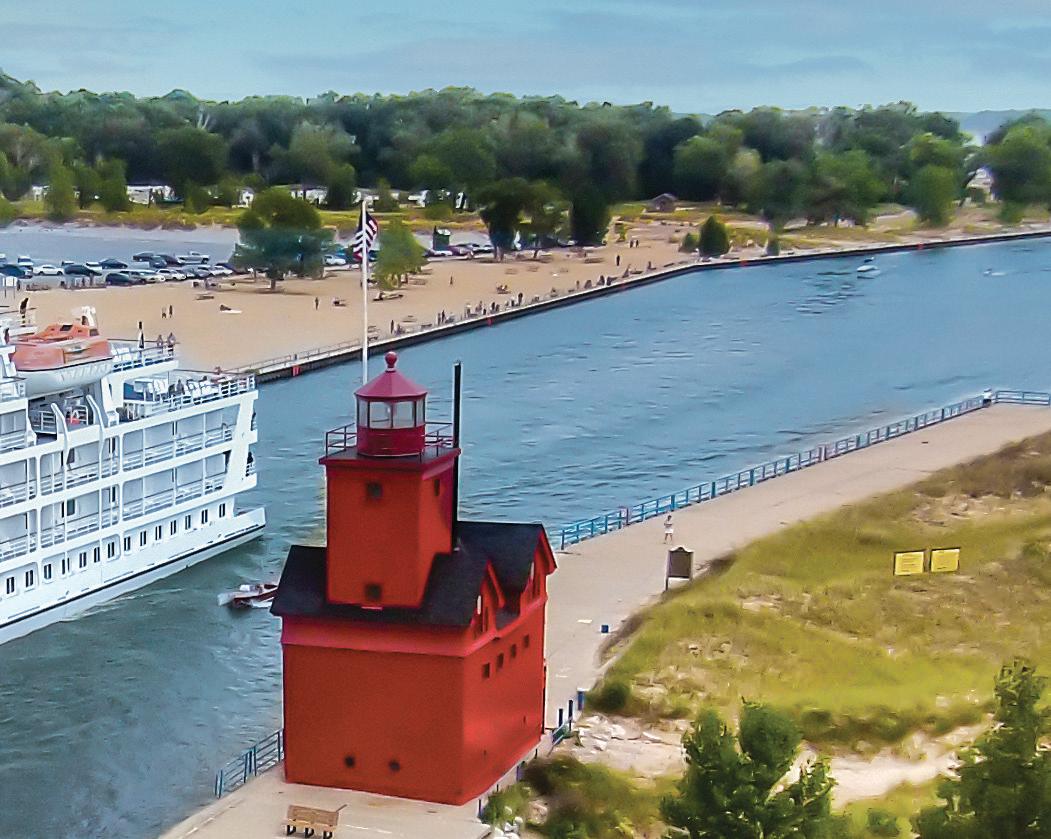






















You may not recognize Peter Kilham’s name, but you probably know his work. There’s a good chance at least one of his creations is in your yard right now.

In his 2018 biography The Perfectionist: Peter Kilham and the Birds, Kilham’s son Larry writes that his father had a passion for inventing. In 1960, after retiring as a design engineer, Kilham cofounded a quirky Rhode Island–based record company, Droll Yankees, which specialized in capturing the voices and tall tales of native New Englanders as well as the sounds of nature, such as birds in the woods near Kilham’s home.

Along the way, Kilham began reflecting on the bird feeder in his yard. A wooden log with drilled holes for holding suet, it was homely and messy, and birds didn’t seem to find it particularly interesting. So he began

brainstorming a model that would be attractive, easy to clean and fill, and able to entice a variety of birds by serving up seed instead of suet.



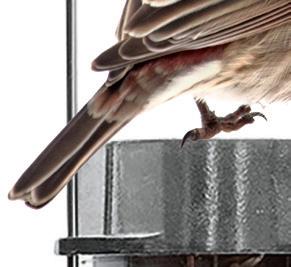

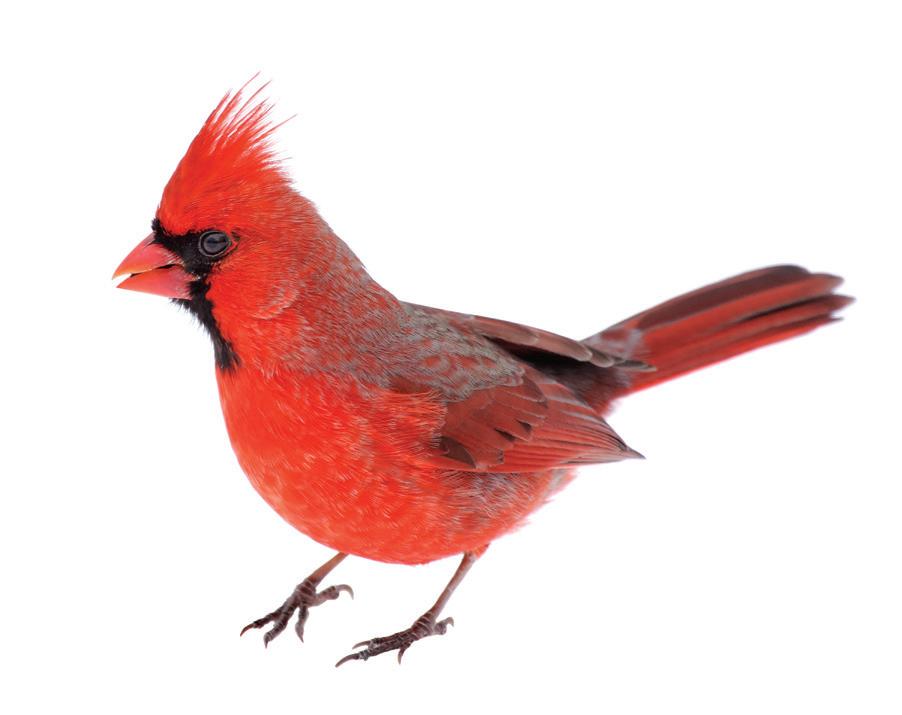
What he came up with was the birding world’s first tube feeder, a style widely used today. Topped with a rugged metal cap to discourage squirrels, it would come to be called the Classic A-6F. It was a hit with both birds and the National Audubon Society, which gave it an enthusiastic endorsement, and before long Droll Yankees was in the bird feeder business.
But Kilham wasn’t done inventing. In addition to designing multiple other feeder styles, he made an accessory that became the A-6F’s ideal companion. After threading an old vinyl record onto the feeder’s cord and seeing how it discouraged pillaging squirrels, Kilham refined his discovery into the now-omnipresent— and endlessly entertaining—squirrel baffle.
Droll Yankees has changed hands several times since Kilham’s death in 1992, and most recently it was acquired by Pennsylvania-based Woodstream. Yet the quality endures, with Droll Yankees still considered the crème de la crème by birds and birders alike. Squirrels, on the other hand, are far less enthusiastic. —Joe Bills
How a Rhode Island tinkerer built a better feeder.
Who says kids should have all the fun? At The Baldwin — an all-new Life Plan Community (CCRC) — we say this is your time. Make a splash in the pool. Dance, stretch, lift, and box in the fitness center. Learn for the love of it. Take to the nearby trails, then top off your day at the local brewery. Define life on your terms and do whatever you choose — whether that’s everything or nothing at all.
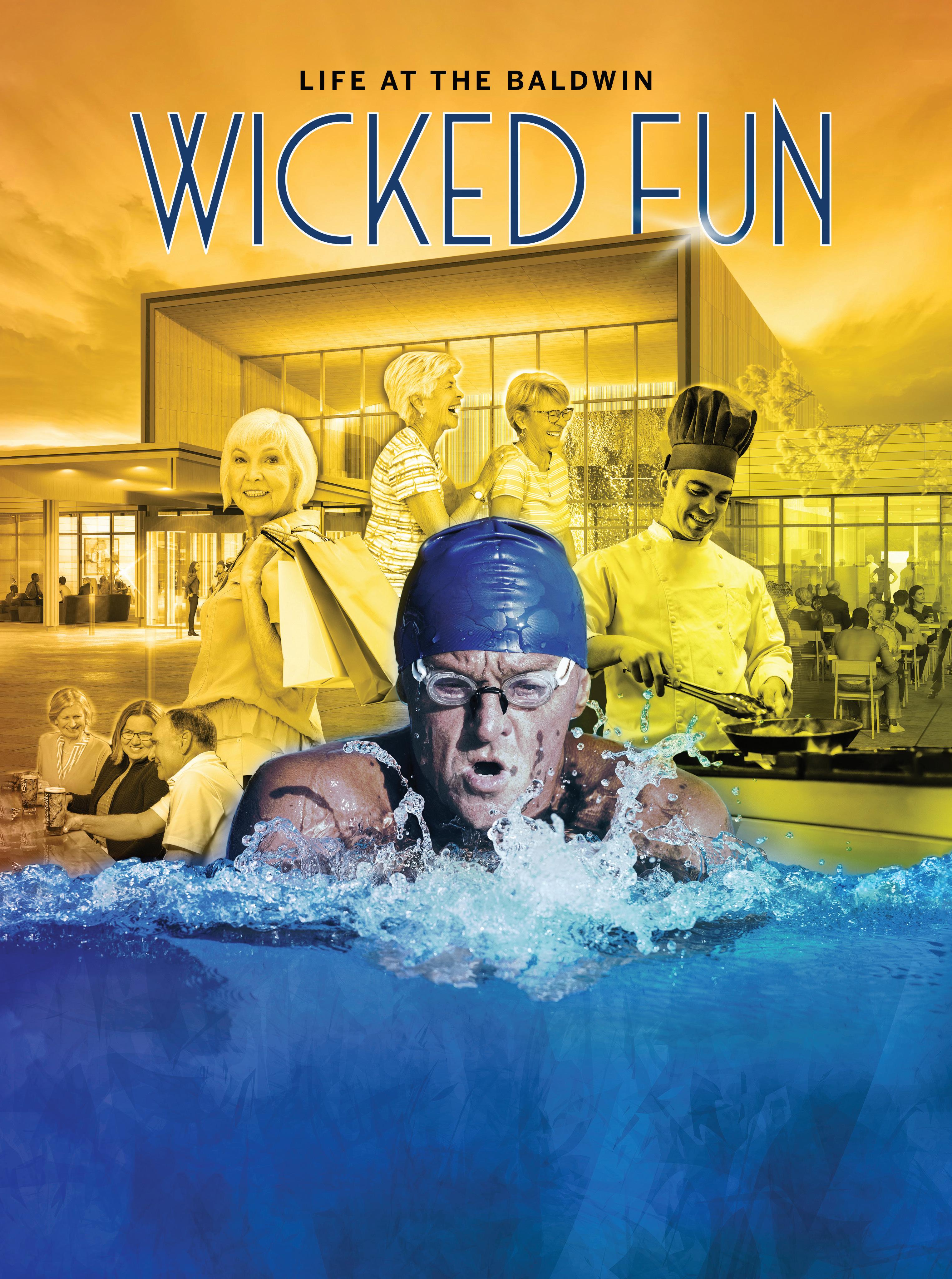

The Baldwin is approaching sold-out status with opening planned for fall 2023. Call 603.404.6080 or visit TheBaldwinNH.org today!

The Baldwin Welcome Center


1E Commons Drive, No. 24 | Londonderry, NH 03053 603.404.6080 | TheBaldwinNH.org

Scan to see the latest construction update video or go to TheBaldwinNH.org/ Construction_Update.

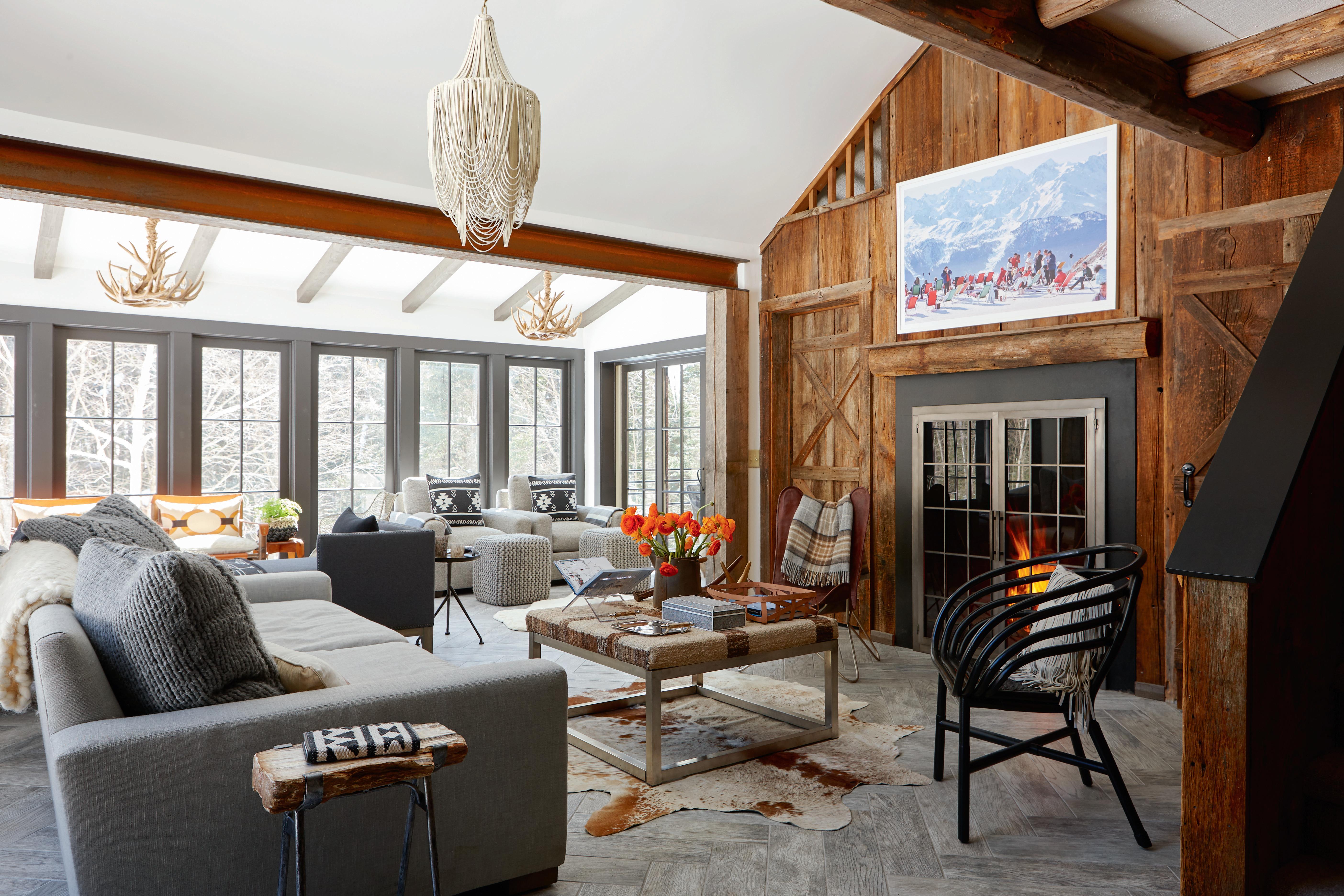
In the living room, a steel beam marks where the footprint of the Ehrlichs’ home was expanded to create a window-filled sunroom they call the “snow globe.” On winter evenings, a fire can always be found roaring behind doors crafted by Stoll Industries. The 100-year-old barnboard adds to the warm feel, as does the handmade leather chandelier, by South Africa’s Ngala Trading. right : Lisa and Randy with their kids, Ella and Daniel, and their dog, Nellie.

 BY LISA GOSSELIN
BY LISA GOSSELIN
On winter afternoons when she is done snowboarding at Mount Snow, her two chil dren are snowmobiling behind the house, and her husband, Randy, is skinning up the hills for an extra workout, Lisa Ehrlich likes to curl up for a moment of quiet in the room she calls the “snow globe.”
Light streams into her Wilmington, Ver mont, ski home through the floor-to-ceiling windows. Off one end of the room, double doors open to a large, covered balcony that looks out over a stand of snow-laden pines.

Inside, deep armchairs are slung with fauxfur and nubbly wool throws. “I have a thing for throws,” Lisa admits with a laugh. Across the room, flames flicker in a fireplace set into

a wall of antique barnboard.
“When we first toured the place and I saw those barnboard walls—some planks are 16 inches or wider—and the fireplace and the hand-hewn beams, I knew we could do some thing with this,” she remembers.
“This” was a house that looked very differ ent from the one where the Ehrlichs now spend their winter weekends. It was an unremarkable 1980s clapboard saltbox set in a subdivision.
“The interior felt small and dark,” Lisa recalls. “But there was that barnboard. And you can’t really see any neighbors.”
The original owner had added barnboard paneling to the walls and rough-hewn beams to the ceiling. Those elements became the theme that Lisa, an interior designer who works with Trovare Home Design of Green wich, Connecticut, riffed upon.

Barnboard is etched with stories of the long
New England winters that build a timeless patina. It is a material that Rob Wadsworth of Vermont Barns and Wadsworth Design/ Build—a firm known for its use of reclaimed materials—works with often. Lisa reached out to the Bondville-based builder and together they completely reimagined the home, dou bling the space and adding on to three sides. “We wanted to keep the original footprint, but we needed more space,” Lisa says.
The “snow globe” sunroom was added off the main living room to bring light in. A garage and small mudroom were attached off the kitchen. The house sits on a hillside, so a lower-level “sports garage” (for the snowmobiles and skis, bikes, and dirt bikes) could be built off the back, accessed from a walkway that leads to the base ment playroom and small office.
far left : A view through the living room to the snow globe, where leather chairs custom-made by Lee Industries invite hanging out with family and friends.
center : Frost Bite by Colorado artist Leslie Le Coq overlooks the banquette that Lisa had custom-built to accommodate greater seating flexibility.
above : The Ehrlichs prefer home-cooked meals, so the compact kitchen gets plenty of use—and space-saving touches, like the pots and pans hung from a beam, are the soul of practicality.

above : The Ehrlichs’ home, nestled in snow. The floor-to-ceiling windows of the snow globe can be seen at far left.
right : In the guest mudroom, which also serves as the main entrance, Lisa designed the penny tile floor to showcase the skiinginspired name of her family’s home, Out of Bounds, with lettering laser-cut by Vermontbased Village Tile.


far right : Another Leslie Le Coq photo, Below Zero, anchors this vignette of pieces carefully sourced to play up the mountainchic vibe. Lisa chose the leather-wrapped console to create a small bar area; two faux-fur stools are tucked underneath to be moved when the family is entertaining and additional seating is called for.
To visually tie the various additions together, Wadsworth clad the entire exterior in reclaimed wood. The effect is a mountain cabin that looks as if it could have weathered hundreds of winters.
Lisa went to work on the interior. She had trained with the acclaimed New York designer Bunny Williams, who’s been called the “doy
enne of livable luxury.” The influence shows in the mix of plush fabrics and textures used throughout. But Lisa tempered it with a color palette drawn from the granite, bark, and loam of the surrounding Vermont woods. “I literally picked up stones to determine some of the col ors,” Lisa says. “I wanted to bring that feeling of nature inside.”
Except for the addition of the “snow globe” room, the basic layout of the main part of the home stayed the same. Lisa gutted the kitchen and rebuilt it with new appliances, cabinets done in a warm gray, and subway tiles. For the dining nook off one side of the kitchen, she found a table and benches of reclaimed wood from West Elm and had a carpenter use the materials from one of the benches to extend the table to form a larger square shape. “We’ve had as many as 15 here for Thanksgiving,” she says.
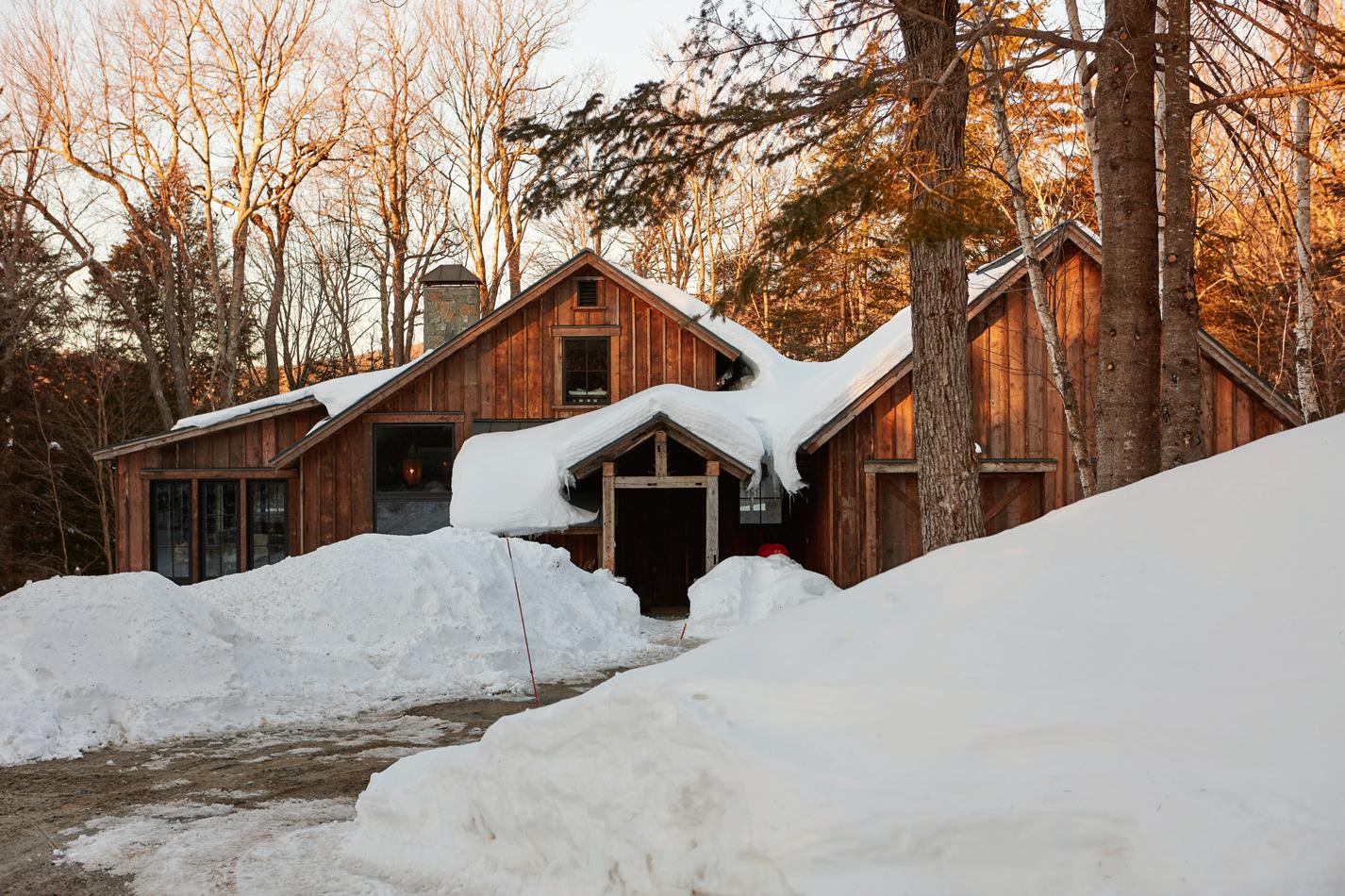
The Ehrlichs love to entertain, and the poufs that are scattered around the living room are just the right height so that they can be pulled up to the table when guests arrive. “We also have the ‘party barn,’” says Lisa as she walks into the garage that connects to the kitchen. With an interior finished in cedar, it can be converted into an additional dining or dancing area.
The master suite sits off the main living room, hidden behind a door in the barnboard

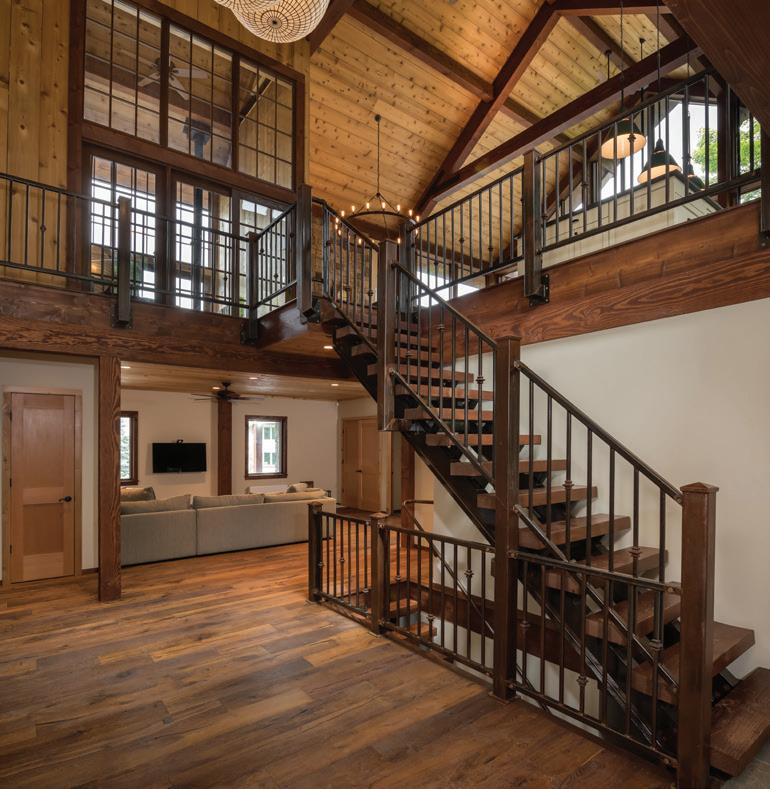


above : In the master suite, acrylic consoles provide tabletop space without overwhelming the small space. The stylishly layered bedding includes Lisa’s favorite coverlet, a brown heathered wool blanket by Libeco.

top right : A view of the Jack-and-Jill bathroom, with its custom-made shower curtain.
bottom right : In a master bath designed to have the feel of a spa, the shower also functions as a steam room, while antler towel hooks provide a casual, rustic touch.

wall. Lisa kept the original narrow farmhouse stairs that lead up to two small bedrooms and a full bath.
“We’re lucky that our two children still share a bedroom,” says Lisa. That allowed her to make the second bedroom a guest bed room for sleepovers with friends. There, Lisa put three single beds with pine frames that she painted a matte black. The two rooms connect to a Jack-and-Jill bathroom.
“This is a weekend ski house and we wanted to have fun with it,” Lisa says. In that bath room, she designed a shower curtain with the black silhouette of a skier. The metal letters “S K I” hang on the wall of the kids’ bedroom next to a metal cabinet with mesh doors that serves as a bureau. The finishing touch Lisa

added was in the entryway, which has the name of the home, “Out of Bounds,” tiled in black on the white floor.
“We had wanted a ski house that was close to the slopes, but not right on them, so we call the house ‘Out of Bounds,’” says Lisa. “It’s also where we come on weekends to get away. Whenever we get up to Vermont, I feel like we leave our other lives behind. We don’t watch TV or spend much time on screens. We just unplug.”

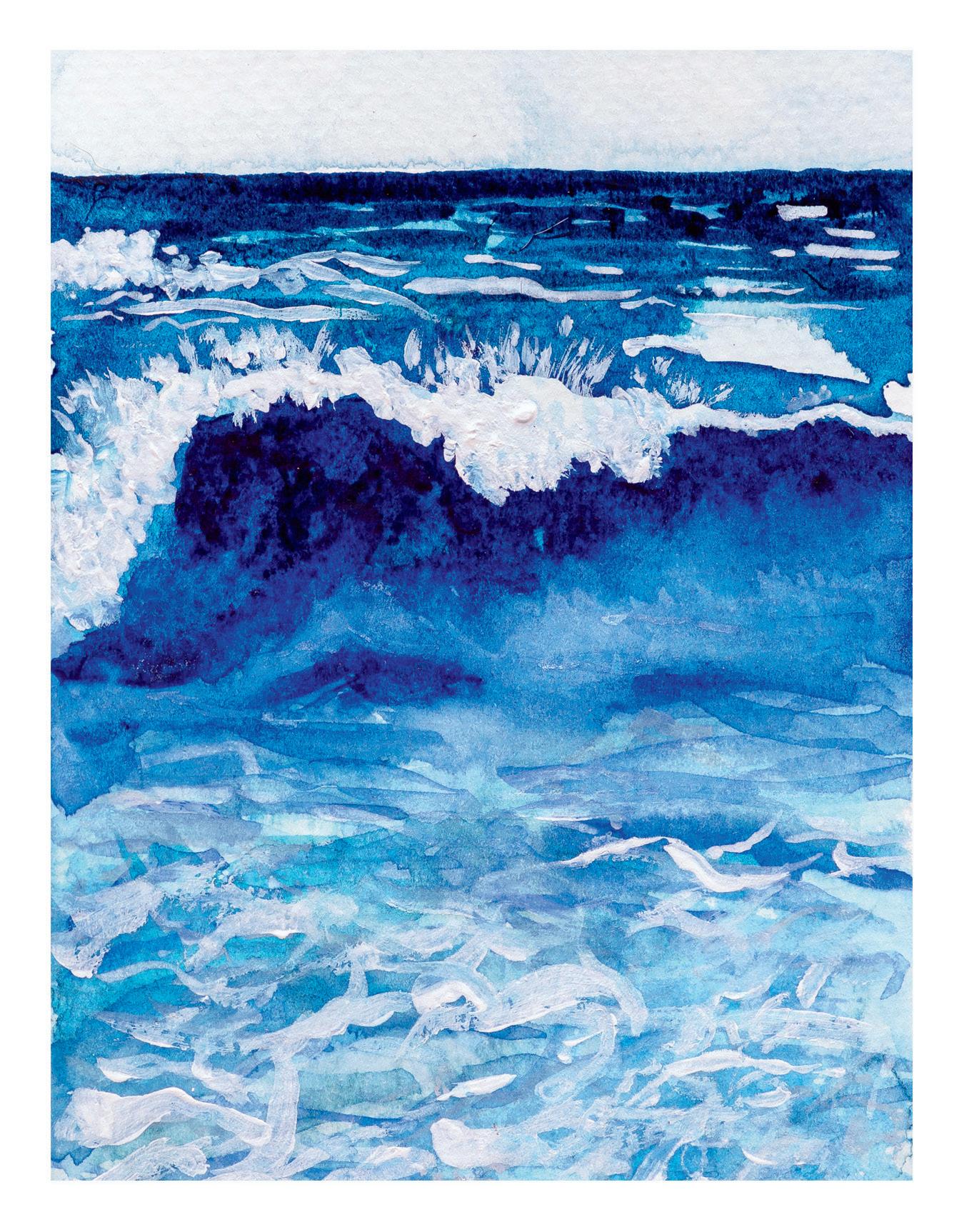 BY ANNIE GRAVES
PHOTOS BY JOSEPH KELLER
BY ANNIE GRAVES
PHOTOS BY JOSEPH KELLER
As a little kid, she went rummaging through antiques stores with her mom, getting a taste for the treasure hunt and the potential lurking in old things. Later, grow ing up, she would help out at her parents’ restau rant in Woburn, Massachusetts, set in an aging mansion—further enhancing her aesthetic and an eye for possibilities. Flash-forward a few decades to married life in England, a career in film and television production, and a subsequent return to the U.S.

“Why are we living in London, so far from the ocean?” Danielle Driscoll remembers her husband, Luke, asking one day. They remedied
COURTESY OF DANIELLE DRISCOLL (PAINTING)that oversight in 2013, buying a century-old gray-shingled gambrel, rugged as a nut, just a few blocks up from Scituate Harbor, a small seaside town on Boston’s South Shore. In the movies, it’s called foreshadowing. In other words, there is every reason why the crisp Atlan tic would feature so prominently in Driscoll’s future artistic life.
This is where Driscoll, 45, polished a life style blog she calls “Finding Silver Pennies,” named for a vintage children’s book her mother had given her. “You must have a silver penny to get into Fairyland,” she reads to me, from the title page. It seems like code for entering
the world of imagination; the blog, she says, unlocked her creativity. While it initially focused on home life—more of a journal—it quickly changed direction a few months later, when she discovered the wonders of milk paint, and its transformative effects on kicked-tothe-curb furniture. Driscoll’s experiences with brushes and paints, and the skills she acquired and subsequently shared in her online DIY and home decor videos, would lead her to try her hand at watercolors.


Specifically, to capture the charms in and around Scituate Harbor, where she and her husband were rehabbing their home. In fact,
far left : Danielle Driscoll recalls painting “Breaking Wave” in spring 2020 partly as a way “to feel calm in a time that felt very uncertain.” The beach, she says, “is my happy place.”
center : Driscoll with her son John in the sunroom/ studio of their Scituate Harbor home. An artist in his own right, John prefers to use a tablet to create his illustrations, while his mother makes this reclaimed table the main workspace for her sketching and painting.
above , from top : A classic New England beach tote filled with a bouquet of hydrangeas is the star of one of Driscoll’s greeting cards, playfully captioned “Thanks a bunch!”; a collection of Driscoll’s art-making tools, ready to fill a blank page with her colorful ideas.

breeze, barely holding on. A sug gestion of seashells, a characterful whale, a fleeting lighthouse, a whiff of mojito caught in a saucy glass. The kind of airy seaside pick-me-up that some of us crave mid-January.
“I love painting the ocean,” she says, simply. “Water, shells, natu ral things. I struggle with structure, buildings, and straight lines.”
The same airy feeling echoes through Driscoll’s sun-washed studio that juts off the side of the main house. The floor is painted white, with a pale blue ceiling. Sketch pads and water colors are scattered over a round work table, and a jar of brushes sits handy; the water holder is a small French yogurt pot. Hydrangeas lounge in a
top : A sampling of Driscoll’s work, including some of her newest offerings, stickers. “I’m so glad they’ve made a comeback!” she says. above : Driscoll’s love of the ocean is echoed but expressed in an entirely different way in John’s Ink Harbour Illustrations designs.


dangling wall basket; beach stones sit on the windowsills, soaking up the sun. It’s like a painting spa.
“Watching the watery paint on the paper is mesmerizing,” says Driscoll. “Like a meditation.” She’ll use both wet and dry watercolor techniques to cre ate her ocean seascapes, lighthouses, seashells, sometimes adding swipes of acrylic after.
But the other inspiration for Driscoll resides not down the street, where masts bob in the harbor and seagulls hunker on salt-soaked piers— it’s right here, at home. “Family plays such a big role in my creativity,” she says. She collaborates in an online shop with her 16-year-old son, John, who is “super-artistic,” and prefers to draw on a tablet and paint with acrylics to cre ate his own beachy graphics under the moniker Ink Harbour Illustrations. Her younger son, Conor, 13, helps pack cards (although Driscoll oversees all shipments—her “type A personality,” she says). And Luke, a software engi neer who loves woodworking, just fin ished making a fleet of wooden stands to accompany the 2023 calendars.
We’re thumbing through a rack of greeting cards—a mix of hers and John’s—in the “packing” area, upstairs. Stacks of 2023 calendars have just arrived. Mother and son donate a por tion of every sale to the World Wild life Fund. On the horizon, Driscoll is planning a line of fabrics and wall paper. “I don’t know why at a certain point people are taught not to be cre ative,” she muses, as we’re looking at the note cards. “But that’s why I share the tutorials.”
And it occurs to me that quite possi bly the renaissance women of the pres ent day must have wide expertise in a range of skills. Where blogging leads to DIY, which leads to light-filled water colors, and then comes full circle, with tutorials where she passes along every thing she’s learned. “The first water color class I ever took, I wanted to cry,” says Driscoll. And she smiles. “Then I got better.” findingsilverpennies.com
Finding a home at Taylor means more than access to a stunning n

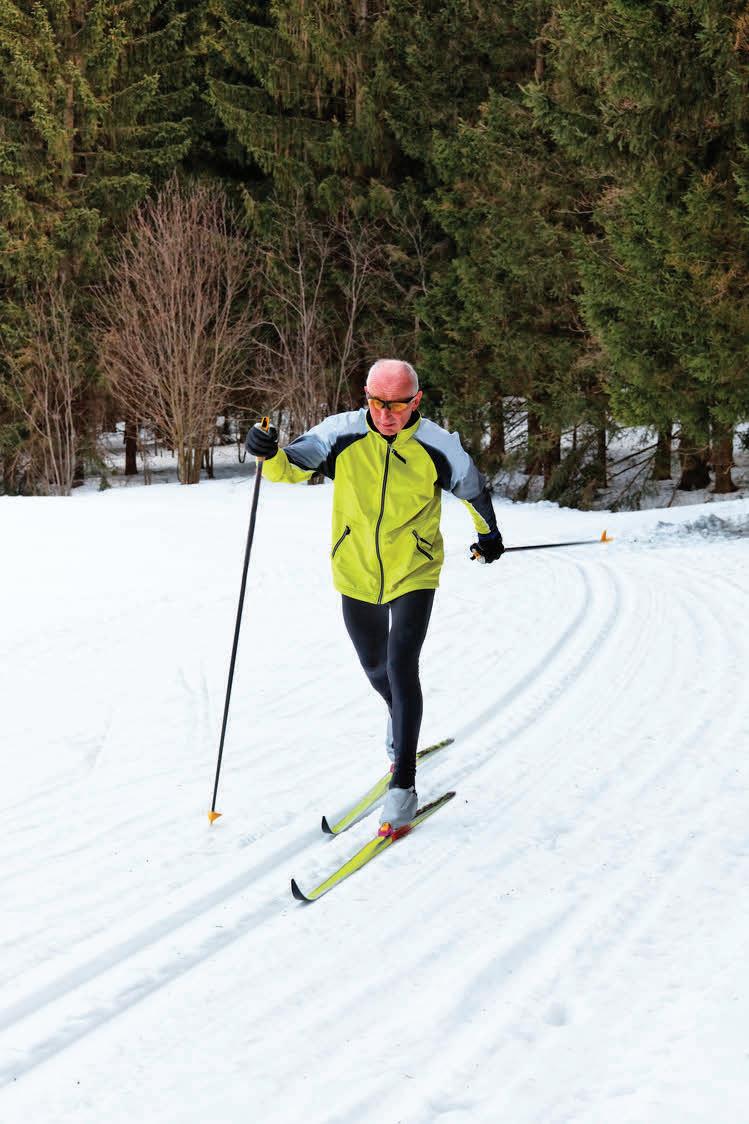






New England’s appeal as a retirement destination may not be as obvious compared with other parts of the country—but when you stop and consider all that this region has to o er, why would you retire anywhere else? e same natural beauty, rich history, and cultural vitality that make New England a favorite travel destination also make it a great place to retire.
Picturesque coastlines, pristine lakes, rugged mountains, world-famous fall foliage, small-town charm, big-city sophistication, and vibrant culture— these are just a few of the features of living in New England that make it

an increasingly popular choice for those looking to retire. And there are more practical considerations, too, including close proximity to Boston and New York, access to world-class healthcare, and the lowest crime rate in the country (all six New England states are among the 10 safest in the nation, according to a recent ranking by U.S. News & World Report).

For outdoor enthusiasts, New England’s geographic diversity is unparalleled. No matter where you decide to settle, you’ll be within an easy drive of year-round adventures at beaches, lakes, and mountains. New England’s 6,000-plus miles of

coastline invites endless exploration (and along the way you’ll enjoy some of the freshest seafood you’ve ever had). ese iconic waters are a sailor’s dream for “gunkholing”—nautical speak for meandering by boat—along the coast from Mount Desert Island to Cape Cod, Narragansett Bay, Block Island, and beyond. On land, hunt for shells and sea glass and look for wildlife during a walk along rocky tidal shores, or lounge under an umbrella on wide, sandy beaches. Even better, the New England coast is punctuated by nearly 200 lighthouses, with many of these historic beauties open to the public and all with a unique story to tell.
Venture inland, and you’ll discover rolling hills, crystal-clear lakes, and majestic mountains that provide a playground for hiking, swimming, shing, camping, and mountain biking. ere are rivers with tranquil
pools for shing and long, gentle stretches for kayaking and canoeing; plus, thrill seekers can nd all classes of rapids for whitewater ra ing. Summer in New England is a magical time to be outdoors—but so is fall, when recreation takes place against a backdrop of brilliant reds, yellows, and oranges. And when winter snow arrives, the countryside invites snowshoeing and Nordic skiing, while downhill types can choose from 60-plus ski mountains that together o er an impressive variety of terrain, from wide, sunny slopes to steep vertical drops.
Retirees can also reap the bene ts of living in a land of “thinkers.” While Boston may be New England’s bestknown college town (think Harvard and MIT), each of the six states has a handful of cities and towns anchored by historic colleges and universities, including Burlington,


To
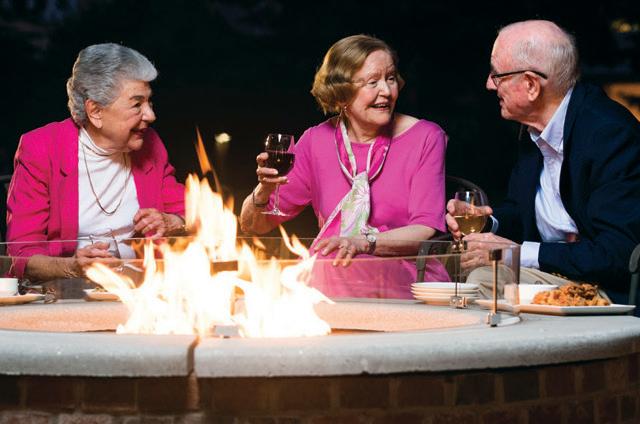
Quarry Hill offers adults 55+ a gracious, maintenance-free home with easy one-floor living, plus priority access to the fullest spectrum of care.


Quarry Hill offers it all: a gracious, maintenance-free home with easy one-floor living, plus priority access to the fullest spectrum of care.
Quarry Hill offers it all: a gracious, maintenance-free home with easy one-floor living, plus priority access to the fullest spectrum of care.
Quarry Hill offers it all: a gracious, maintenance-free home with easy one-floor living, plus priority access to the fullest spectrum of care.
Quarry Hill offers it all: a gracious, maintenance-free home with easy one-floor living, plus priority access to the fullest spectrum of care.
Enjoy all the beauty and cultural sophistication of Camden, Maine, and discover your best future.

Enjoy all the beauty and cultural sophistication of Camden, Maine, and discover your best future.
Enjoy all the beauty and cultural sophistication of Camden, Maine, and discover your best future.
Enjoy all the beauty and cultural sophistication of Camden, Maine, and discover your best future.
Enjoy all the beauty and cultural sophistication of Camden, Maine, and discover your best future.
For Adults 55+
For Adults 55+
For
For Adults 55+

Pen Bay Medical Center | A MaineHealth Member 207-301-6116 | quarryhill.org


Pen Bay Medical Center | A MaineHealth Member 207-301-6116 | quarryhill.org


Pen Bay Medical Center | A MaineHealth Member 207-301-6116 | quarryhill.org
Pen Bay Medical Center | A MaineHealth Member 207-301-6116 | quarryhill.org
Pen Bay Medical Center | A MaineHealth Member 207-301-6116 | quarryhill.org
Vermont; Hanover, New Hampshire; Providence, Rhode Island; and Brunswick, Maine. ese places provide not only a youthful energy, but also the opportunity for residents to stay intellectually sharp via continuing education programs.







Arts and culture have an equally long and prestigious history in New England. Artists such as Andrew Wyeth, Edward Hopper, and Winslow Homer immortalized the region’s landscapes and seascapes, while Norman Rockwell depicted the

enduring appeal of small-town New England life in many of his illustrations. ese and many other artists helped inspire New England’s world-class collection of museums, from the Farnsworth in Rockland, Maine, to the Isabella Stewart Gardner Museum and the MFA in Boston.

Where arts and culture ourish, dining and shopping follow. New England’s four-season climate means there is a strong emphasis on everchanging local bounty at the region’s many award-winning restaurants. Local avor also de nes the tone at shops and boutiques selling inspired, one-of-a-kind items in quaint, walkable downtowns.
Few regions in the world can approach the variety of all New England has to o er in such a relatively small geographic area. From picturesque small towns to bustling cities, New England o ers a vision of retirement that is as authentic as it is appealing.

Few regions in the world can approach the variety of all New England has to o er.


In midcoast Maine, melty cheese known as raclette is at the heart of a simple, cozy meal.
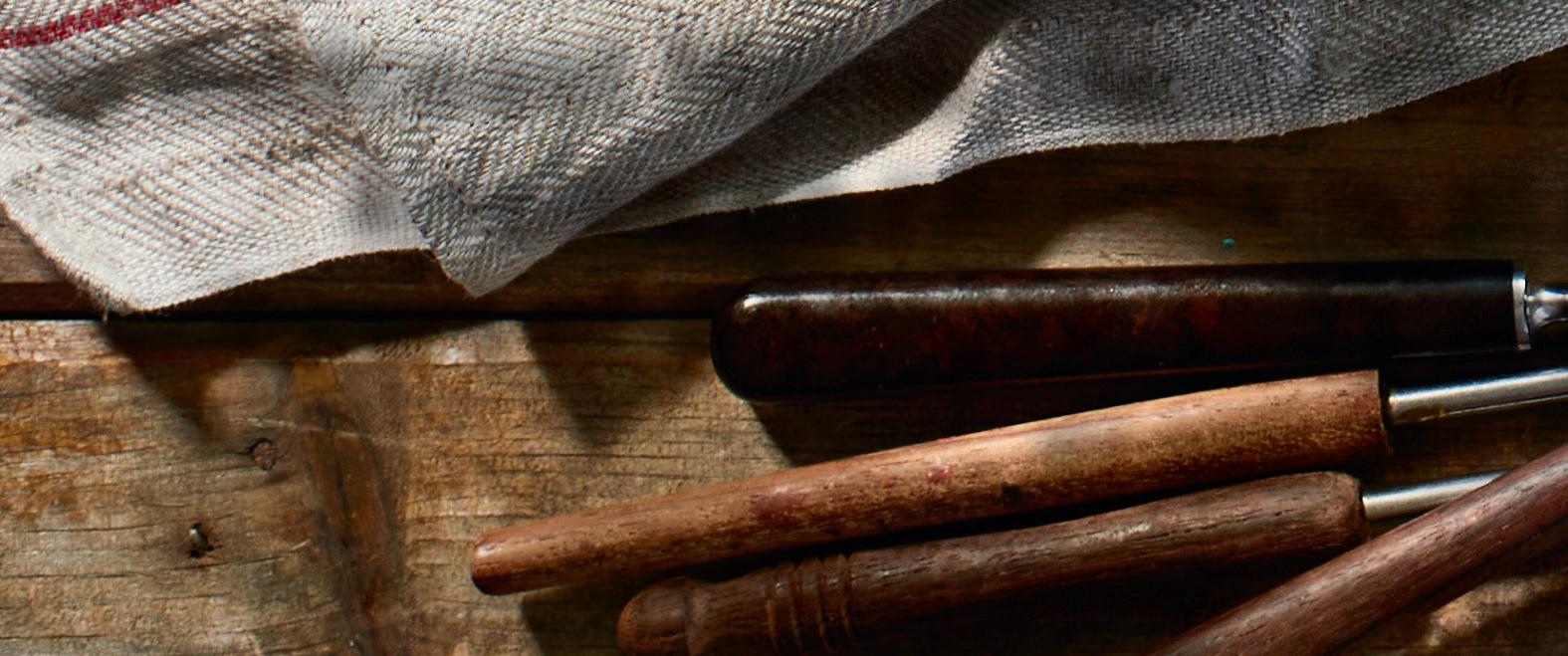

 BY AMY TRAVERSO
BY AMY TRAVERSO
Roasted

On a dead-of-winter night in mid coast Maine after a full day of skiing, I walked across a snowcrusted field to a barn glowing with warm light and the promise of the ultimate après-ski meal. Outside, guests were cozying up to a trio of firepits, clutching mugs of Aquavit toddies, downing local oys ters, and looking up at a full moon. Inside, staff were attending to the finishing touches, lay ing out sheepskins and wool blankets, lighting candles, and setting out Mason jars of home made pickles.
Sarah Pike, the owner of this barn and the land on which it stands, Tops’l Farm, surveyed the scene with a mostly calm eye. This was
the 16th dinner she had hosted that winter, but there were still dozens of mouths to feed. It was all part of Tops’l Farm’s larger mission to welcome visitors to Waldoboro for glamp ing vacations, farm programs and classes, and year-round feasts.
This meal was centered around raclette, the classic French and Swiss Alpine cheese known for its great melting properties. It’s typically heated with a type of electric grill, scraped off onto plates, and served with generous mounds of boiled potatoes, cured meats, vegetables, crusty bread, and pickles. Pike’s approach, adapted for pandemic safety, is to give each table its own individual raclette spread. “Much like most everything here at the farm, it’s an
Recipes from the
Tops’l Farm in Waldoboro, Maine, include Winter Beet & Citrus Salad ( above ) and Sweet-and-Sour Pork Skewers ( right). The accompanying raclette recipe works beautifully with a number of New England–made cheeses, such as “Whitney” ( top right), a buttery-smooth mountain-style cheese by Vermont’s own Jasper Hill Farm. Recipes begin on p. 100.





















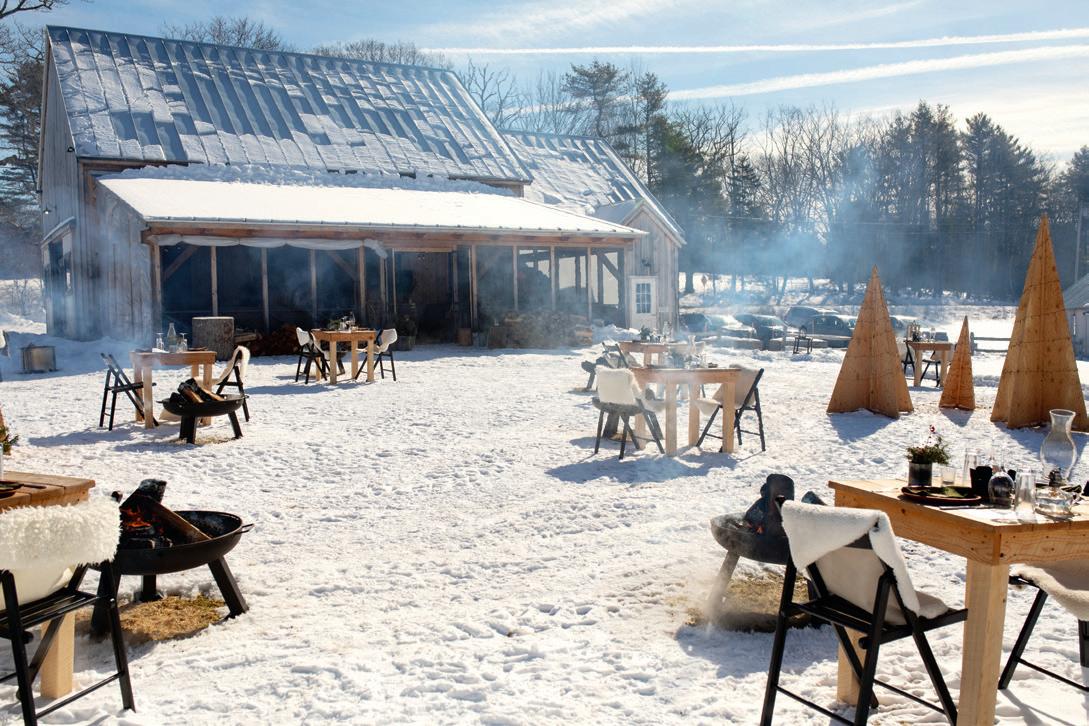










expression of a lot of different life experiences,” she says.
Tonight, that inspiration came from a meal that she and her husband, Josh, had enjoyed at a Swiss restaurant called Waldhüttli (Forest Hut). “It was a 20-minute hike up into the Alps,” Pike says. “We weren’t sure whether we were on the right path, but it was one of the most magical meals of my life, in a little log cabin off the grid with a big bonfire out front. The chef came out wearing an L.L. Bean hat, and I knew I was at the right spot.”
Inside the barn, we melted slices
of raclette on a tabletop griddle and piled our plates with bread, vegetables, pickles, and meats. It wasn’t the Alps, but with a glass of local cider to wash it down, it was a perfect meal.
The raclette dinner series takes place all winter at Tops’l Farm. But if you can’t make it to Maine, Pike’s team shared their recipes for the winter salad, grilled pork skewers, and raclette (adapted for standard kitchen equipment). To finish: a butterscotch pudding recipe from Pike’s grandmother, Mom-Anne.










recipes, see p. 100)

Angel with a Golden Halo Blue Sapphire & Diamond Ring G3661...$2,950
Newcastle Seaside Blue Sapphire & Diamond Ring G3925...$6,350
Essex Blue Sapphire & Diamond Ring G4046...$9,950

The color blue is good for all of us. It is the color of health and happiness. Blue is the color of calm. Blue is our sanctuary of serenity.
We at Cross love blue and believe in all things blue. We live on a 3,500 mile coastline of blue ocean and blue skies, we think our proximity to the sea deepens our passion for great, awesome and incredible shades of blue. We search the world for the best blue sapphires, pure, true, bright, brilliant; then design our sapphires into our favorite jewelry designs. Its a longer process to build our own sapphire collection...it’s worth it though because we can have the shades of blue we and you truly love.

Anything you purchase comes with our Ninety day full return/exchange privileges. Ninety days takes the pressure off, makes shopping easy. We wish everyone did something like this, it would be a kinder, gentler world. We look forward to hearing from you.
Click & Buy or Click & Call. You may click and buy anytime. Our showroom is still closed to the public. Half our team is working remotely, the other half is safely distanced and working on shipping. You can Click & Buy 24/7 or we are taking calls Monday-Friday 9:30 AM-5PM our staff all speak New England and we will be shipping Monday-Friday all across the USA.
Two crowd-pleasing appetizers to warm up the home team.
 BY AMY TRAVERSO
STYLED AND PHOTOGRAPHED BY LIZ NEILY
BY AMY TRAVERSO
STYLED AND PHOTOGRAPHED BY LIZ NEILY
or all the talk of postholiday New Year’s reso lutions and detoxes, by Super Bowl Sunday (February 12 this year) it all goes out the window in favor of chips, dips, and wings. And we are here to meet you in that truth.
To start: an ultra-creamy hot spin ach and artichoke dip nestled under a bubbling crust of mozzarella and Parmesan. We’re not breaking new ground here, but this version is nota bly delicious and packed with as many veggies as possible without losing the ooey-gooey factor.
Next, a New Englander’s take on hot wings (hint: there’s maple syrup in it). The chicken wings are tossed in salt, pepper, and garlic powder to boost their flavor, then basted with sriracha, maple, and soy sauce. Use as much or as little sriracha as you can handle (we preferred the full four tablespoons).

Butter, for greasing pan
3 10-ounce packages frozen spinach, thawed and drained
3 tablespoons olive oil
3 large garlic cloves, minced
2 14-ounce cans artichoke hearts, drained and roughly chopped
1 8-ounce package cream cheese, cut into medium cubes
1 cup sour cream

½ cup mayonnaise
¾ cup grated mozzarella cheese, plus more for the topping
½ cup grated Parmesan (or Romano) cheese, plus more for topping
2½ teaspoons kosher salt
1 teaspoon red chili flakes
Tortilla chips, for serving
Preheat oven to 375 °F and set a rack to the middle position. Grease a 9-by13-inch baking dish (or two smaller dishes or skillets). Set aside.
Squeeze out as much liquid as you can from the thawed spinach. Set aside.
In a large skillet over medium heat, warm the oil, then add the garlic and cook, stirring, until translucent. Add the spinach and artichokes, and stir to combine. Reduce heat to mediumlow and add the cream cheese, sour cream, mayonnaise, mozzarella, Par mesan, salt, and chili flakes. Stir with a spatula until the mixture is smooth
and creamy. Transfer to the prepared baking dish, sprinkle with extra moz zarella and Parmesan, and bake until golden and bubbly, about 25 minutes. Yields 8 to 10 servings.

FOR THE CHICKEN
2 teaspoons kosher salt
1 teaspoon freshly ground black pepper
1 teaspoon garlic powder
2 pounds chicken wings and drumettes, patted dry
Chopped cilantro, for garnish
FOR THE GLAZE
¼ cup maple syrup
2–4 tablespoons sriracha
1 tablespoon soy sauce
Prepare the wings: In a small bowl, stir together the salt, pepper, and
garlic powder. In a large bowl, toss the chicken with this spice mixture. Refrigerate for 30 minutes and up to 24 hours (cover bowl if refrigerating for more than 30 minutes).
Preheat oven to 425 °F and set a rack to the upper-third position. Line a rimmed baking sheet with parchment paper or aluminum foil. Set aside.
Make the glaze: In a small bowl, whisk together the maple syrup, srira cha, and soy sauce.
Arrange the wings in a single layer on the prepared baking sheet. Set on the upper third rack and bake for 30 minutes, turning halfway through. After 30 minutes, brush the top of the wings with the glaze. Return to oven for 7 minutes. Now turn the wings over and brush the other side with the glaze. Return to oven and cook until nicely browned, 5 to 7 more minutes. Sprinkle with cilantro and serve hot. Yields 4 to 6 servings.
The Jitterbug® Smart3 is our simplest smartphone ever, with a list-based menu, large screen and new Health & Safety Packages available.
EASY Everything you want to do, from calling and video chatting with family, to sharing photos and getting directions, is organized in a single list on one screen with large, legible letters. Plus, voice typing makes writing emails and texts effortless.















SMART In emergencies big or small, tap the Lively Urgent Response button to be connected to a certified Agent who will get you the help you need, 24/7.
AFFORDABLE Lively® has affordable value plans as low as $14 99 a month or Unlimited Talk & Text plans only $1999 a month. Choose the plan that works best for you, then add your required data plan for as low as $249 per month2.
150% off regular price of $149 99 is only valid for new lines of service. Offer valid through 1/2/23 at Best Buy and Amazon. 2Monthly fees do not include government taxes or assessment surcharges and are subject to change. A data plan is required for the Jitterbug Smart3. Plans and services may require purchase of a Lively device and a one-time setup fee of $35. Urgent Response or 9-1-1 calls can be made only when cellular service is available. Urgent Response service tracks an approximate location of the device when the device is turned on and connected to the network. Lively does not guarantee an exact location. Urgent Response is only available with the purchase of a Health & Safety Package. Consistently rated the most reliable network and best overall network performance in the country by IHS Markit’s RootScore Reports. LIVELY and JITTERBUG are trademarks of Best Buy and its affiliated companies. ©2022 Best Buy. All rights reserved.




opposite , clockwise from top left : Firepits in the historic center of Québec City help keep visitors cozy; traditional poutine at La Souche; a snowy scene in the Old Québec district; zipping down an ice slide during the city’s annual Winter Carnival.
this page : Looking toward the grand hotel Fairmont Le Château Frontenac from the ramparts of Old Québec.

T 6 A.M. on this February day*, the city still sleeps as the icebreaker is about to leave the dock to cross the St. Lawrence River. The ferry needs only a few minutes to reach Québec City from neighbor ing Lévis, a journey I have made for 20 years while observing through the lens of my cam era. It’s always the same sense of wonder I feel when I hear the echo of cracking ice get lost in the infinity of the river, my eyes riveted on the towering Château Frontenac, one of the world’s most-photographed hotels. This morn ing, winter envelops the city, and once again time freezes. In just a few hours, about a foot of snow has fallen on the stones and bricks of Qué bec City, nicknamed “the Old Capital.” Coat, boots, gloves, toque—it’s time for a walk inside the city’s historic ramparts. At this time of day, only tourists can be seen wandering through the maze of narrow streets, as city residents armed with shovels are busy freeing their cars from huge mounds of snow.
All is white. All is quiet. Only the sound of one’s own footsteps in the snow disturbs this silence, but it also adds to the magic of


the moment. On narrow rue Couillard, the door of the café Chez Temporel opens, releas ing a warm aroma of coffee and croissants. I enter. It’s a place full of history, where the old stone walls have witnessed the work of the great Québec writers who congregated here. Warmed up, I continue my stroll to the Duf ferin Terrace, a long wooden belvedere at the foot of the Château Frontenac from which the view of the river and the Basse-Ville (Lower Town) district is unique.
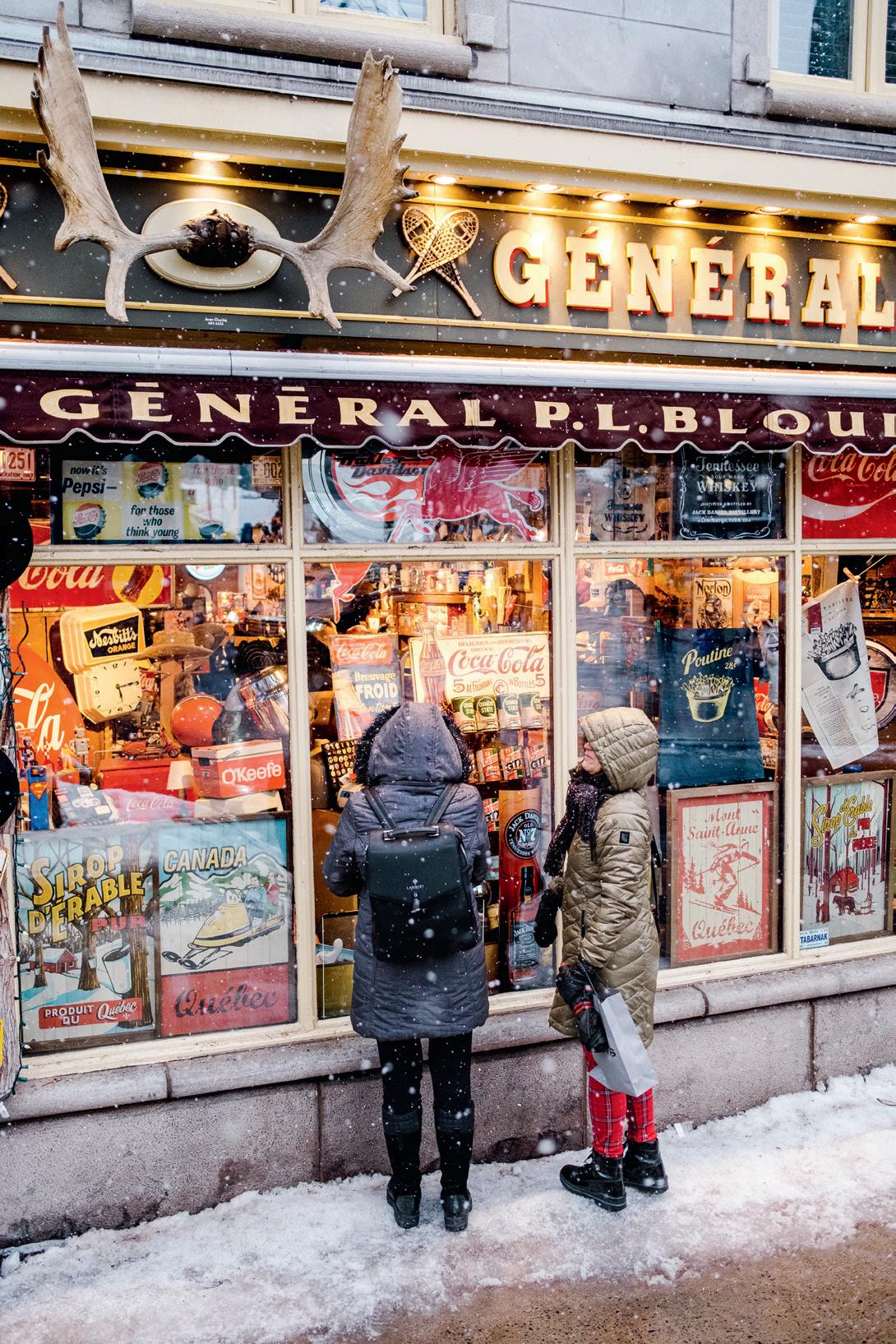
Now, already noon. I hear shouts of joy from those who are sliding down the big toboggan chutes that have been one of the most popular attractions here for more than a century—1884, to be exact. From mid-December to midMarch, young and old enjoy this mammoth structure on the terrace, winter after winter, with the magnificent view of the river as the backdrop. And everywhere there is a thrill of


Chez Temporel: Since 1974, locals and visitors have come in from the cold to warm up with coffee, croissants, and local specialties at this Haute-Ville (Upper Town) favorite, while watching the stream of passersby just beyond the picture windows. cheztemporel.com
Chez Rioux & Pettigrew: In the city’s atmospheric Old Port neighborhood, foodies come here for the chef’s secret four-course prix fixe menu, while music playing on a vintage record player amplifies a timeless sense of place. chezriouxetpettigrew.com
Le Don: Québec City’s only vegan restaurant is also one of its most popular. It’s not unusual to see the same travelers returning to eat here day after day. donresto.com
Tanière³: This highend, special-occasion restaurant in a 17thcentury underground vault offers one of the most unforgettable settings you could wish for. taniere3.com/en
Le Clan: Stéphane Modat, one of Québec’s most famous chefs, opened his new eatery on an Old Québec side street. Modat’s creations are partly inspired by his time with First Nations peoples. restaurant leclan.com
Paillard: This café and bakery opens every day at 7 a.m., and its tables fill early because of its excellent breakfast sandwiches and hot drinks. paillard.ca
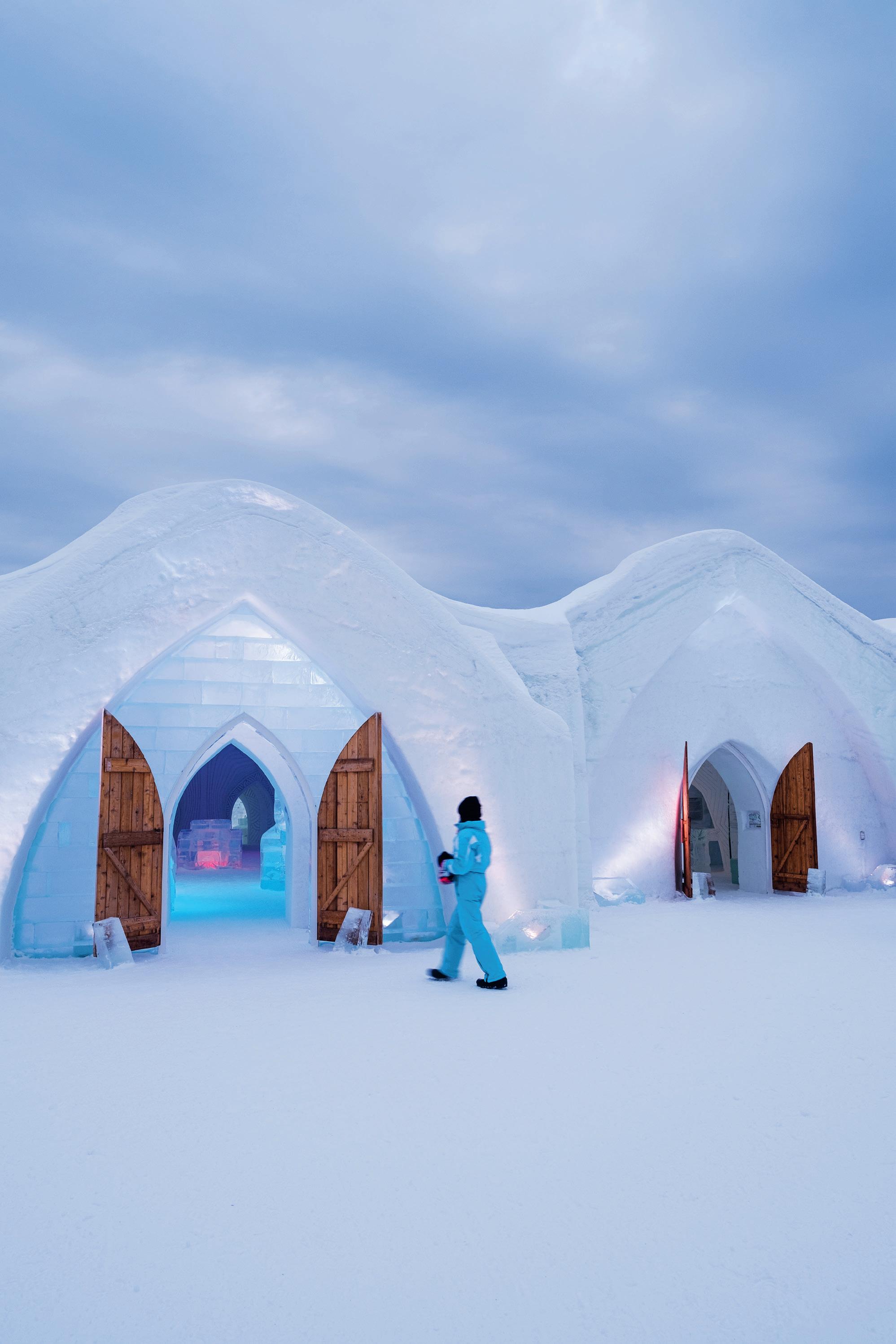
discovery: climbing the city ramparts, walking around the almost mythical rue Saint-Louis and rue Saint-Jean, wandering from one store to another, strolling by a fire in the Place d’Youville, heading out to play at the Winter Carnival, one of the largest and oldest events of its kind, which now is in full swing.
As the afternoon passes, snow begins to fall again. I make a last stop on the road at the Magasin Général, a legendary general store founded in 1866, before exploring the historic shopping district Petit-Champlain, in Old Québec’s Lower Town.
The Lower Town welcomes more and more tourists every year, especially in the vibrant Limoilou neighborhood. You have to check out Article 721, a little Ali Baba cave of treasures from local artisans. Around it you will find a restaurant, café, bar. The terrace of the bar Le Bal du Lézard is closed in this season, but this makes the interior all the more welcoming.
You still have to cross the river, this time via bridge to the island called Île d’Orléans. It is by stepping back that one can fully appreciate things: At the tip, in the quaint community of
Le Chic Shack: A comfort-food oasis in Québec’s Place d’Armes serving burgers, poutine, and shakes, nearly all created with local ingredients. lechicshack.ca/en
At one of Québec City’s most famous landmarks, luxury comes with stunning views of the Dufferin Terrace and the St. Lawrence River. fairmont .com/frontenac-quebec
Auberge SaintPosh accommodations combine with city history, as artifacts from an on-site archaeological dig are displayed throughout the hotel. A two-minute walk brings you to the Museum of Civilization and popular boutiques in the Petit-Champlain district. saint-antoine.com
Hôtel Le Priori: Located on a pretty pedestrian street in a building that dates back to 1734, Le Priori is a cozy and plush boutique hotel, with an interior design featuring brick and stone walls, plus gourmet breakfast. hotellepriori.com/en
Magasin Général: An old-fashioned country store that has long been a local landmark, it’s the kind of place you enter thinking you’ll stop for a few minutes—then you souvenir-hunt for an hour. Facebook
Article 721: Artisanal gifts from some 60 Québec makers, along with vintage finds, fill this beguiling shop in the


Today, cell phones are hard to hear, difficult to dial and overloaded with features you may never use. That’s not the case with the Jitterbug® Flip2, from the makers of the original easy-to-use cell phone.

EASY TO USE A large screen, big buttons, list-based menu and one-touch speed dialing make calling and texting easy. The powerful speaker ensures conversations are loud and clear.
EASY TO ENJOY A built-in camera makes it easy to capture and share your favorite memories, and a reading magnifier and flashlight help you see in dimly lit areas. The long-lasting battery and coverage powered by the nation’s most reliable wireless network help you stay connected longer.

EASY TO BE PREPARED Life has a way of being unpredictable, but you can press the Urgent Response button and be connected with a certified Urgent Response Agent who will confirm your location, assess the situation and get you the help you need, 24/7.
EASY TO AFFORD The Jitterbug Flip2 is one of the most affordable cell phones on the market with plans as low as $1499/mo. or Unlimited Talk & Text for only $1999/mo. And with no long-term contracts or cancellation fees, you can switch plans anytime. Plus, ask about our new Health & Safety Packages.
125% off $9999 regular price is only valid for new lines of service. Valid through 12/31/22 at Rite Aid and Walgreens and 1/2/23 at Best

directors of the famous Disney movie Just a 20-minute drive or public shuttle from the city center, it is a dreamlike place, a world of ice and snow. Built with more than 2,000 blocks of ice and tons of snow, it is the only ice hotel in North America, where every year engineers and artists reinvent its theme and spaces.
A view across the frozen St. Lawrence River from Île d’Orléans. Freshwater for much of its length, the St. Lawrence freezes during the winter months, providing visitors the chance to walk out onto its icy expanse.

In Wendake, the Huron-Wendat Nation res ervation located 15 minutes from the city, visi tors are greeted with open arms at the HuronWendat Museum and Huron Traditional Site. A stay in Québec City would be incomplete without a visit to this site of great richness, which allows us to understand the past, the his tory of the territory that welcomes us.
Limoilou neighborhood. article721.com
Benjo: Amid electric trains, stuffed animals, and a dozen special toy departments, winter visitors young and old will warm up quickly at this 25,000-square-foot destination toy store. benjo.ca/en
Rue du PetitChamplain: One of the most inviting window-shopping streets anywhere, this cobblestoned walkway lined with boutiques is considered the oldest commercial street in North America. quebeccite.com/en/old-quebeccity/petit-champlain
Hôtel de Glace: You can spend a bundledup overnight here, sleeping in a bed carved from ice, but simply touring this architectural wonder will give you chills of amazement. valcartier.com/en/ accommodations/hotelde-glace-ice-hotel
Wendake: A step back in time 15 minutes outside the city, where you immerse yourself in the First Nations culture and experience, complete with galleries and crafts that honor ancient traditions. tourismewendake.ca/en
Dufferin Terrace and Toboggan Run: Enjoy the thrill of strolling the famous promenade overlooking the river, then speeding down the slide. This signature Québec City winter experience ends with a warm-up snack at the kiosk next to the Château Frontenac. au1884.ca/en
It’s complicated.
Here’s some advice from a licensed therapist.
Whether you’re experiencing symptoms of anxiety or depression, feeling burned out at work, or navigating relationship challenges, therapy can be an effective tool for building resilience and improving your mental health. But finding therapy that works for your schedule, budget, and goals can be challenging. Here are some pointers to make therapy less daunting, and help you get the care you’re looking for:

1. Understand that therapy can be for anyone. Therapy isn’t only for people who have been diagnosed with a severe mental health issue. Mental health is for everyone. Therapy can be beneficial even if you just need someone to talk to.
2. Be kind to yourself — seeking therapy is a sign of strength, not of weakness. Free yourself from the stigma that can be associated with seeking mental health care. Starting therapy is a sign that you’re taking ownership of your narrative, and prioritizing your mental health. It takes a lot of bravery, and it’s something to be proud of.
3. Stay open to different specialties. There are a lot of different licenses in the mental health profession — from psychologists to social workers — but the most important thing is finding a therapist that you feel safe with. Make that a focus of your search.
4. Think about whether you’d prefer to do therapy in-person or virtually. Virtual therapy can be done from home, offers a much wider selection of providers, and is often more affordable. BetterHelp, for example, has a network of over 25,000 licensed therapists and costs between $60-$90 a week. On the other hand, in-person therapy can be more appropriate for people with mental
health challenges that may require in-person care, like substance abuse issues or severe eating disorders.
5. Try messaging with your therapist first if you don’t feel ready for a full session. Starting therapy with someone you’ve never met before can be scary. If that feels like too much, start by messaging with your therapist, which is an option on BetterHelp and some other online providers. Messaging can be a very effective tool for processing feelings on your own time and getting to know your therapist a little bit better.
6. Consider the cost. If you have insurance, call the number on the back of your card to see whether there are affordable providers in-network. For non-insurance options, consider an online provider like BetterHelp, which charges significantly less per hour for regular sessions. Finally, consider group sessions, where you share the cost of services with others in a discussion-based format.
7. Don’t get discouraged if the first therapist you speak with isn’t the right fit. Therapy is super personal, and sometimes it takes a few tries to find someone you connect with enough to continue working with them in the long term. Finding a good match can take time, and it can make a huge difference. Some services, like BetterHelp, make it easy to switch between therapists and can work with you to help you find the right match.
Starting therapy is a major step — and one that can take a lot of courage and time. The work you put in up front is an investment in your long-term wellness. In my decade as a therapist, I’ve seen the transformative effect that therapy can have on people’s lives. If you’re considering it, take the leap and give it a try.
Scan the QR code or visit betterhelp.com/yankee for 10% off your first month.


abilities, including challenging steeps. It’s affordable, it’s quiet, and it’s a clas sic. blackmt.com
Thanks to its down-to-earth vibe, Magic is often compared to the oldschool ski co-op Mad River Glen— high praise from the Vermont ski community. Combine that welcoming attitude with lots of recent infrastruc ture updates, 135 skiable acres, and brand-new snowmaking machines, and voilà : the best of both worlds. magicmtn.com
Richmond, VT
Locally owned Bolton Valley boasts more than 300 inches of natural snow per year, 70-plus ski trails, and the highest base elevation of any ski resort in the Northeast. But despite being nestled between superstars Stowe and Sugarbush, it avoids its neighbors’ lime light. This is a perfect place to explore the Green Mountain ski scene, espe cially if you’re hoping to avoid crowds of others doing the same. boltonvalley.com
Mendon, VT
refer hitting the slopes over waiting in long lift lines? These lesserknown New England ski moun tains offer all the fun you’re seeking this winter—without the crowds.
 Katherine Keenan
Katherine Keenan
Saddleback Mountain Rangeley, ME
Though its future once seemed grim, after five years of closed lifts Saddle back is back in a big way. The west ern Maine location is a bit remote,
but with more than 600 skiable acres of diverse terrain, reasonably priced tickets, and next-to-nonexistent lift lines, this place is worth it. So if you’re up for the drive, start your engine. saddlebackmaine.com
Black Mountain Jackson, NH
This historic gem (c. 1935) in the heart of the White Mountains comes with some of the best summit views in the state. Grab a map, take a lift to the top, and spend the day amid 45 trails for all
It’s widely regarded as a little brother to Killington, just six miles away, but Pico’s nearly 2,000 feet of vertical drop puts it up there with some of the most popular mountains in the East— except here you’ll almost always find parking close to the lodge. Pico is owned by Killington, so it has that well-oiled resort feel, but the lift lines are comparatively short. First-timers will find comfort in the beginners’ area, and those looking for a chal lenge can test their chops on winding black diamonds. What’s not to love? picomountain.com
On the island of Martha’s Vineyard Forrest Pirovano’s painting “Edgartown Light” shows a lighthouse at the entrance of Edgartown Harbor

Edgartown Harbor Light in Edgartown, Massachusetts marks the entrance to Edgartown Harbor and Katama Bay. It is one of five lighthouses on the island of Martha’s Vineyard. Built in 1828 as a two-story wooden structure, it also served as the keeper’s house. In 1939, it was replaced by the current cast-iron tower relocated to Martha’s Vineyard from Crane’s Beach in Ipswich. The lighthouse originally located on an artificial island 1/4 miles from shore is now surrounded by a beach formed by sand accumulating around the stone causeway connecting it to the mainland. This beautiful limited-edition print of an original oil painting, is individually numbered and signed by the artist.
This exquisite print is bordered by a museum-quality white-on-white double mat, measuring 11x14 inches. Framed in either a black or white 1 ½ inch deep wood frame, this limited-edition print measures 12 ¼ X 15 ¼ inches and is priced at only $149. Matted but unframed the price for this print is $109. Prices include shipping and packaging.
Forrest Pirovano is a Cape Cod artist. His paintings capture the picturesque landscape and seascapes of the Cape which have a universal appeal. His paintings often include the many antique wooden sailboats and picturesque lighthouses that are home to Cape Cod.


FORREST PIROVANO, artist P.O. Box 1011 • Mashpee, MA 02649 Visit our studio in Mashpee Commons, Cape Cod
All major credit cards are welcome. Please send card name, card number, expiration date, code number & billing ZIP code. Checks are also accepted.…Or you can call Forrest at 781-858-3691.…Or you can pay through our website www.forrestcapecodpaintings.com
EDGEWOOD MANOR, Cranston . Just south of Providence and blocks from Edgewood Lake and its surrounding park, Edgewood Manor and its adjacent Newhall House are a B&B alternative to staying in the busy capital. Edgewood’s Victorian-themed rooms offer amenities such as four-poster or sleigh beds and two-person Jacuzzi tubs; two have woodburning fireplaces, and a gas hearth. providence-lodging.com
THE NATIONAL HOTEL, Block Island . Not one but eight firepits enliven the grounds at the National Hotel, a Victorian confection dating to 1888 and rebuilt after burning down in 1902 (a hint, perhaps, as to why today’s fires are kept outdoors). The waterfront hotel’s backyard blazes are the perfect place to sip a cocktail and ward off the evening
chill after a day spent exploring the island. blockislandhotels.com
OCEAN HOUSE, Watch Hill . The grande dame of the Rhode Island coast is Ocean House, a sprawling yellow structure that’s a near-exact replica of the original Victorian hotel, with splendid additions and amenities that have earned it Relais & Châteaux status. Top-end suites have gas fireplaces, but the lobby features a stone-by-stone reconstruction of the original building’s great wood-burning hearth. oceanhouse.com
THE WHITE HORSE TAVERN, Newport. There was a Newport long before the Gilded Age, and the White Horse Tavern brings that colonial heyday vividly back to life. Built in 1673, and a purveyor of food and drink for much of its history, the tavern boasts, in its downstairs dining room, a fireplace that once warmed George Washington. whitehorsenewport.com
THE WYNSTONE, Newport. Don’t look for hip minimalism at The Wynstone, downtown Newport’s small-hotel tribute to the Gilded Age. Appropriately, guest rooms are named after the palatial “cottages” built by summering magnificoes at the turn of the last century. The Breakers, Kingscote, Elms, Rosecliff, Belcourt, and so on. All the rooms here are sumptuously decorated, and four feature working, wood-burning fireplaces. innsofnewport.com
BLACKBERRY RIVER INN, Norfolk . “Bed and Breakfast” is almost too pedestrian a category for this southern Berkshires gem built in 1763. Two inviting upstairs

and
destinations offer a warm respite from winter.


























In addition to chocolate truffles and caramels, the Massachusetts outpost of New Mexico–based Kakawa Chocolate House has an intoxicating menu of hot chocolate “elixirs.” Inspired by Mayan, Aztec, and historic European and Colonial American recipes, to name a few, the options include Mexican Rose Almond, 1666 Italian Citrus, and a Thomas Jefferson blend flavored with nutmeg and vanilla. Among the modern picks are Chocolate Chai and Havana Rum. Salem, MA; kakawachocolates.com
The Providence Rink is the only place in New England where on-ice collisions are encouraged. Reserve your ice bumper car, a cool reinvention of the classic carnival ride, and spend 15 actionpacked minutes spinning, slamming, ricocheting … and appreciating the architectural diversity of one of America’s oldest cities. Drivers must be at least 6, but kids as young as 3 can ride with adults. Providence, RI; the providencerink.com

Need a little artistic inspiration for your next snowman-building session?
Check out the talent on display at The Flurry, a snow sculpture festival and competition at Vermont’s Saskadena Six, whose past winners have gone on to compete at the national level. 1/13–1/15. Woodstock, VT; saskadenasix.com
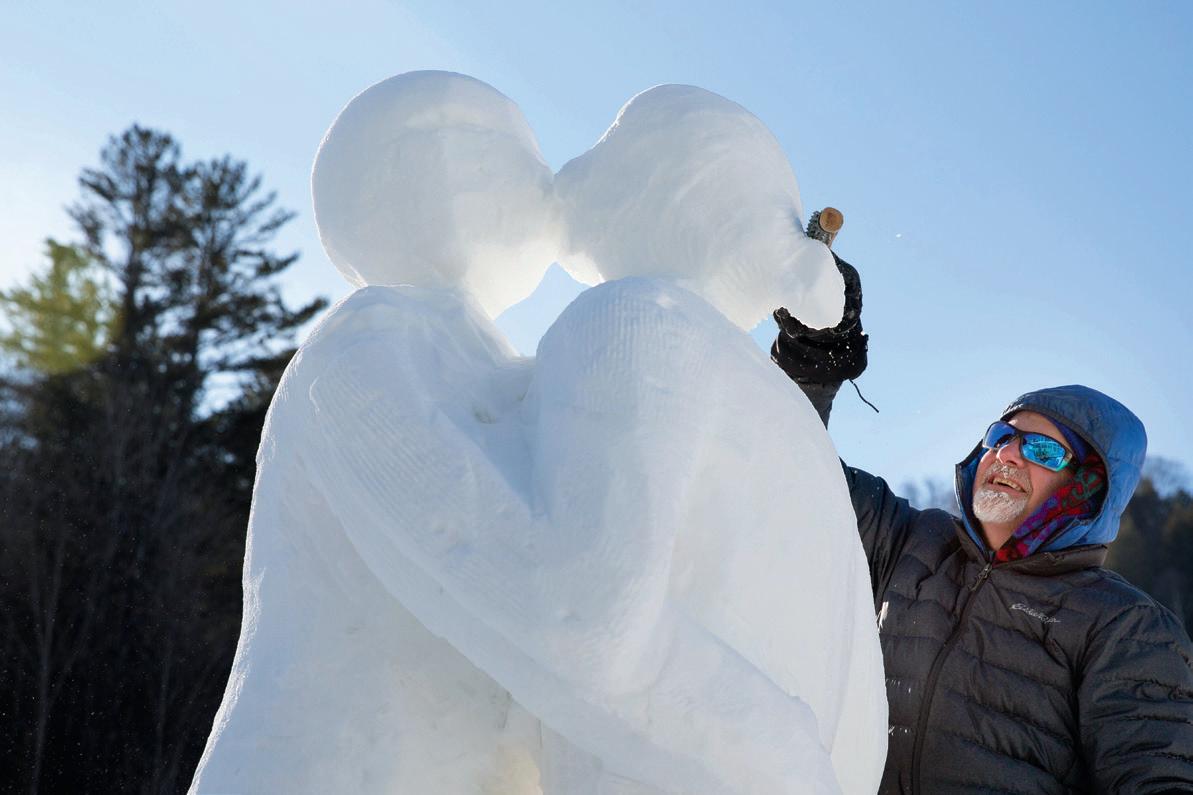
“Taking the waters” may be an ancient wellness practice, but a hydrotherapy experience at Bodhi Spa feels like a remedy for 21st-century winter blahs. Luxuriate in 98- and 104-degree mineral pools, dry and infrared saunas, and a eucalyptus steam room; in between, brave a 55-degree cold plunge pool. A two-anda-half-hour session ($85) allows you to cycle through the Water Journey until you’re basically blissed-out mush. Newport & Providence, RI; thebodhispa.com



COMB A WINTER BEACH Secure the hood on your parka, then head down the steps to Cape Cod’s Lighthouse Beach . This picturesque cove is a treasure, and in winter you may have it all to yourself. Walk the ever-changing tideline to see what the ocean has delivered; look across the waters, and you may spot a seal. Here is a beach you can even enjoy from the comfort of your heated vehicle: Arrive just before sunset, park in the overlook lot, and stay until the pink streaks turn to indigo. Chatham, MA; chathaminfo.com/beaches
TAKE A
TO REMEMBER AT SUNDAY RIVER. With eight separate peaks served by 18 lifts, the slopes are hopping all day long at this sprawling Maine resort. But after the sun goes down, catch a different kind of rush by walking through a winter forest sparkling with more than 100,000 lights, as the Après Aglow display returns bigger and brighter in this, its second year. Newry, ME; sundayriver.com
Going snow tubing is accessible, easy, a ordable —and one ride is all it takes to bring out your inner kid. Spend a full day on the 18 lanes of Nashoba Valley Tubing Park, New England’s largest, in Littleton, MA, or go old-school at Great Glen Trails in Gorham, NH, which mixes uphill hiking with downhill zooming. But no matter where in New England you go, remember: If you aren’t grinning by the end, you’re doing it
wrong. skinashoba.com; greatglentrails.com
With over four miles of cleared ice, Vermont’s Lake Morey Skate Trail is the longest in the country, providing a runway for skaters to take flight into a stunning winterscape. Fairlee, VT; lakemoreyresort.com

ESCAPE TO THE TROPICS. When winter feels relentless, grab that steamy beach read you never actually opened last summer and point your getaway vehicle toward one of New England’s pockets of tropical warmth.

It’s 70 degrees at all times inside New England’s largest glass-house garden: the Roger Williams Park Botanical Center in Providence, RI. Fountains burble, camellias blossom, 40-foot palm trees stretch toward the sun. And you’ll feel the warmth tingling from the top of your head to the tips of your toes as you inhale the heavenly scent of Calamondin oranges. Tropical sensations are likewise guaranteed inside the Lyman Conservatory at Smith College in Northampton, MA. One of the nation’s oldest plant havens, this 12-greenhouse complex’s jungle-like Palm House [pictured] is always kept humid and at least 70 degrees for the comfort of its specimens, some of which are a century-plus old. You’ll feel better able to endure winter’s worst after spending time with these survivors and stopping to smell the flowering orchids and rhododendrons. providenceri.gov/ botanical; garden.smith.edu/plants
Or even better, let John Gorka, Patty Larkin, Lucy Kaplansky, and Cli Eberhardt handle the vocals. That’s the Feb. 14 lineup at Maine’s Stone Mountain Arts Center. This unique performance space is the brainchild of singer-songwriter Carol Noonan, who one day realized the timber barn built by her husband, Je Flagg, had astounding acoustics. It took planning and a quick lift of the barn (the neighbors all pitched in to handle the ropes to guide it to a new foundation), but now Carol and Je host headliners all year long. Brownsville, ME; stonemountainarts center.com
11GREET THE YEAR OF THE RABBIT. In celebration of the Chinese New Year, lion dancers and clowns lead the colorful annual parade in Boston’s Chinatown, and the sounds of drums, gongs, and firecrackers will lead you to multiple processions across the neighborhood. Postparade, feast at Yankee food editor Amy Traverso’s modern favorite, Shojo, or enjoy classic fare at Peach Farm, the Chinatown restaurant beloved by none other than Julia Child. 2023 parade date TBA; bostonusa.com/events

Staying hip is a tall order for any centenarian, but the 112-year-old Dartmouth Winter Carnival has proven itself adaptable. Gone are the ski jumps and beauty pageants, replaced by polar bear plunges, human dogsled mushes, downhill canoeing, costumed ski racing, and more. Classic touches remain, though, including sleigh rides and ice skating, plus a showing of Winter Carnival, Hollywood’s 1939 take on this February icon. 2/9–2/12. Dartmouth, NH; home.dartmouth.edu



AT
PANCAKE PARLOR. The pancakes come stacked high or low, in varieties ranging from plain to blueberry to gingerbread to gluten-free. Oldtimers can order baked beans on the side; whippersnappers get nitro cold brew. In other words, there’s no one that the crew at Polly’s can’t please. Whether you’ll be skiing Cannon Mountain or just sitting by the fire, there’s no sweeter way to start your day. Sugar Hill, NH; pollyspancakeparlor.com

Located in a wildlife preserve, the Frosty Drew Observatory is the real deal, with working astronomers, giant telescopes, and some of the darkest skies in the region. On celestial tap this winter: the annual Quadrantid Meteor Showers, two micromoons (full moons occurring close to apogee, the farthest point in the lunar orbit), and Comet C/2022 E3 ZTF. It’s open to the public for Friday stargazing nights year-round, and for special events if that comet gets bright enough! Charlestown, RI; frostydrew.org

. In February and early March, when you board the 64-foot RiverQuest tour boat at the Connecticut River Museum for a two-hour naturalist-led cruise, your purpose is clear: to see the fierce beauty of bald eagles in flight or guarding their nests, evidence of the rebound of a once-endangered species. These are prime feeding grounds for eagles and other raptors, and while nature offers no guarantees, passengers often see dozens of majestic birds. Essex, CT; ctrivermuseum.org/eagle-cruises
DINE
. Begin your evening at the Salem Cross Inn with a horse-drawn sleigh or wagon ride over rolling fields, then head inside to warm up with mulled wine or cider, made in a tankard with a hot poker. Watch as sta prepare a 1700s-inspired meal over a massive open hearth; chowder bubbles in a cauldron while prime rib spins on a roasting jack. Soon, you’re invited upstairs to feast on the aforementioned delights, along with homemade apple pie. Book ahead and pray for snow. West Brookfield, MA; salemcrossinn.com



A fat bike, built with tires of four to fi ve inches in diameter, is the quieter, greener way to power through the winter woods, no motor required. As many of the roughly 10,000 members of the New England Mountain Bike Association already know, there’s a special quality to pedaling through snowglazed forests and parks. Find their list of prime fat-biking spots and events at nemba.org/news/ winter-fat-tracks.
SIT
TO THE
PARTY. Grab a moment of warmth and serenity at Ceremony, a small, independent Rhode Island café where owner Michelle Cheng [pictured] serves hot drinks like ume plum tea and honey lavender lattes, as well as cocktails, natural wine, and pastries and snacks. Reserve ahead with friends to experience a traditional Chinese tea ceremony or Japanese matcha ceremony, with all teas individually sourced and imported from small farms across Asia. Providence, RI; ceremonypvd.com
At many New England ski mountains, when the sun goes down, the lights come on— and a new part of the ski day begins. Take New Hampshire’s Gunstock Mountain, where half the slopes stay open till 9 p.m., including the terrain and tubing parks. So does the pub and café (and on chilly nights, those beers and hot chocolates will taste especially divine). Gilford, NH; gunstock.com


. Without the wintry forces of nature, the artists who build New Hampshire’s most enchantingly ephemeral attraction would have themselves a giant puddle. But as the cold snaps and water flows over icicle building blocks, Ice Castles becomes a massive walk-through wonder, glowing with LED lights. Dress warmly, because you’ll want to experience all that awaits inside, including an ice sculpture garden and frozen slides. New this season: an ice bar serving frosty cocktails. Opens in January; see website for details. North Woodstock, NH; icecastles.com
For the truly adventurous Nordic skier, the Wildcat Valley Trail in Jackson, NH, is a bucket-list route. The 17km descent off the backside of its namesake mountain is known for deep powder, high-speed cruising, and views that extend into Maine, and culminates in a photo-worthy finish in Jackson Village. But wait, there’s more: as in, another 130km of routes for XC newbies and experienced skaters alike.
While New England has lots of serious Nordic spots to choose from—such as Craftsbury, VT, and Bethel, ME—few can compare to this small community (pop. 800) and its star attraction, the Jackson Ski Touring Foundation . On a prime winter day, as many as 1,200 skiers take to its trails, drawn by the deep woods, the sight of all those peaks, and state-of-the-art grooming. Along the way are inviting rest stops, like the Cocoa Café warming hut and local pubs and restaurants, that have the power to keep you exploring and maybe even have you dreaming about making your own epic Wildcat run someday. Jackson, NH; jacksonxc.org



IN AMERICA. Put yourself in this picture: A soft snow falls, and a brick walkway that stretches for four pedestrian-only blocks becomes sprinkled with white. More than 100 shops and restaurants beckon you inside—bakeries and cafés and bookstores for lingering. When the sun pops out, there will likely be a musician or two setting up. Some 1.5 million visitors stroll Church Street Marketplace blocks each year, but on this day, you can imagine you’ve stepped inside a snow globe of the perfect winter cityscape. Burlington, VT; churchstmarketplace.com

The howls before the start of Maine’s Can-Am Crown International Sled Dog Race will give you shivers—as will the sight of sled teams sprinting to the finish at the end of 30-, 100-, or 250mile wilderness races. 3/3; Fort Kent, ME; can-am-crown.net

Of the 4 million visits people made to Acadia National Park in 2021, nearly all were by car. The scene looks vastly different when the snow flies, however, and most of the famed Park Loop Road is closed to auto traffic—offering a prime opportunity for winter enthusiasts to explore this stunning 47,000-acre park at their own pace and under their own steam. Mount Desert Island, ME; nps.gov/acad
ENJOY A FOOD COURT— WITH FIREPITS. Carved into a former Boston-area storage facility, Bow Market is a collection of 30-plus small businesses—florists, chocolatiers, a brewery— arrayed around a courtyard. In the winter, the space is filled with cozy firepits that serve as heaters and tables. Savor your choice of pork lumpia from Tanám or lobster mac and cheese from Bluefin, and—sheltered from the wind and warmed by the fire— discover how comfortable an outdoor midwinter meal can be. Somerville, MA; bowmarketsomerville.com


Kids love to play in the snow, but at the February igloo-building event at Vermont’s Montshire Museum of Science, playing and learning intersect. Eager builders are guided and encouraged by Dr. Bert Yankielun, author of How to Build an Igloo and Other Snow Shelters, and you hear wonder in their voices when construction ends and exploring begins. 2023 date TBA. Norwich, VT; montshire.org
SHIVER YOUR TIMBERS. Connecticut’s famed maritime history hub, Mystic Seaport Museum, invites all ages to have an “ice” day as its 19-acre campus fills up with winter activities—ice sculpting demonstrations, marshmallow roasts, games, crafts, and more—for its annual Ice Festival celebration. 2/18–2/20. Mystic, CT; mysticseaport.org

WRAP YOURSELF UP IN CULTURE. A cozy afternoon spent in an art museum is a terrific way to gain a new perspective after a busy summer and fall—and New England, with its long history of nurturing art and artists, has some world-class options to choose from. In the winter months, you’ll find these places peaceful, uncrowded, and uplifting.
■ Big picture: One of the great private art collections in America, housed in a 19th-century Venetian-inspired palace. ■ Winter warm-up: Daydreaming among lush tropical and subtropical plants in the four-story glass-topped courtyard. ■ Don’t miss: “Metal of Honor,” a gleaming exhibit of goldinspired artwork (ends mid-January). Boston, MA; gardnermuseum.org
■ Big picture: Three centuries of European masters and American greats, from Wyeth to Warhol, in the heart of
downtown. ■ Winter warm-up: The vibrant colors and creativity of “American Perspectives,” an exhibit of 70-plus works from the American Folk Art Museum (opens Feb. 3). ■ Don’t miss: The excellent gift shop, packed with Maine’s largest selection of art books as well as treasures by Maine artisans. Portland, ME; portland-museum.org
■ Big picture: One of the nation’s three largest university art museums, powered by an aggressively diverse collection of 100,000-plus works of art and design. ■ Winter warm-up: Laid-back

Café Pearl, run by Little Rhody’s own Bolt Coffee.
■ Don’t miss: “Being and Believing in the Natural World,” named one of the season’s 10 “must-see” museum shows by The Boston Globe (though May 7). Providence, RI; risdmuseum.org
■ Big picture: The biggest and best such collection outside the U.K., spanning medieval to contemporary eras.
■ Winter warm-up: Bask in the glow of abundant skylights throughout, as Louis I. Kahn designed this space to let in as much natural light as possible.
■ Don’t miss: “Britain in
the World: A Display of the Collections,” featuring a number of rarely seen gems (through Feb. 26). New Haven, CT; britishart.yale.edu
■ Big picture: Picasso, O’Keeffe, Matisse, Monet—they’re all here,
along with stunning glass, early-American furniture, and more.
■ Winter warm-up: The joyous, rainbow-bright murals by Connecticut’s Sol LeWitt in the sunny Winter Garden Café.
■ Don’t miss: “State of the Art 2020: Locate,” an eclectic, often colorful showing of
American contemporary artwork (though Feb. 12). Manchester, NH; currier.org

■ Big picture: A stateof-the-art museum complex made for exploring indoors and out, thanks to a lovely 103-acre campus and Vermont’s largest sculpture garden.
■ Winter warm-up: Regionally inspired, upscale fare at the airy, window-filled curATE café (reservation only).
■ Don’t miss: The fall/winter member exhibition, featuring recent work from SVAC artist members. Manchester, VT; svac.org
SKI
A few miles north of Kingfield, ME, Route 27 curves to the right and the trees suddenly part, revealing the spectacular visage of Sugarloaf, its sparkling snowfields rising more than 4,200 feet above the Carrabassett Valley.
From a distance, you spy white ribbons of trails that descend from the lower snowfields, then wind down the mountainside through the trees. Up close, you see wind-stunted trees draped with snow. These are the “snow ghosts” that skiers weave through while dropping down some of the steepest chutes in this part of the country.

The snowfields are a short walk from the top of Timberline Quad, the only lift service to above-treeline skiing in the East. No matter where you ski on the mountain, the snowfields seem to beckon. Some ski the front side of the fields, in sight of buildings and people, and where groomers keep one trail, White Nitro, in shape. Others head toward the back side, where the mountain grows quiet, with nothing in sight except snow and rock and more mountains and distant valleys, as if you’ve entered another world altogether. Carrabassett Valley, ME; sugarloaf.com
GO DASHING THROUGH THE SNOW. Snow, your sweetheart, and a one-horse open sleigh—does winter in New England get any more romantic? At Nestlenook Farm, you can book a private sleigh ride for two (or up to 12, if you’d like company). Public rides for up to 15 passengers are also available. Bring your blanket, and maybe ice skates to take a spin on lovely Emerald Lake. Prefer to self-power? Nestlenook boasts extensive snowshoe trails, too. Jackson, NH; nestlenookfarmsleighrides.com
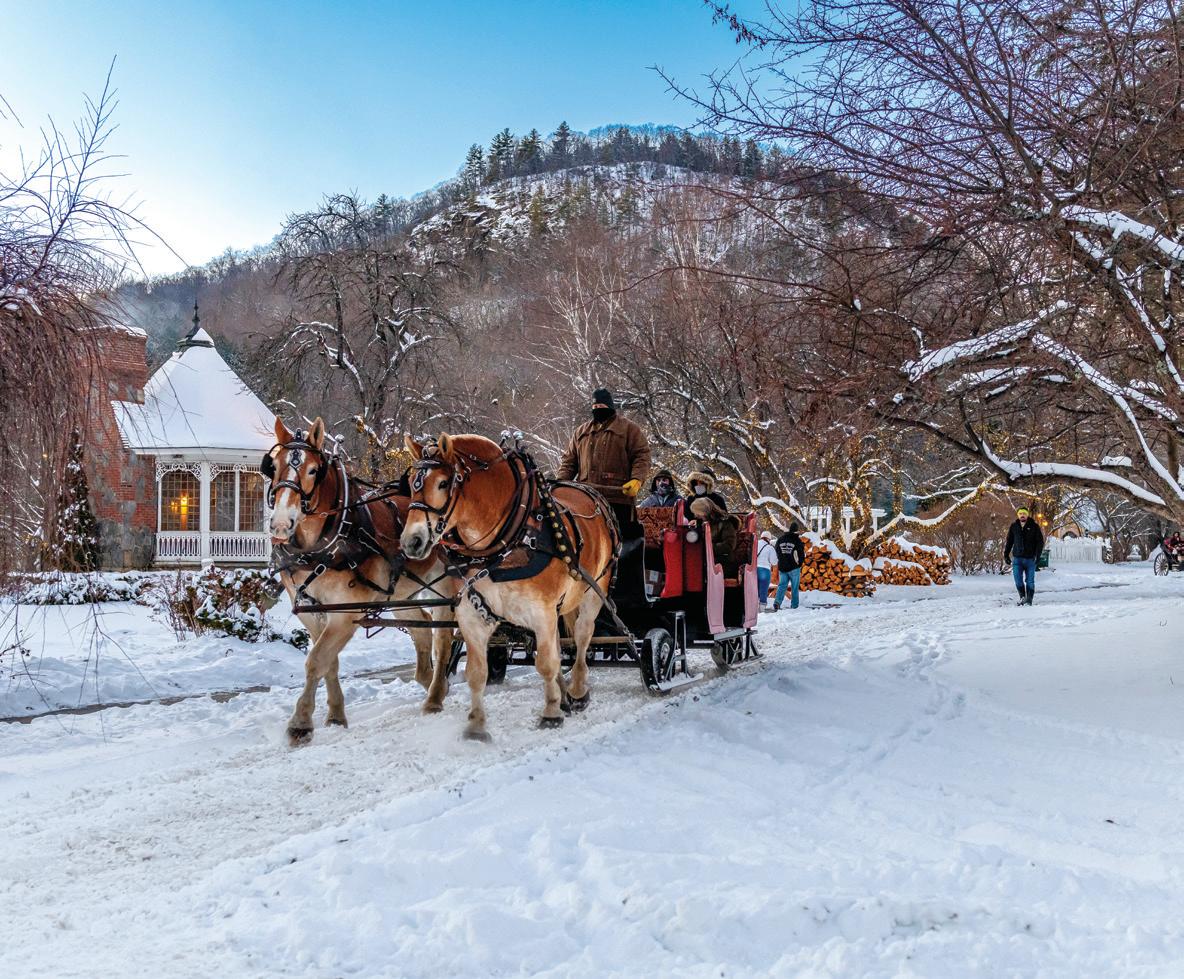

Snow-dusted sculptures await you on the 30 rolling acres of the DeCordova Sculpture Park and Museum in Lincoln, MA, where 60 works by notable 20th- and 21st-century artists are on display year-round. Or go west to explore The Clark ’s 140-acre campus in Williamstown, MA [pictured]. Tuesdays through Sundays, you can borrow snowshoes for an outdoor adventure, then step indoors to warm your toes and feast your eyes with a slow stroll through the galleries. thetrustees.org; clarkart.edu
Magnificent views of Rhode Island’s Pell Bridge make the outdoor rink at Newport Harbor Island Resort a can’t-miss for skaters. Even better: timing your visit with February’s epic 10-day Newport Winter Festival Newport, RI; newportharbor island.com; newportwinterfestival.com

When the weather outside is frightful, the 60,000-square-foot Jay Peak Pumphouse water park in Vermont offers up H₂0 at a steady 86 degrees, prime lounging opportunities, and an array of waterslide adventures that seem to test the laws of physics. Mix in a lazy river and a poolside bar, and voilà: Inside, it’s so delightful. Jay, VT; jaypeakresort.com

FUN. The western White Mountains are the backdrop for the Bretton Woods Canopy Tour, a multihour, through-the-woods experience that escorts visitors down New Hampshire’s largest ski mountain in a completely novel way. Sky bridges, rappel lines, and zipline speeds of up to 30 mph all highlight a winter experience that will warm the hearts of even the most committed skiers and boarders. Carroll, NH; brettonwoods.com


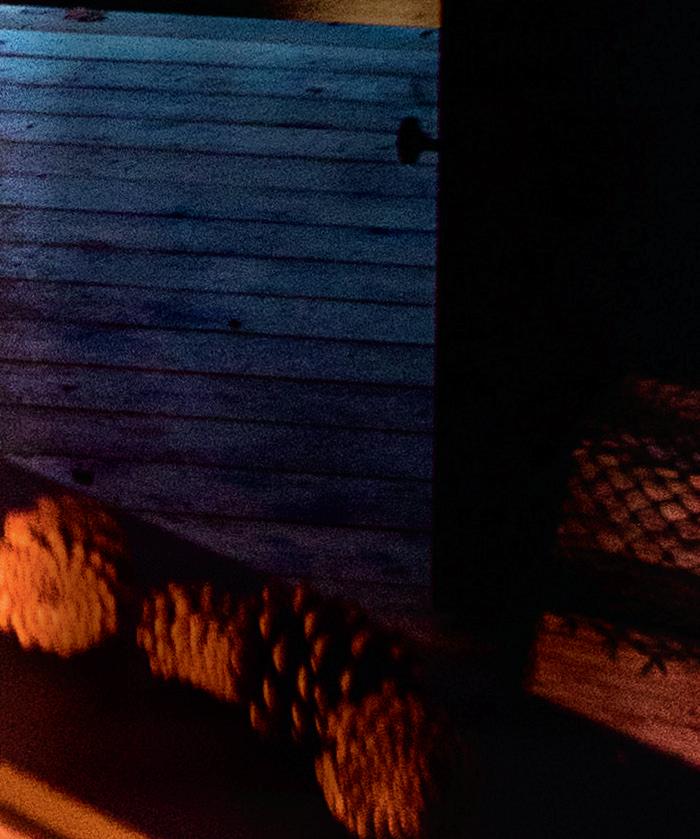
The alfresco options that sprouted up all over New England during the pandemic era may be less numerous these days, but some are so inspired that they remain permanent fixtures—and even top tables. Most glamorously, the Gondola Village at Ocean House in Watch Hill, RI, serves haute après-ski fare in restored vintage ski gondolas that seat up to four. Millwright’s in Simsbury, CT, has a row of elegant greenhouses that function as private dining rooms for two to five patrons, with a view of the restaurant’s signature waterfall. And at Batson River Brewing [pictured] in Kennebunk, ME, the wildly popular “fishing shacks” o er a cozy retreat for up to six, complete with party lights, plaid throws, and a menu of poutine, burgers, and house-made beers and spirits. oceanhouseri.com; millwrightsrestaurant.com; batsonriver.com



This is so not Elin Hilderbrand weather. For starters, it’s January. The wind chill is in the single digits. Nantucket Sound is riled up. The low cloud cover seems shot through with steel wool. But Hilderbrand, the effervescent, blond, toned, and perpetually tan author of dozens of beachy, best-selling novels set on Massachusetts’s Nantucket Island, where she lives, is gamely cheesing her way through selfie after selfie. It’s day two of the sold-out Elin Hilderbrand Bucket List Weekend, which has brought 150 fans (Hilderbabes, in the parlance) to the island to pal around with the writer during themed banquets, yoga sessions, cooking classes, and, everyone’s favorite, late-night dancing at the Chicken Box, the dive-y bar that makes frequent appearances in Hilderbrand’s novels. On the schedule this morning: a photo op at the white-shingled Brant Point lighthouse—frigid north winds be damned.
“It’s fine,” Hilderbrand says through a half-frozen smile to the women waiting in line for a picture with her. She’s wearing a driftwood-colored knit beanie, aviator sun glasses, a black puffer jacket, jeans, and damp-at-the-toe sheepskin boots, a getup through which she is somehow projecting sunniness and glamour, though it’s a far cry from the strappy mini-dresses and crystal-embellished sandals she sports for most appearances. “I’ll stay until you guys all have what you want.”
That’s not entirely true. What they want, what all her fans want, is the promise of a fat Hilderbrand novel to escape into this summer and all the summers to come. They want those familiar book covers with the azure skies over sapphire seas, and the viewed-from-behind women lolling in canvas sling chairs or under umbrellas on golden sand. They want the Mirabels and Mallorys of Hilderbrand’s fic tional universe to continue to find second chances at love, reconciliation with estranged family members, and girlboss empowerment—all while sipping icy gimlets at Gal ley Beach or slurping mignonette-bathed Pocomo Meadow oysters at CRU. But after 22 years of producing one novel a year—and sometimes two—the 53-year-old queen of the beach read, as she is often called, is throwing in the (plush, cabana-striped Turkish cotton) towel. The book she turns in late in 2023 will be the last of her annual novels. This, despite the fact that she is at peak popularity: Her latest, The Hotel Nantucket, inspired by the grand, 43-room Nan tucket Hotel which hosts the Bucket List getaway, debuted at No. 1 on the New York Times best-seller list.
“I need to get off the merry-go-round of the expectation that it’s June and Elin Hilderbrand is going to have a new
summer book. It’s just too much,” she said later. “I feel great pressure to write a better book every time. I can’t take the stress of having no end in sight.”
She knows that doesn’t please her fans.
“I think my readers would be more disappointed if I kept going and put out books that didn’t live up to expectations. I’m doing us all a favor by retiring,” she said. “I don’t under stand why more writers don’t do it. Honestly. It’s dismount ing and nailing the landing and just being, like, I’m done.”
Little, Brown & Co., Hilderbrand’s publisher, was shocked when she said she wanted to stop.
“I don’t think they believed me. They came to me with a four-book deal. They were offering a lot of money. And of course, in publishing, when that happens, people say, ‘Oh, thank you, thank you, this is so great.’ And I said, ‘I don’t want it.’ They just did not understand.” Eventu ally, she agreed to deliver three more books, including The Hotel Nantucket.
“And then I started writing that book and I could not get it right. I wrote six different beginnings. I thought, I’m screwed. I’m blocked. I shouldn’t have signed the contract. I sold my soul to the devil. But I kept at it. I just had to have faith in myself. And then about two-thirds of the way through it, I thought, This book is going to be really good . I say that with so much immodesty. But, I couldn’t believe it! It was such a relief.”




Elin Hilderbrand’s march to beach tote ubiquity started with her childhood in Collegeville, Pennsylvania, a suburb of Philadelphia, where she won the “top author award” in second grade. Her parents divorced, and when her father remarried, the newly blended family began a tradition of spending July in a rented cottage in Brewster, Massachu setts. Those Cape Cod vacations with her four siblings were what she calls classic American summer: beach picnics, mini-golf, outdoor showers, touch football, tidepool explo rations, board games, and for Hilderbrand and her stepsister, Heather, walks down a sandy lane to the local book store with saved-up allowances in their pockets. The trips came to a sudden end in 1985, when Hilderbrand’s father died in a small-plane crash while returning home from a business trip. She spent her 17th summer assembling Hal loween costumes in a factory outside of Philadelphia, griev ing both her father and those magical days by the sea.
“I promised myself then that I would create a life where I spent every summer at the beach,” she said.
After graduating from Johns Hopkins in 1993 with a degree in creative writing, she took her first trip to Nan tucket and was smitten. A year later, she left a teaching job in New York to move to the island year-round.
“Those summers on the Cape were the happiest times of my life, so I think I felt a deep-seated instinct to want to re-create them for myself in a more permanent way. In some ways, my method of healing from my father’s death was to follow in his footsteps.”
In 1996, she married Chip Cunningham, the general manager of the Cliffside Beach Club, a tony gray-shingled hotel and private club on the island’s north shore. Hilder brand wrote classified ads for the local newspaper while working on a novel set in New York City. (“It was horrible,” she has said.) Still, she was accepted into the prestigious University of Iowa Writers’ Workshop graduate program.
“My first day I walked in wearing a white sundress and little gold ballet flats. I was very tan and I was, like, ‘Oh, hiii!’ Everyone else was in all black. The boys were in fedo ras and the women were in granny shawls. Right out of cen tral casting.
“I thought, We need to liven this place up, so I taped up a sign that said I was hosting a cocktail party and my class mates were looking at it, like, what is this? Is it free? I said, ‘Yes, it’s a party at my house!’ And I threw a banger. I made all the hors d’oeuvres from Sarah Leah Chase’s Nantucket Open-House Cookbook ,” she said with a laugh. “They did not know what to make of me.”
Neither did her professors. “I got crucified each and every week. My first workshop teacher was Frank Con roy. After we’d all talked about one of my stories, he said, ‘This will never be published. You will never be published.’ I knew he was wrong.”
Miserable and homesick, Hilderbrand availed herself of
the university’s free counseling. “I’d go every week and cry about how much I missed Nantucket. One day the therapist said, ‘You know what you have to do? Start writing a novel about the island.’ So I did.”
By chance, Michael Carlisle, a literary agent with strong family ties to Nantucket, sat in on her final workshop. He asked which of them lived on the island. “I was in a navyand-white sarong,” she said. “It was probably very apparent it was me.”
When she told him after class that she was writing a novel set on Nantucket, he asked her to send it to him when she finished. In January 1999, she mailed him The Beach Club, based loosely on her husband’s workplace.
“Michael called and said, ‘I love the book, I’d like to represent you, and I’m going to make you lots and lots of money.’ He’s been my agent for 22 years. It’s the longest relationship I’ve sustained in my adult life.”
Despite Carlisle’s enthusiasm, Hilderbrand’s first five books sold modestly. But a move in 2007 to Little, Brown, which launched a marketing campaign to brand her as the writer of juicy annual beach reads, changed her trajectory. Each book did better than the last. In 2019, with Summer of ’69, she knocked Where the Crawdads Sing, Delia Owens’s blockbuster debut novel, out of the No. 1 spot on the New York Times best-seller list.
“I’d watched book after book come out and try to bump Crawdads off. And then I did it. It was … overwhelming,” she said, choking up. “I always get teary when I talk about it. I am not Delia Owens. I did not become an instant bestseller. It was my 23rd book.”
While raising her three children, now 22, 20, and 16, Hilderbrand wrote everywhere and anywhere—always in longhand, always on legal pads. She wrote in the stands of her kids’ games, on the ferry, in the school pickup line, at the beach. After she and her husband divorced in 2013, she moved to a small house near the Nantucket Hotel, bought a gym membership there, and wrote by the hotel pool. Her goal was always to piece together three cumulative hours of composing a day.
“If it took me six or seven hours to do it, I was fine with that,” she said. “I’ve always done the work. It was my job. I’m consistent. That’s not a sexy word. It’s boring. I’m a reli able writer. That’s all I ever wanted to be. To give the readers exactly the same thing completely differently every year.”
“She’s the most disciplined person I have ever met,” said Tim Ehrenberg, marketing director of Nantucket Book Partners, which owns the island’s two bookstores, including Mitchell’s Book Corner, where Hildebrand does alwaysmobbed weekly appearances in the summer. Ehrenberg
“My first workshop teacher said, ‘You will never be published.’ I knew he was wrong.”
Pens at the ready, Hilderbrand dives into personalizing 5,000 copies of her latest book for sale at two of her local bookstores, Mitchell’s Book Corner and Nantucket Bookworks. A fulltime island resident since 1994, she’s made Nantucket the backdrop for more than two dozen novels.

orchestrated Hilderbrand’s personalization of 5,000 copies of The Hotel Nantucket pre-ordered through the stores’ web site. (The site crashed the day they announced the signed books were available.) “If we were going to meet in the store to sign, she’d text me and say, ‘OK, I can be there at 4:07 but I have to be gone at 4:34 to be somewhere else at 4:39.’ It really was that specific.”
That rigid schedule, which also included three hours of intense exercise every morning—running, Peloton, and a barre class—was derailed in the spring of 2014 when she was diagnosed with breast cancer. She was floored.
“I was healthy and ran 7-8 miles a day, I ate a lot of blue berries,” she wrote in a Huffington Post blog post days after her diagnosis. “I lie awake in the middle of the night … I am scared.”
She decided to go public about her illness. The day after appearing on CBS This Morning to talk about her diagnosis, she underwent a double mastectomy. Twelve days later, with surgical drains still in place, she was back on the road pro moting her newest book. More surgeries to deal with a lifethreatening infection followed. Through it all, she wrote: in doctors’ waiting rooms and in the hospital. Hilderbrand’s openness about her cancer earned her more fans, some of whom showed up at her events bald from chemo to say her books had helped them get through treatments. Her social media accounts (which she manages herself) became virtual clubhouses for an ever-growing you-go-girl sisterhood.
IT’S TROPICAL NIGHT AT THE NANTUCKET Hotel. Tables in the airy, whitewashed ballroom are set with faux monstera leaves and woven palm-frond place mats. The Bucket List attendees’ bright floral dresses are accessorized with plastic leis. Hilderbrand, in a flouncy, short, mai tai–hued dress and strappy heels, has made her
way to a low stage to begin the after-dinner trivia contest. The stakes are high; the winner will appear as a minor char acter in the author’s next book.
Hilderbrand calls out questions related to her 27-book oeuvre. There is murmuring and head-shaking and laugh ter. Was it Pickford Crimmins or Hobby Alistair? Madaket or Madequecham? Love O’Donnell or Featherleigh Dale?
“Even I don’t remember all this stuff,” Hilderbrand says.
Jessica Bailey, an oncology nurse, and Lynnel Ruckert, a political consultant, are sitting at a round table near the center of the room. The two Baton Rouge residents had bonded over their love of Hilderbrand books while spend ing endless hours in the bleachers of their sons’ baseball games. When they both nabbed coveted spots at the Bucket List weekend—3,400 waitlisted fans were turned away— they began to prepare for this night.
“We strategized,” Bailey explained later. “We divided all 27 books up and started re-reading them. We took notes— names of characters, where they met, where they worked. Names of lighthouses, restaurants, beaches…”
“Jessica made a spreadsheet,” Ruckert said.
“To see where we were and where we needed to get,” Bai ley said.
When the points were tallied, they had tied for first place. Hilderbrand suggested a runoff, but they declined.
“We’d already decided that if either of us won, we wanted to use our names together—Bailey Ruckert. Elin likes unusual names, so we thought it was perfect.”
Everyone agreed. It was perfect.
ELIN HILDERBRAND AND LITTLE, BROWN MAY have popularized the beach read, but they did not invent it. That subset of fiction emerged in the mid-to-late 19th cen tury, with the rise of summer tourism. In grand seaside and
mountain hotels, on trains and steamers, the new middle class suddenly had time to read.
Publishers took note, as author Donna HarringtonLueker wrote in Books for Idle Hours: Nineteenth Century Publishing and the Rise of Summer Reading, and began push ing “light leisure-time reading that included a mix of escap ist sensation fiction, risqué French novels, backlist titles of steady-sellers from established authors, and a new offer ing—the novel set specifically at the summer resort.”
Cultural critics warned against the dangers of reading such insubstantial fare, especially for young women, whose very virtue, they argued, was threatened by the frothy, over stimulating content.
“I really believe,” said the Reverend T. De Witt Tal mage, a prominent New York preacher, in an 1876 sermon, “that there is more pestiferous trash read ... in July and August than in all the other 10 months of the year.”
Some 150 years later, “summer read” is still viewed by some as shorthand for inconsequential fluff. But Hilder brand and her fans say they are not bothered by the label.
“I embrace the beach-read thing,” said Ruckert. “The books don’t need to solve all the world’s problems. Do they show women in a good light and show you how to persevere with family and friends? Yes. They give people hope and distraction and enjoyment.”

Laura Sullivan Davenport, director of employee com munications for LinkedIn, who had traveled alone from San Francisco for the Bucket List weekend, found respite in Hilderbrand’s novels, too, especially during the past two years.
“I work so much. I’m on the computer all day and it’s stressful. Her books are light but they’re good. And the way she writes about women, I always find things I can relate to. It’s so good for my mental health to just kind of tune every thing else out. That’s what they do.”
Hilderbrand is happy to be a conduit to escape, although she admits beach novels make up only a fraction of the 40 to 45 books she reads a year. “I read very literary fiction. It’s the only way to get better.”
Hilderbrand, who has designs on becoming a major book influencer—à la actress Reese Witherspoon—in her retirement, recommends mostly female novelists on her Instagram account and through her online book club with Literati, a subscription service that matches readers with celebrity curators. Still, she cites J.D. Salinger, John Updike, and John Cheever as early inspirations.
“Susan Cheever is a huge fan. She’s told me she sees her father’s influence in my writing. That feels amazing. I don’t get a lot of that kind of credit,” she said. “That’s another thing that makes me want to retire. I don’t want to
lose that quality. I just know it’s not forever.”
Hilderbrand doesn’t rule out writing more books— maybe a cookbook or a memoir, maybe even another Nan tucket novel someday. But for now, much of her attention is on the several projects she has in development in Holly wood, including the recently greenlit Netflix adaptation of The Perfect Couple, her 2018 whodunit. That six-part series will begin filming this spring.
“The most important thing to me is that they do Nan tucket right,” she said. “I don’t want people who have lived out in ’Sconset for 45 years to come up to me and say, ‘You ruined it.’”
THE BUCKET LIST WEEKENDERS ARE TAKING their last photos on the hotel front porch. They’ve packed away their “I’d Rather Be Living in an Elin Hilderbrand

Novel” tote bags. They’re saying good-bye to new friends. They know they may not see each other again, at least not in real life. Hilderbrand has announced she’ll do only one or two more of these getaways—and of course, there’s that crazy waitlist to contend with.
They’d walked the cobblestone streets Hilderbrand’s characters walked, seen the beaches and (mostly boardedup) bistros where they’d canoodled. They’d shopped in seasonal boutiques that had reopened one afternoon just for them—such is the power of the author—for the Bucket List “Sip ’n Shop.” And they’d closed— closed! —the Chicken Box with Hilderbrand, then rallied for afternoon beers with her at Cisco Brewers. Many of them hadn’t danced—or drunk—like that in years. Even in bleakest January, they’d fallen hard for Nantucket, or at least Elin Hilderbrand’s version of it.
“I absolutely loved it,” said Sullivan Davenport after she’d returned home. “I want a house there. Just a cute cot tage, you know, it doesn’t have to be on the water. The island has such a romantic feel to it. I’m single. I got divorced a few years ago. Maybe if I had a house on Nantucket, I’d go and meet my future husband and we’d have a lot of money and….”
The plot could only thicken. “Elin gave me the name of a real estate agent.”
“I’m doing us all a favor by retiring. I don’t understand why more writers don’t do it. Honestly. It’s dismounting and nailing the landing and just being, like, I’m done.”
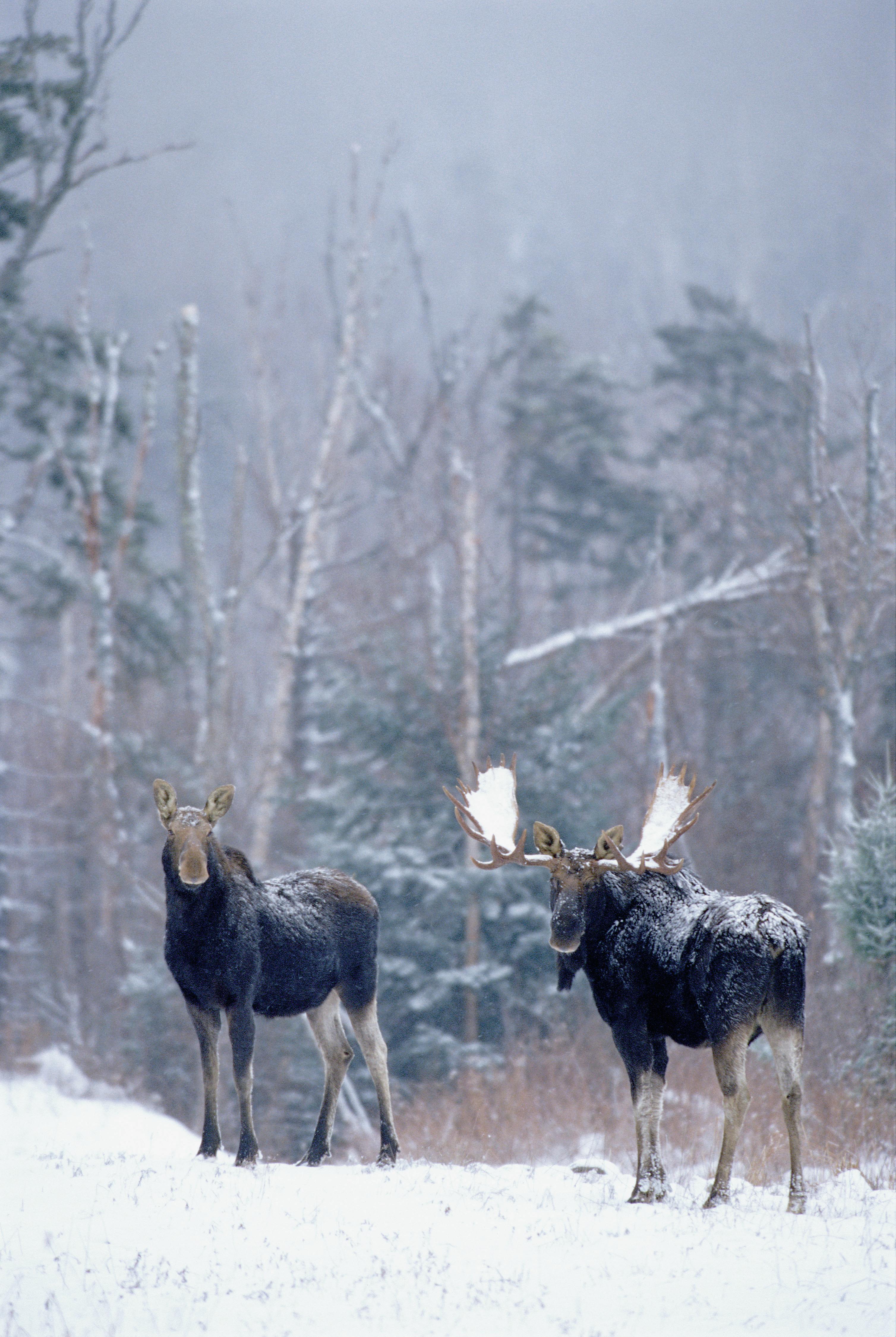
When Roger Irwin takes his camera into nature, he wants “people to see what I’ve been lucky enough to see.”
It was under a fading patch of moonlight that Roger Irwin first spotted the cow moose. It was a Thursday in mid-September and pushing just past 6 in the morning, and already Irwin had been out of his house for a good hour. He’d gotten into his Toyota truck sometime after 5 a.m. (“a little later than I wanted to,” he recalls), and from his home in Maidstone, Vermont, followed a network of quiet roads into New Hampshire, to a favorite patch of retired logging lands in Odell where he knew he could reliably find a moose. This morning proved no exception.
Through the trees, Irwin spotted the animal, whose breath showed in the chilly autumn air. Irwin turned off his truck and, after a few minutes, stepped outside, stationing himself in front of the vehicle with his camera to begin making pictures. His heart raced.
“I still get excited,” he says. “It’s never boring. It’s always different.”
It’s a thrill that first sparked in him when Irwin was a boy. He was 11 years old when his parents opened their Maidstone home to a pair of working photographers from New York City who were on assignment for Vermont Life. The visit was just two days long, but for Irwin it was life-changing. The two men told him about their work, showed him their Leica cameras, and later sent a set of black-and-white photos they’d made of the Irwin family.
“I was just fascinated by the quality of the images,” says Irwin, now 72. “They were real stories associated with each of their pictures.”
Irwin soon started crafting his own stories. He picked up an 8mm camera to make home movies and later a 35mm to shoot pictures for his high school yearbook and newspaper. But then life and work and family took him in other directions. Irwin remained in his hometown, got married, and raised four children on a 250-acre dairy farm.
Then, a little over 15 years ago, Irwin sold his cows and settled into semi-retirement. Not long after, he purchased a camera. “I could
finally afford to do photography again,” he says with a chuckle.
Irwin’s work was born from his love of the land and being out in the wild. He set up blinds around his own property and waited patiently, sometimes many hours, for wildlife to emerge. In deep autumn he’d take the chill off with a small propane heater just so he could keep “putting in the time.” Come summer, Irwin embraced the long days, heading out in the predawn hours, his backpack loaded with equipment, to hike the hills and paddle the waters in the nearby Vermont towns of Granby and East Haven. Often, he wouldn’t arrive home until suppertime.
“I’m not a big people person,” says Irwin, who has dialed back his vigorous shooting schedule in recent years. “And I just love getting out there, among all the peace and quiet, and all that natural beauty. To be in the woods or on a pond, to have those places all to yourself, it’s kind of nice.”
Irwin’s passion for those backwoods settings is evident in his work. He is not an intruder but a patient observer, a photographer capable of sinking into his surroundings as he waits for a moose, or for the light to hit the forest in a certain way. Over the years Irwin’s intimate nature images have graced multiple covers of Northern Woodlands magazine and been featured by the Nature Conservancy and the U.S. Fish & Wildlife Service.
For Irwin, the opportunity to show his images and invite others to share his appreciation for New England’s woods and wildlife is maybe the most important part of the work. His photos tell stories, and—as Irwin learned long ago—getting access to those stories can be a powerful thing.
“It’s my passion,” he says, “and I just want people to see what I’ve been lucky enough to see.” —Ian Aldrich
To see more of Roger Irwin’s photos or to order prints, go to rogerirwinphotos.com.
opposite: Following fresh moose tracks on an old logging road in East Haven, Vermont, Irwin came around a corner “and they were just standing there, waiting for me. They gave me a minute or two to take pictures before they figured out they wanted to take off.” By chance, Irwin would end up with one of this bull’s antlers, found by his son while rabbit hunting on a nearby mountain a week later.


top left : While Irwin often performs moose calls to draw out his subjects, getting this shot of a barred owl needed a different kind of mimicry. After seeing it fly across the road and perch in a tree nearby, Irwin rolled down his truck window, grabbed his camera, and started ... squeaking. “I don’t know how much like a mouse it sounded,” he chuckles, “but it kept his attention anyway.”
below left : The farmhouse and barns on Irwin’s property in Maidstone, Vermont, sit on glacial delta land, and foxes sometimes dig their dens into its sandy soil. Shooting from behind a chair blind, he caught this image of fox kits out sunning themselves, momentarily transfixed by the commotion of nearby birds.
above: This juvenile black bear, which was traveling with its sibling and their mother, is taking a break from an annual fall feast: foraging around the edges of Irwin’s fields after a tenant dairy farm had harvested its corn there.

right : Though he has driven throughout northern New England in search of stunning wildlife images, Irwin often finds what he seeks in his own backyard, which encompasses fields, woodlands, floodplain, and, yes, beaver ponds.

above: Irwin has made a number of memorable photographs of bobcats—like this one enjoying a little stretch near a blind on his property—but getting the perfect shot of their elusive bigger cousin, the Canada lynx, is still on his bucket list. “I actually saw one two years ago in my headlights while driving in Maine, way up there by Parmachenee Lake,” he says. “If I keep trying, maybe I’ll get one someday.”

below : Photographing birds is a mixed blessing for Irwin. On the one hand, they’re generally not as skittish as mammals; on the other, it can be a real challenge to get good perspective on tree-dwellers from the ground. After noticing that a family of yellow-shafted flickers had made their home in one of his trees, Irwin put a blind on a pallet and used the loader on his tractor to lift it up to the birds’ level. He had to make a few trips up and down the ladder to the pallet to get this shot, but the results were worth it.


Using his kayak not only helps Irwin get close to moose—always a favorite subject—but also allows him to see things that are almost invisible from land. This days-old pied-billed grebe, no bigger than a marshmallow Peep, had been riding on its mother’s back but lost its hold when she dove for food. While waiting for her to resurface, the baby paddled toward Irwin for a closer look. “It would have been an even better shot if I could’ve gotten down to his level, but that’s pretty tricky in a kayak!”

“All the members of the weasel family are very hard to get pictures of—they move so fast and they’re just up-anddown, up-and-down, all the time,” Irwin says. This short-tailed weasel, likely hunting mice, had just popped up out of the snow near a beaver dam when Irwin caught this photo, his patience rewarded at last.

Big Nansen, a ski jump that was once the pride of the North Country, may again rise up.

 BY BILL DONAHUE PHOTOS BY CHRIS BENNETT
BY BILL DONAHUE PHOTOS BY CHRIS BENNETT
opposite : Eli Larkin of New York prepares for takeoff during last year’s Nansen Ski Club Winter Carnival in Berlin, New Hampshire, which was hosting the first ski jumping competition at the Nansen Ski Jumps since 1985.
this page : With the western Maine mountains off in the distance, Nathaniel Weimer of the Andover (NH) Outing Club flies high above the slopes in Berlin. The 2022 competition was held on the 10-meter and 39-meter jumps in the shadow of the legendary Big Nansen, an 80-meter behemoth that is now being restored.

stood in the snow, hands on our hearts, and we sang the national anthem, our words visible as white puffs of steam in the 10-degree chill. There were 600 or 800 of us on a day last January. A rock group called Straightaway, made up of three local guys, led us a cappella, their earnest voices swooning low on key notes.

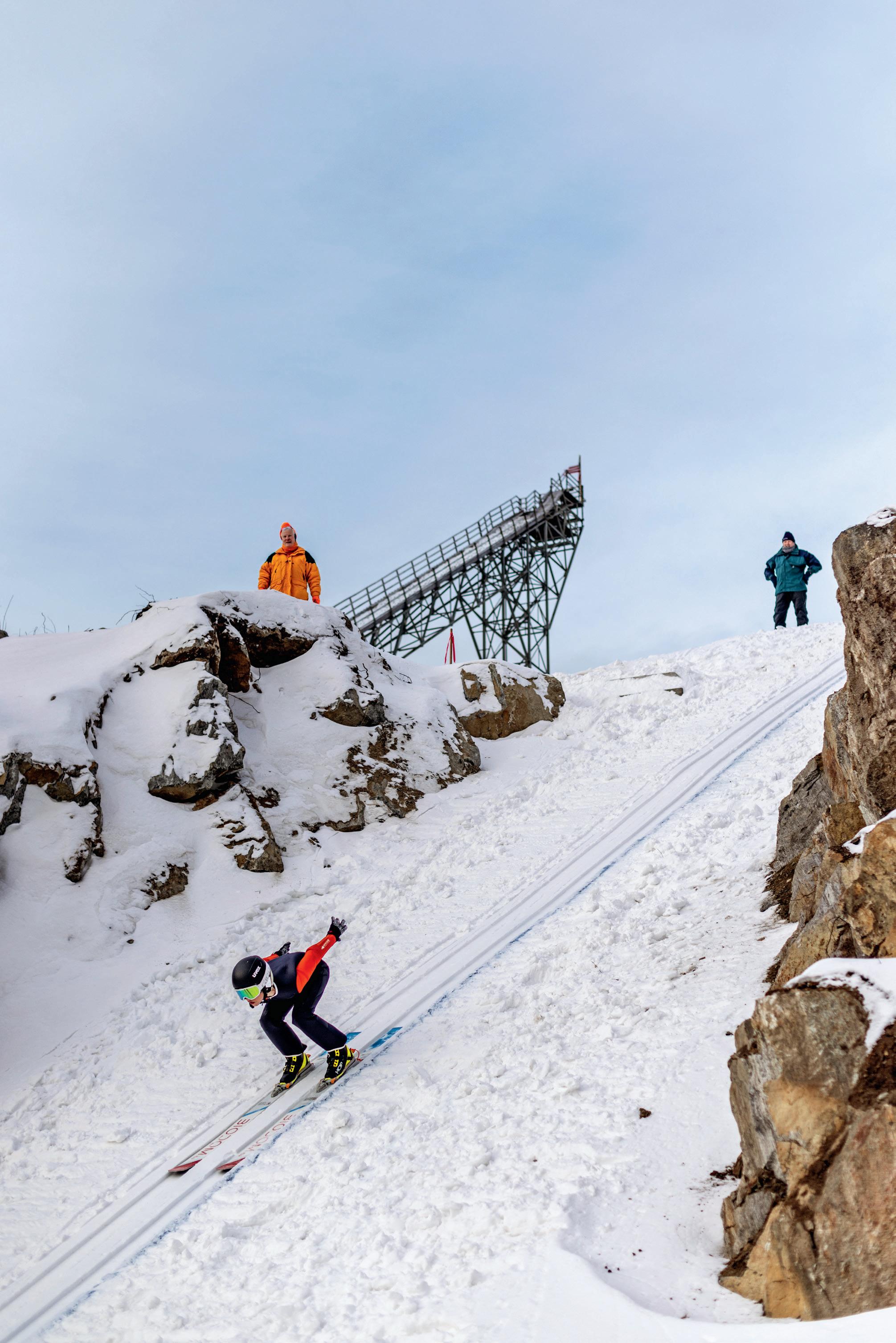
When Straightaway finished, we all looked skyward, for something hopeful was happening on the snowy hill loom ing before us. The Nansen Ski Club Winter Carnival in Ber lin, New Hampshire, was in full swing, and for the first time in 37 years, a ski jumping contestant was zooming down the runway. Nine-year-old Leila Fey of Lake Placid, New York, threw heart to the wind, and then she was flying high, her spread-eagled skis acting as sails. Down below, the multi tudes cheered. Some who may have once jumped here, too, nodded happy approval. Teenagers, gamely bareheaded and ungloved, hooted with delight, and mothers held their tod dlers aloft to give them a view of the festivities.
Berlin had needed this one for a long time. A former mill town of 9,400 set amid the thick forests of far-northern New Hampshire, Berlin has, since 1970, seen its population
clockwise from far left : Big Nansen looms behind Scott and Brett Halvorson, whose grandfather, Alf Halvorson, led the efforts to build it; the 39-meter “Little Nansen,” with Big Nansen in the background; a racer’s-eye view from the top of Little Nansen; Kerry Tole of Plymouth, New Hampshire, winner of the K39 Open Female division; racers get a ride to the top (stair access is planned as part of ongoing improvements to the ski hill).




decline more precipitously than any other town in the state. All along, though, its citizens have kept their eyes on revival. In recent years, they’ve worked to draw ATV riders and mountain bikers to the trails around town, and they’ve also remembered Berlin’s glory days.
The city was once the ski jumping capital of North America. Between 1940 and 1972 it was the site of four U.S. Ski Jumping National Championships. In 1938, 25,000 spectators gathered at what is today Nansen Wayside to watch an Olympic qualifier. The Berlin Sun marveled that traffic was so thick on the road to the jump that it “looked like a stream of small bugs running single file.”
The focus of the excitement was a towering 171-foot-tall structure called Big Nansen, a steel behemoth cradling a steep wooden inrun that stirred fear in its habitues. “In the wind,” says Mark Levasseur who skied the jump frequently in the late ’70s, “the track would be moving and pieces of ice would be cracking off. You’d have to trick your mind into thinking you weren’t committing suicide.”

Big Nansen hosted its last competition in 1985. As the years went by, the runway was overgrown with trees and weeds. The jump was almost invisible from Highway 16, which passes right by the site. It took a large corporation and a starry-eyed old man to resurrect it from the ash heap of history.
A little over five years ago, Red Bull, the energy drink company, spent about $75,000 as it joined the state of New Hampshire in clearing and redecking the jump. On March 4, 2017, Olympian and Red Bull–sponsored athlete Sarah Hendrickson made two giant leaps off Big Nansen after being sidelined for 18 months with a knee injury. Then she posed for selfies with adoring spectators.
The jump was still a relic, though. Its antique swaying tower was miles from meeting 21st-century safety stan dards, as was its precipitous profile: Today’s jumps hug their hills, so that a jumper is rarely more than 15 feet off the ground. Nansen felt instead like a cliff with an elevator shaft drop-off.
Still, 72-year-old Scott Halvorson couldn’t stand to see the jump sit there unused. “It means so much to the com munity of Berlin,” says Halvorson, a retired surveyor who grew up in Berlin. “When I was a kid, going off Big Nansen was a rite of passage. If you went off that, you had stature. It definitely helped your dating life.”
Halvorson never ski jumped himself, but still Big Nan sen lived in his blood, for it was his Norwegian predeces sors who first brought jumping to Berlin. Scores of them landed there in the 1880s, to work in the mills, and on weekends they built ski jumps—along the fence beside the dynamite house at the Brown Company, then in a pasture. Throughout much of the early 20th century, their leader was Halvorson’s grandfather.
Alf Halvorson became president of the Nansen Ski Club
in 1916, when he was 17 years old. In 1932, equipped with a sixth-grade education, he coached the U.S. Olympic jump ing team. In 1937, he coaxed the city of Berlin into buying the eight-acre jump site from the Brown Company for $75. Soon after, he oversaw workers from the National Youth Administration, a New Deal agency minted by President Roosevelt, as they shaped the landing hill, carting dirt and felled trees away in horse-drawn wagons. He was the fourth jumper to leap off Big Nansen.
In 2017, Scott Halvorson began raising funds for jump restoration. He started small, channeling a scarcely sung facet of Big Nansen’s past. In the 1970s, there was briefly a 40-meter jump beside the 80-meter Big Nansen. The smaller jump didn’t involve a wooden platform. It was sim ply carved into the dirt on the hillside. But it, too, became overgrown after Big Nansen closed. And the profile of its free-form inrun meandered over a rock shelf.
With $170,000 gathered from nonprofits, the state, and donors, Halvorson blasted a path through that shelf. He graded the hill to modernize its contours and make the jump less elevator-shaft-y. He cajoled nearby fire depart ments into donating 1,800 feet of fire hose so he could suck water out of the Androscoggin River for snowmaking.
“When I was a kid, going off Big Nansen was a rite of passage. If you went off that, you had stature.”
He made more than 50 trips from his current home, near Concord, New Hampshire, to oversee jump construction.
When I visited Halvorson at the Big Nansen site last winter, he was insistent on escorting me to the top of the big jump, even though the stairs to its deck are no longer. From his pickup truck, Halvorson grabbed an aluminum step ladder and ratcheted it to full length, so that, just barely, it spanned the gap between a concrete wall and the lip of the jump.
“The ladder’s 20 feet long,” Halvorson said with a hale chuckle, “and I think the gap is about 19 feet 8.”
“Do you really think this is a good idea?” I asked. If either of us fell, it would’ve been down onto concrete.
Halvorson chuckled again, a tad nervous maybe, but still fixed on getting a whiff of the thrill his granddad had brought to Berlin. “What’s the worst that could happen?” he said.
We climbed—up onto the lip and then all the way up the jump’s ever-steepening parabola, clutching the side rails for dear life.
Halvorson arrived at the top slightly after me, gasping a bit. “It’s something up here, isn’t it?” he said.
I looked down. The sharp angles were such that I could not see the slope on which a skier would land. The tower was swaying under our feet. The snow-clad crowns of the conifers were green and white specks far beneath us.
“Yeah,” I said, “it’s something.”
the day of the carnival, Big Nansen stood vigil over the jumping contest. And while the 28 contestants— middle- and high-schoolers—scarcely remarked on it, its brawny spirit pervaded the day. Ski jumpers are, I’d argue, eternally old-school. They do not utilize chairlifts or even poles. Their skis are monstrously long and the supple leather lace-up boots they wear are reminiscent of bowling shoes. What ski jumpers do—tuck, leap, and fly—some how channels the primeval simplicity of winter in a way that snowboarding, with its McTwists and its backside tri ple corks, never will.
As an obscure art form, ski jumping is, like poetry, always on the verge of extinction. In the 1970s, jumping took a serious hit when ABC’s Wide World of Sports stitched into its opening montage a film clip of an unlucky Slove nian skier, Vinko Bogataj, tumbling and flipping wildly at the lip of a jump as a grim voiceover intoned that this fall epitomized “the agony of defeat.” Never mind that jumping is actually statistically safer than Alpine skiing: In 1980, the NCAA discontinued the sport, and by 2008, there were but 300 active youth jumpers in the U.S.
Over the past 14 years, though, that number has climbed to about 1,000, and New Hampshire has been leading the
rebound. It is currently the only state in the country with interscholastic jumping contests, and in 2015 boosters in Plymouth raised $78,000 to build two new jumps atop the ruins of an old one at Plymouth Regional High.
Seven high school teams now vie for the New Hamp shire title. Berlin High is poised to add its own squad, and the Andover Outing Club has tripled its jumping roster since 2020, partly because Proctor Academy, in Andover, has three well-maintained jumps, each one equipped in 2021 with slippery plastic matting to enable year-round jumping.
The Nansen carnival marked the resurrection of a cul ture as well as a jump, and a quiet joy prevailed each time the athletes, dressed in bright padded suits and large, shiny helmets, piled into the back of a pickup truck to get carted up a winding, bumpy access road to the top of the jump. The skiers were tranquil and reflective, and they spoke to one another in a special patois. Riding along, I learned about “air pressure” and how it gives jumpers extra buoyancy when the atmosphere is cold and dense. Thirteen-year-old Cadel Cox, curious about Big Nansen and the smoothness of its transitions, asked, “How’s that jump fly?”
Only one person present could answer. Cooper Dodds, a 31-year-old photographer based in Lebanon, New Hamp shire, clandestinely poached the jump in 2017 the day after Red Bull bulldozed the landing hill to make it unskiable. With his dad, Dodds spent hours raking snow back into place. “Everyone passing by on Route 16 could see us,” he told me. “We thought maybe we’d get stopped by the police, but no, the response from the community was amazing. People were calling their friends to come watch.”
There is a short film capturing Dodds’s Big Nansen jump, and it is, in contrast to the Red Bull footage of Hen drickson’s jump, hairy and raw. As Dodds flies, the snow beneath him isn’t white; it’s brownish. Everything is shot from a single angle, and, because the jump happened at dusk, the lighting is murky. Still, the footage sticks with me: In its roughness, it captures a hurt place muscling its way back to life.
Scott Halvorson is still working to make Big Nansen viable. He wants to reinforce the tower so it doesn’t sway; reshape the landing hill so that jumpers can fly closer to the earth; and install guardrails along the in-ramp, in case ski ers veer off course. The total cost will be about $1 million.
At the carnival, no one was thinking about finances, though. When our pickup got to the top, I followed Leila Fey, the 9-year-old jumper, as she rushed to the start gate. “What’s it like jumping this hill?” I asked.
“It’s, it’s, it’s unpredictable,” she said. She had no time to elaborate. But hadn’t she summed up the exhilaration that enlivens an ancient sport now poised to launch Berlin anew?
Within seconds, she was speeding down the ramp. Then, once more, she was flying.
people caught in extraordinary circumstances during a blizzard that claimed and changed lives. Included was a sherman, a lobster dealer, and a sailor— and those who loved them.























In February 1952, a northeaster was just picking up power off Cape Hatteras, in the Outer Banks of North Carolina, moving north along the coastline. Before this storm ended, three dozen people in New England would be dead, six of them in the state of Maine.



















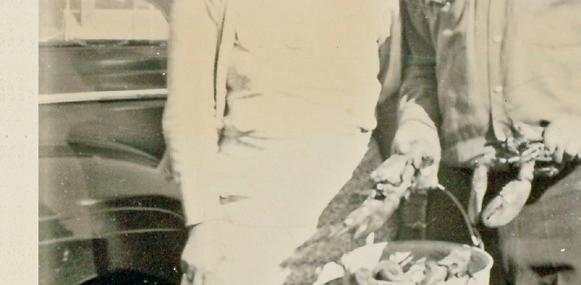





Most people who know of the northeaster of February 17–18, 1952, will likely associate it with the loss of the SS Pendleton and the SS Fort Mercer. Tankers the size of football fields, they had been sailing northward to New England. On the morning of February 18, each ship cracked in two and foundered 20 miles off Cape Cod. The stories of their rescues and losses made Coast Guard history. A film, The Finest Hours, tells the heroic tale of the SS Pendleton. Still, it was far from the most dramatic storm in New England’s history. But it’s the drama that happens to ordinary people, to ordinary families, to ordinary towns—stories often not pressworthy—that become footnotes, if not chapters, to that bigger saga of civilization. It’s the stuff novels are most often built from: the commonplace of everyday lives when disrupted. What rises from the chaos deserves remembering.















































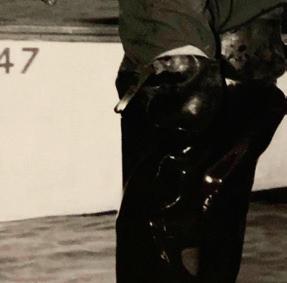
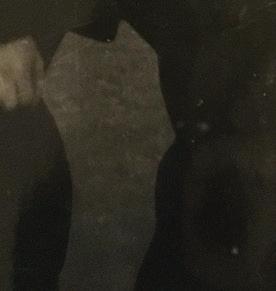







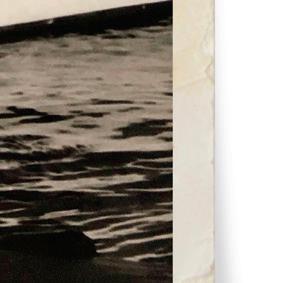

Villagers along the seacoast and inland had heard on their radios the latest weather update from WPOR in Portland, that a heavy storm was estimated to hit Maine the next day. The northeaster would impact mostly the northern part of the state. The rest would see a “mild amount” of snow that would turn to rain.

In Portsmouth, New Hampshire, a busy seafood wholesaler named Jimmy Haigh made plans to leave after midnight and drive his truck to Maine, where he would meet up with one of his lobster suppliers. At 38, Jimmy had been a loom fixer in the local woolen mill when he and Eleanor Jackson first married. But he missed the ocean. Now Jimmy was doing what he loved, and his company was thriving.
He stored his lobsters in “cars,” wooden crates with slats, in the back channel of the Piscataqua, a tidal river that marked the boundary between Maine and New Hampshire. Those holding boxes kept them alive until he delivered them to local restaurants and grocery retailers such as A & P supermarkets. He and Ellie were running the James B. Haigh Lobster Co. mostly in the kitchen. A large cooker of lobsters would be dumped into the open sink. Even their 9-year-old daughter, Barbara Ann, helped. Jimmy taught her how to remove the meat from the shell without breaking it. That’s how his clients wanted it.

He had plans to meet his lobster supplier Harland Davis in Port Clyde before dawn. They would be in Harland’s 30-foot boat and on the way to Monhegan Island before 6 a.m. The catches of the island’s fishermen would fill 50 crates, each one weighing up to 100 pounds. There was a wharf with a mechanical hoist at Port Clyde. If all went well, they would load the filled crates from the boat into Jimmy’s insulated truck. He could pay Davis and be on the road back to New Hampshire before 3 p.m.
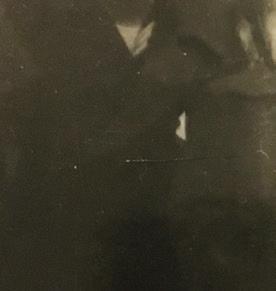
Harland had grown up with lobster traps, wooden crates, trap lines, and bait barrels. His father was a lobster fisherman. His grandfather had carried lobsters from coastal communities and offshore islands that he would then sell on the wharf. Fishing was in Harland’s blood.
With brownish-blond hair and dark blue eyes, Harland had been class valedictorian of Thomaston High School. In 1950 he married Alice French Church—blond and vivacious, the mother then of a 7-year-old daughter. Now Harland had the added responsibility of being a good father. It was a duty he relished.
The latest forecast had predicted a few inches of snow turning to rain. The ocean might be rough in patches
some gusts between Port Clyde and Monhegan. But Har land had spent much of his 30 years in a boat on the open water. A bit of wet snow was nothing to worry about.
Paul Delaney enlisted in the Navy on October 10, 1950. He had just turned 19. When the good-looking New Yorker with dark wavy hair and hazel eyes turned up at the U.S. Naval Radio Station at Winter Harbor, Maine, in late 1951, he seemed a good candidate for the commander’s prediction about the young men assigned there. “You will do one of three things while you are here,” the commander told incoming sailors. “Marry one of the local girls, have a car accident, or re-enlist.”
The last thing on Paul’s mind was marriage. But he had met a pretty girl from Bar Harbor. Her name was Mona. The next day was a Sunday, and Paul was off-duty. So he asked a roommate if he could borrow his car.
“Just don’t wreck it,” the roommate replied, and tossed Paul the keys.
Paul would leave for Bar Harbor before noon. He had plans to invite Mona for a bite to eat after the matinee was finished. Her name reminded him of Nat King Cole’s big hit, “Mona Lisa.” He wasn’t looking for a permanent girl friend, not yet. But Mona was so pretty, and she had a smile that made you wonder what she was thinking, just like words to the song.
Jimmy watched as Eleanor packed sandwiches and dough nuts into a paper sack for the trip. He would leave Ports mouth after midnight and didn’t want to wake her.
“Stay in bed when I leave, Ellie,” he said. But he knew she would be up after midnight to make hot cocoa for the thermos that would ride on the seat next to him.
His wife had told him that morning she didn’t feel good about this trip. She couldn’t explain it, but a dark mist had hung over her all day.
“Jimmy, I’m worried,” she said.
“I’ll be home by suppertime,” Jimmy assured her.
He went upstairs to kiss Barbara Ann good-night. On impulse, he leaned down and kissed her a second time.
In their bedroom, Ellie said nothing more about the trip. Jimmy took off his eyeglasses and laid them on the nightstand next to Barbie’s school picture. It was time to get some sleep.
It was getting late, but Harland had his boat, the Sea Breeze, ready for morning. Like his grandfather, Harland was a land-based dealer, a go-between agent for fishermen and wholesalers. He was liked and trusted by those men. After all, he was one of them.
get these out of the boat,” Harland said. He and Haigh began lifting empty crates up to the hands above that accepted them. The sky was on its way to being overcast. Fishermen know skies. Time was of the essence.
He walked up the narrow road to his trailer. He had bought the small mobile home and moved it onto a parcel of land before he and Alice married. There was even a tiny bedroom for his step-daughter. They could save money for a future house that way, and they would soon need one. Alice was almost four months pregnant.
Across the road from his trailer sat the farmhouse where his parents still lived. Harland had been born in that house. His life had always been in Pleasant Point. His future would be, too.
Just after 5 a.m. Harland Davis buttoned his burgundyand-gray barn coat and left Pleasant Point in his boat, heading to the wharf at Port Clyde, two miles distant. The morning was breaking clear, the ocean calm with small wavelets unfurling in a light wind. He steered the Sea Breeze into the water and then opened the throttle. Harland could have asked Jimmy to meet him at his own wharf. Just three years old it was 134 feet long, an impres sive sight. He and a few friends built it from locally milled spruce. The writer Elizabeth Ogilvie had published a book a few months earlier that mentioned it, and how Harland had painted the derrick bright orange. But Port Clyde wharf was closer to Monhegan. That “mild amount” of snow and rain predicted for coastal Maine was best avoided on the open water. The faster the job got done, the sooner they would be back on the mainland.
Port Clyde loomed up ahead. Jimmy Haigh was waiting. He had brought empty crates with him from New Hamp shire to swap for the full crates waiting on the island. He and Harland loaded them into the Sea Breeze. The men had bundled up against the sharp wind, both wearing winter coats and heavy rubber boots.
The Sea Breeze was a few miles past Burnt and Allen islands when the sun broke over the water. Straight ahead Monhegan’s lighthouse appeared out of morning mist,
“Let’sPHOTO CREDITS: PP. 94-95, COURTESY OF PAUL WERNER OF WEST BATH (BLIZZARD); PP. 96-97, MICHELE ALICE RYAN (ALICE & HARLAND DAVIS); BILL WILSON (DAVIS IN BOAT): KATHLEEN DELANEY MCNAMARA (DELANEY); BARBARA ANN HAIGH (HAIGH)
perched on a hilltop. The lobstermen were waiting. It was not yet 9 o’clock when Harland edged his boat up to the Monhegan wharf. The lobsters would be stored in a pen submerged below a floating wooden raft. They would be already plugged, a wooden peg inserted in each crusher claw.
“Let’s get these out of the boat,” Harland said. He and Jimmy began lifting empty crates up to the hands above that accepted them. The sky was on its way to being over cast. Fishermen know skies. Time was of the essence.
When Paul Delaney first met Mona three weeks ear lier and asked if he could take her to a movie, she seemed pleased. Bar Harbor was famous for its Art Deco theater called the Criterion. Paul had driven over there a few times already to see a movie and check out the pretty girls. Mona had been sitting with her friends in Harris’s Soda Shop.
By the time he saw the Bar Harbor welcome sign, snow flakes were melting on the windshield. That was fine so long as it didn’t turn into a storm. Otherwise, it would depend on Mona how late he left to return to Winter Harbor.
It was not yet noon. Harland and Jimmy had the Sea Breeze loaded. The 50 lobster crates were stacked on top of each other on the stern deck, an area eight feet wide and 12 feet long. Five thousand pounds was a heavy load for a boat that size. Harland had paid his fishermen with checks. He and Jimmy would settle their own bill in Port Clyde. The sky was now dark, winds bearing down, ocean swells growing larger. Since those winds were coming from the northeast, Harland’s plan was to get in the lee of Burnt Island on its western side. They would be better sheltered there. He would then cross to Marshall Point. This route would take them past the Old Man Ledge whistling buoy. The Mon hegan fishermen had said, “Don’t risk it, Harland. Stay here until the storm passes.” But all seasoned fishermen took a chance on the ocean now and then.
There were considerations all around, and Har land and Jimmy discussed them. If the storm didn’t pass quickly it would mean spending the night on Monhegan. Jimmy needed to get those lobsters back to Portsmouth for his Monday-morning clients. In the end, the deci sion belonged to Harland Davis alone. He owned the Sea Breeze . He was no fool. Jimmy Haigh was no fool. They believed they could beat the northeaster to the mainland. They put on their life jackets and said their good-byes. The fishermen stood on the wharf and waited until the Sea Breeze disappeared from view.
They were almost halfway to Port Clyde when they met the storm’s true wrath. It was now half past noon. The horizon had disappeared in a cloud of wet snow. The run
ning lights were useless to cut through the spray. Waves washed over them, each time filling the boat with more seawater. The only protection Harland and Jimmy had was inside the tiny cab. At the helm, Harland gripped the wheel. He needed to maintain enough headway to keep the bow up. It was now impossible to see beyond a few feet. Each time a wave crashed over the bow, Harland fought to stay on course. He needed to get in the lee of Burnt Island, but he was being blown off-course.
Water was rising in the narrow spaces around the lobster crates and streaming through their slats. They knew they had to lighten the load. While Harland stayed at the helm, Jimmy began throwing crates overboard. Wind and waves slammed the crates back against the sides of the boat.
There is no doubt that Harland Davis and Jimmy Haigh realized the odds were against them. They were a couple of miles from land. The boat was overloaded. They knew that even wearing life jackets, it was a matter of minutes before hypothermia would set in. Water spilled over the tops of their boots and their feet and toes grew numb. Icy wind lashed at their faces and stung their eyes.
The boat was submerging, unable to carry both the heavy load and the wind-driven sea. A plunging wave dipped the bow, shorting the electrical circuit. The run ning lights blinked out. Their gloves soaked and their hands freezing, the Sea Breeze was sinking beneath them. A wave slammed a crate back against Jimmy’s right hand, breaking his wrist. His eyeglasses were knocked off and swept into the sea. With the stern of the boat now mostly underwater, he and Harland clung to the spray hood. With little sensation left in their hands, the effort was useless. Maybe in those seconds before the mind-numbing cold set in, Harland shouted, “Hang on! They’ll find us!” Maybe Jimmy shouted it. Then a wave carried them both away from the boat and into the sea.
In a few minutes their thought processes would become jumbled and confused. But while they hoped, while they prayed, they floated like human corks in an uncaring sea.
As moviegoers filed out the front door of the Criterion, it was snowing hard enough that Paul should have been concerned. But he was 21 years old, and Mona was pretty. They walked to Harris’s Soda Shop. When the warm café finally closed, the young sailor realized he should get on the road. On the street, Paul saw three more inches of fresh snow on the sidewalk. He thought of kissing Mona goodbye and then, reading her reserve, decided to wait. She had already agreed to a second date when he had his next week end pass. On impulse, Paul gave her a quick good-bye hug that she didn’t seem to mind.
(Continued from p. 38)
oven for 10 more minutes. Finally, toss the cauliflower and/or broccoli florets with the olive oil and seasonings, and add them to the baking sheet. Roast until all the vegetables are tender, about 10 minutes more. Remove from
Set the skillet with the cheese on the top rack and cook, checking often, until it’s melted and bubbling, 8 to 10
To serve, arrange the roasted veg etables, baguette slices, and ham on a platter or cutting board. Set the cheese in the center of the table with the pick les and mustard on the side. Let your guests spoon some cheese onto their plates to eat with all the accompani

Juice from oranges
¼ cup balsamic vinegar
1½ tablespoons honey
2 teaspoons Dijon mustard
1½ teaspoons kosher salt
1 teaspoon garlic, chopped
½ cup olive oil
Cut 1/4 inch off the top and bottom of the oranges. Set them on a cutting board and be sure to save any juices as you cut them into segments: Working from top to bottom, carefully cut away the peel and pith of each orange, fol lowing the curve of the fruit. Using a small, sharp knife, remove each indi vidual orange segment, leaving no pith or membrane attached. Lay the orange segments on a plate and set aside.
New England–based makers of raclettestyle cheeses include Jasper Hill Farm’s “Whitney” cheese from Vermont, Josh Pond’s “Rocky Lake Raclette” from Maine, and Swallow Ridge Farm’s “Swallow Ridge Raclette” from New Hampshire.
10 ounces raclette cheese, cubed 5 carrots, peeled and cut into batons Olive oil
Kosher salt
Freshly ground black pepper 1½ pounds baby potatoes, halved 12 ounces cauliflower and/or broccoli florets 8–10 ounces prosciutto, or other ham of your choice
1–2 baguettes, sliced Gherkin pickles or other pickles of your choice Grainy mustard
Preheat oven to 425 °F and set racks to the upper- and lower-third positions. In a small, oven-safe skillet (preferably cast iron), arrange the cheese cubes in an even layer. Set aside.
In a medium bowl, toss the car rots with olive oil, salt, and pepper. Arrange the carrots on a rimmed baking sheet and roast on the bottom rack for 10 minutes. Meanwhile, in the same bowl, toss the potatoes with the olive oil and seasonings. Remove the carrots from the oven and add the potatoes to the baking sheet. Return to
Salty, sweet, and tart, this salad is both hearty and refreshing, the perfect counter point to a rich winter meal.
Note: You can make this salad with store-bought precooked beets, or you can cook your own: Put beets in a large pot and cover with 3 inches of water. Add 1/2 cup of kosher salt and bring to a boil. Reduce to a simmer and cook until beets are tender, 30 to 40 minutes. Let cool, then peel.
3 large oranges (preferably a mix of regular and blood oranges)
6 medium cooked beets (preferably a mix of red and gold), cut into ¼-inch-thick wedges
½ medium red onion, cut into thin wedges
½ cup crumbled feta
½ cup chopped walnuts
¼ cup roughly chopped parsley and/or mint
Pour the accumulated orange juice into a small bowl, squeezing the left over membranes to extract any juice. Whisk in the vinegar, honey, mus tard, salt, and garlic. Drizzle in the oil, whisking as you go. Set aside.
In a large bowl, toss the beets, onion, and orange segments with half of the dressing. Divide among 4 to 6 serving plates, and sprinkle with equal portions of feta, walnuts, and parsley or mint. Serve with extra dressing on the side. Yields 4 to 6 servings.


You can grill these flavor-packed skewers outdoors, but we’ve adapted the recipe so it can be made using your oven’s broiler.
2 tablespoons kosher salt
2 teaspoons ground black pepper
2 teaspoons garlic powder
2 pounds pork tenderloin






























1 cup maple syrup























½ cup apple cider vinegar











































2 teaspoons Dijon mustard























3 large cloves garlic, minced
2 teaspoon black pepper

1 teaspoon kosher salt

First, prepare the pork: In a small bowl, stir together the kosher salt, pepper, and garlic powder. Set aside.
Slice the pork loins crosswise into 2½-inch-high medallions. Now cut each medallion lengthwise into ¼-inchthick strips. Toss the pork strips with the kosher salt mixture and refrigerate for at least 15 minutes and up to 1 hour.


Now, make the marinade: In a large bowl, whisk together the syrup, vinegar, mustard, garlic, pepper, and salt. Add the pork and stir until all the pieces are fully coated. Wrap and refrigerate for at least an hour and up to 8 hours.



Set your oven’s broiler to high heat







and set a rack about 3 inches from the heating element (alternately, prepare a grill for medium-high heat).

Remove the pork from the marinade and thread it onto the prepared skewers, leaving an inch at the base.
Transfer the marinade to a small saucepan and bring to a rolling boil, then reduce the heat to low and cook for 5 more minutes. Set aside.
Arrange the skewers on two foillined rimmed baking sheets and broil for 2 minutes (if using a grill, lay the skewers directly on the grates), keeping a close eye as they cook. Turn the skewers over, baste them with marinade, then cook for 2 more minutes. Repeat this process of turning and basting until the meat is fully cooked and browned all over, 4 to 6 minutes longer. Yields 6 servings.

Devotees of salted caramel will really love the flavor and ease of preparation of this pudding. Sarah Pike’s grandmother Mom-
¾ cup brown sugar
5 tablespoons all-purpose flour
½ teaspoon table salt
2 cups whole or 2% milk
2 large egg yolks
2 tablespoons unsalted butter, cubed
1 teaspoon vanilla extract
4 graham crackers
2 tablespoons salted butter, melted Whipped cream
In a large saucepan over mediumhigh heat, whisk together the brown sugar, flour, and salt. Slowly whisk in the milk until the mixture is smooth and loose. Let it cook, whisking constantly, until it begins to thicken. If it begins to boil, reduce the heat. Let the mixture cook, stirring occasionally, for 4 more minutes.
In a small bowl, whisk the egg yolks together. Slowly ladle about ½ cup of the hot pudding mixture into the yolks, whisking constantly. Pour this mixture back in with the pudding and stir for 1 minute. Add the butter and vanilla, stir until smooth, then remove from heat to cool.
In the bowl of a food processor or blender, pulse the graham crackers together with the melted butter until the mixture looks like wet sand.
Divide the pudding mixture among 4 to 6 small glasses. Cover and set in the refrigerator to chill at least 1 hour and up to 1 day.
Just before serving, sprinkle parfaits with graham cracker mixture and top with whipped cream. Serve cold. Yields 4 to 6 servings.
suites have wood-burning fireplaces, as does a one-room cottage on the 27-acre property. Individually prepared breakfasts are a standout—no cereal dispensers here—and in the afternoon, teatime beckons in the fireplaced library. blackberryriverinn.com


CAPTAIN DANIEL PACKER INNE, Mystic. Captain Daniel Packer built his imposing gambrel-roofed inn on the Mystic River in 1756, and its great central chimney has been part of the Mystic skyline ever since. Eighteenthcentury travelers along the Connecticut coast warmed themselves at Captain Packer’s firesides, as do today’s diners and pub patrons at the Captain Daniel Packer Inne, a popular venue for live folk music and jazz. danielpacker.com




FRESH SALT, Old Saybrook . At Saybrook Point Resort & Marina’s restaurant, diners can be forgiven for not focusing on the big stone fireplace—the views of Long Island Sound just might take precedence. That view is also a reminder of where your dinner might be from, since fresh seafood dominates the menu. It might also be where you came from, if you arrived via the resort’s “Dock & Dine” arrangement. saybrook.com
THE GRISWOLD INN, Essex . The Griswold Inn began welcoming guests in 1776, back when piling logs on the fire was the best—the only —way to escape the grasp of a New England winter. Winter is still with us, and so is hearthside cheer at “the Gris.” There’s a welcoming blaze in the Tap Room, a cozy spot featuring live music, and suites at the inn all feature wood-burners. griswoldinn.com
HOUSE OF 1833, Mystic. All five guest suites in the colonnaded Greek Revival House of 1833 are warmed by woodburning fireplaces (yes, there’s also central heating). With curtained fourposter beds and lavishly upholstered Victorian chairs and settees, the hearthside environment is so cozy and comfortable that it might be an effort to descend the gracefully curving staircase to breakfast. houseof1833.com
STONECROFT INN, Mystic. Here, take your pick of accommodations in two distinctly different buildings: the stately 1807 House, with four guest rooms including three graced with original wood-burning fireplaces (there are more wood-burners in the common rooms), and the Yellow Barn, a massive post-and-beam structure where modernity wins out with gas fireplaces and televisions. stonecroft.com

WINVIAN FARM, Morris. Fireplaces abound at the Relais & Châteaux Winvian Farm, located on 113 secluded acres in the Litchfield Hills. Accommodations are limited to 18 luxurious individual cottages and one suite; each cottage has an individual style, from Craftsman to Log Cabin to the two-story, book-lined Library. Each features a wood-burning hearth (well, the cottage set in a restored 1948 helicopter has a woodstove). Dining? Fireside, of course. winvian.com





THE FARMHOUSE TAP & GRILL, Burlington

The downstairs parlor is the cozy place to dine or sample one of Vermont’s most extensive beer menus at the Farmhouse Tap & Grill. When the winter winds are blowing off Lake Champlain, there’s nothing like the combination of a roaring fire and a pint of porter or stout: Thirty taps dispense a seasonally adjusted cascade of suds from the likes of Lawson’s Finest Liquids and Hill Farmstead breweries. farmhousetg.com
HIGHLAND LODGE, Greensboro. The Highland Lodge on Caspian Lake has the feel of a comfortable country grandma’s house, c. 1948. After dinner—and, ideally, after a day on the lodge’s cross-county ski trails—head for the snug little library in a corner of the main floor. You likely won’t pick one of last week’s best-sellers, but you’ll read, and maybe doze, alongside the crackling corner fireplace. highlandlodge.com
THE PITCHER INN, Warren . Tiny Warren nestles against the Mad River near two famed ski areas, Sugarbush and Mad River Glen. Its crown jewel is the Pitcher Inn, a Relais & Châteaux property renowned for fine dining and for its no-two-are-alike nine rooms and two two-bedroom suites. Each reflects a different aspect of Vermont’s outdoor experience, such as skiing, fishing, and mountain-lodge life, and each boasts a wood-burning fireplace. pitcherinn.com
SKUNK HOLLOW TAVERN, Hartland Housed in one of the village’s oldest buildings, Skunk Hollow harks back to when taverns were the heart of New England country towns. There’s a fullservice restaurant upstairs, but if it’s cozy you seek, hit the downstairs pub, where the fireplace radiates a mellow glow beneath rough-hewn beams. Order yourself a local brew and (if you’ve planned your visit wisely) enjoy live jazz. skunkhollowtavernvt.com
TOURTERELLE, New Haven . There’s a New Haven in Vermont, too—it’s
north of Middlebury and is the home of Tourterelle, a chef-owned bistro with a country French menu. Bouillabaisse, steak frites, wagyu burgers, and housemade charcuterie especially hit the spot at fireside, and a handsome stone hearth is here to oblige. tourterellevermont.com
TRATTORIA DELIA, Burlington . Back when the building housing Trattoria Delia was a hotel, the downstairs tavern was designed to resemble an old-time sugarhouse—in fact it was a former sugarhouse, moved here from New Hampshire. Centered around a handsome stone hearth, the room has for a quarter-century been the home of the Queen City’s premier Italian restaurant. trattoriadelia.com
WOODSTOCK INN & RESORT, Woodstock . The massive hearth that commands the lobby of the Woodstock Inn seems capable, if the front doors were thrown open, of heating the resort town’s entire village green. Downstairs, the inn’s snug Richardson’s Tavern features its own fireplace, in a dining atmosphere suggesting the den of a country estate. woodstockinn.com




CHATHAM INN, Chatham . Cape Cod’s only Relais & Châteaux property is the grand luxe hostelry at the Cape’s scenic elbow. Nine of its 18 rooms feature wood-burning fireplaces, and firelight also cheers Cuvée, the inn’s fine-dining restaurant, and its awardwinning wine bar. Still craving more fireside enchantment? On the terrace, overlooking Chatham’s historic Main Street, a firepit takes the chill off Cape Cod summer nights. chathaminn.com
GARRISON INN, Newburyport. This star of the small-hotel revival on the North Shore features several guest rooms with wood-burning fireplaces, including a two-story gem with 15-foot cathedral ceilings. The inn’s name, by the way, honors Newburyport native and prominent abolitionist William Lloyd Garrison—thus the “Liberator” name for the handsome room in which complimentary full breakfast is served. garrisoninn.com

GIBBET HILL GRILL, Groton . This restaurant is the pièce de résistance of 500-acre Gibbet Hill Farm, source of many items on the menu—the farm-totable distance here is a short one indeed. At the center of the grill’s post-andbeam dining room, a massive doublesided stone hearth and chimney rises for two stories. gibbethillgrill.com
LENOX HOTEL, Boston . The crown jewels of this Back Bay luxury hotel




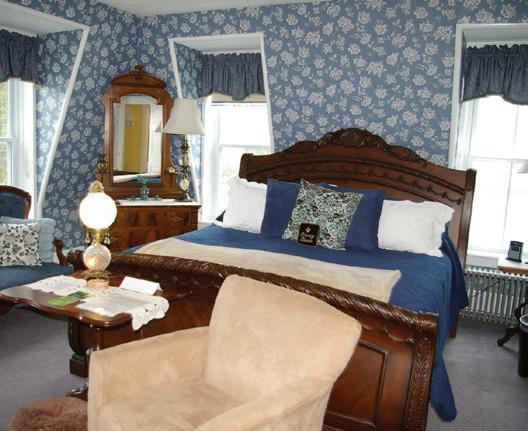

Book Direct or Online 802-875-4288 innvictoria.com 321 Main St. • Chester, VT ~
Guests with electric vehicles may charge them for free at the Inn Victoria charging station.
An Historic 1851 B&B with all the modern amenities ~ Trip Advisors Travelers’ Choice Award 2021INN VICTORIA TO GOLDEN STAGE INN (13 miles) Chester, VT 802-875-4288
InnVictoria.com
GOLDEN STAGE INN TO THE GOVERNOR’S INN (10.7 miles)
Proctorsville, VT 802-226-7744
GoldenStageInn.com
THE GOVERNOR’S INN TO THE COLONIAL HOUSE INN & MOTEL (6.7 miles)
Ludlow, VT 802-228-8830

TheGovernorsInn.com
THE COLONIAL HOUSE INN & MOTEL TO INN VICTORIA (10.8 miles) Weston, VT 802-824-6286
CoHoInn.com

www.VermontInntoInnWalking.com • 833-Inn-2-Inn (833-466-2466)



are its Executive Fireplace Rooms, 450-square-foot sanctuaries graced with fully functioning wood-burning hearths. Room service in a gracious urban hotel is always a special luxury, but when the knock on the door heralds prompt delivery of a supply of bonedry firewood and a hand lighting the blaze, that’s a different order of posh. lenoxhotel.com
THE PUBLICK HOUSE, Sturbridge
Cavernous hearths yawning six feet across were commonplace in New England’s earliest homes and inns, and the fireplace in the Tap Room at the Publick House is a spectacular surviving example. Long a favorite with visitors to nearby Old Sturbridge Village, the inn also offers accommodations in its 18th-century main building and in three adjacent structures. publickhouse.com
SALEM CROSS INN, West Brookfield
Central Massachusetts’s Salem Cross Inn, a restored farmhouse set on 600 acres, not only offers fireside dining, but—on several winter dates—also hosts a “Fireplace Feast,” with chowder, prime rib (turned on a 300-year-oldplus roasting jack), and apple pie, all prepared in open-hearth colonial style. While the cooks are at work, enjoy a horse-drawn sleigh ride. salemcrossinn.com
THE WAYSIDE INN, Sudbury. Like Chaucer’s Canterbury Tales, Henry Wadsworth Longfellow’s Tales of a Wayside Inn features stories told by sojourners at an inn—in this case, a real one that remains popular with travelers today. The Wayside Inn has stood on the coach road linking Boston with points west for over 300 years, and still offers fireside dining and snug quarters for overnight guests. wayside.org
BLIND TIGER, Portland . “Blind tiger” used to mean a speakeasy, but patrons of the Blind Tiger in Portland speak enthusiastically about this gracious guest house occupying a stately Victorian mansion in the city’s vibrant heart. Seven rooms have fireplaces, and the “Bon Viveur” suite offers two—one in the bedroom and one in the parlor. larkhotels.com
CHILTERN INN, Bar Harbor. Occupying a former ambassador’s estate dating to 1906, the Chiltern Inn features two of the most exquisitely furnished rooms in town, done in Colonial Revival style with block-front chests, brokenpediment highboys, four-poster beds, and wood-burning fireplaces. Quite the
contrast with the inn’s indoor lap pool— but to get back into the 18th-century groove, retreat to the fireplaced library loft. chilterninnbarharbor.com
FORE STREET, Portland . The massive hearth at the heart of this acclaimed restaurant isn’t just for show. It’s where fresh fish, meats, and vegetables are grilled, roasted, and turned on a spit over a blazing fire. Visible from almost every table, this hearth provides its own form of dinner theater. Fore Street owner Sam Hayward was an early pioneer in the locavore movement, so his live-fire cooking always begins with exceptional ingredients. forestreet.biz
HARRASEEKET INN, Freeport. Visitors to Freeport do occasionally tear themselves away from outlet shops, and from a certain purveyor of outdoor equipment and clothing. A cozy respite from all that shopping is the Harraseeket Inn, among whose 94 rooms are 23 with woodburning fireplaces. Can’t stay away from the glow? Dine at the Inn’s Broad Arrow Tavern, with its own blazing hearth harraseeketinn.com
THE INN AT BATH, Bath. If anything tops an inn room with a fireplace, it’s a suite with two fireplaces. That’s an option at the Inn at Bath, for guests with the foresight to reserve the inn’s Cabin and Garden rooms, which can be combined into a suite. Along with wood-burning hearths, each includes a two-person whirlpool tub. The Greek Revival inn stands in Bath’s historic district, and the Kennebec River is steps away. innatbath.com

INN ON THE HARBOR, Stonington . The Heritage and the Victory Chimes rooms overlooking Penobscot Bay at the Inn on the Harbor feature wood-burning fireplaces—a prime amenity for guests who linger into the seaside evenings on the private and semi-private decks adjoining several rooms. A bonus: Accommodations with a bay view come with binoculars, great for spotting the windjammers for which the rooms are named. innontheharbor.com
RÍ RÁ, Portland . This establishment handsomely does its part in the small chain’s mission to bring Irish pub life to America, with a copious beer lineup deep with Maine brews and a certain dark Celtic elixir. There’s a pub menu with a modern accent, live music on weekends, and—hurry, grab a seat—a snug upstairs lounge where logs crackle on a stone hearth. The harbor views aren’t bad, either. rira.com
The Common Man Inn & Spa in the college town of Plymouth features this wine bar that once was—as its name suggests—a boiler room. There’s no boiler here now, just an inviting fireplace set into exposed brick walls, an ample pub menu, and an extensive selection of New England beers and craft cocktails. thecman.com
THE LIBRARY, Portsmouth. A necessary exception to our wood-burning-fireplace
rule is The Library, a long-popular steakhouse whose lavishly wood-paneled quarters define baronial splendor. Gas-fired hearths grace both the white-tablecloth dining room and the cozy lounge, where patrons can claim a leather armchair by the fire and sample one of 96 martinis on the bar menu. libraryrestaurant.com
THE MANOR ON GOLDEN POND, Holderness. Savvy visitors to the lake country know that “Golden Pond” is actually Squam Lake, and forgive the Manor on Golden Pond’s borrowing the beloved film’s title. Small matter—what counts is this inn’s comfy, rustic feel, with a dining room warmed by a wood-burning hearth with green-tiled surround, and the relaxed guest rooms upstairs, many with their own wood-burners. manorongoldenpond.com
The magnificently restored Mountain View Grand has built a reputation around its luxe rooms, tower spa, wine cellar dining, and golf course—but it’s the homier pleasure of s’mores around a campfire that makes a winter stay extra-special. The s’mores fixings are complimentary; guests provide the appetite after a day of cross-country skiing, snowshoeing, dogsledding … or a round of axe throwing. mountainviewgrand.com
NOTCHLAND INN, Hart’s Location . Way up in the White Mountains, a cornerstone of the Notchland Inn’s century of hospitality is its wealth of wood-burning fireplaces. There’s one in each of the inn’s 13 rooms and two cottages; another in the music room; and the grandest hearth of all, a front parlor stunner designed, along with its surroundings, by Arts and Crafts master Gustav Stickley. notchland.com
PINE, Hanover. Trading wood for gas is the price of admission to the Ivy League— vicarious admission, that is. The gasburning fireplace in question belongs to Pine, the celebrated restaurant at the Hanover Inn facing the Dartmouth campus. Offering breakfast, lunch, dinner, and a bar menu, the college town’s most innovative kitchen relies heavily on local meats, dairy, and produce. pineathanoverinn.com
Built as a carpet tycoon’s summer home in 1874 and a luxurious inn for over 70 years, Stonehurst Manor has wood-burning fireplaces throughout. Eight of the sixteen rooms in the main inn have working hearths, as does the main dining room and Library Lounge. There’s also an outdoor firepit, especially welcome for guests enjoying the Ice Bar set up outdoors each winter. stonehurstmanor.com
from p. 99)
In a few minutes he had reached the foot of Ireson Hill. Halfway up the hill, the car fishtailed. Panicked, Paul hit the brakes. He sat help less behind the wheel as the car slid backward. At the bottom of the hill it skidded, spinning out into a ditch filled with snow. He pushed open the driver’s door and got out. Snow bil lowed in gusts. There was no way he could back the car out of that snowfilled ditch. Because of the pound ing storm, he didn’t see the lights of a residence sitting 150 feet away. Just as he hadn’t seen the sign at the foot of the hill that warned detour . Even locals didn’t want to challenge Ireson Hill in a snowstorm.
Sailors had been trained when they arrived at the Maine station to carry supplies in one’s vehicle dur ing the winter months in case they became stranded in a snowstorm. But no one paid much attention. Paul had brought two bottles of orange soda pop with him. He already drank one on the drive over and intended to drink the other on the return. But the plow would be along any time and would pull him out. He wished now he’d bought a candy bar after the movie. His good luck was that there were two blankets in the back seat. He could run the engine but he wanted to save fuel for the trip to Winter Harbor. At least he had bought that pack of Chesterfields at the theater. He lit one and smoked it with the narrow vent window pushed open. When he finished, he flicked the butt out into the snow and closed the window. He lay beneath the blan kets to wait. In minutes he dozed off.
The Coast Guard station on Burnt Island sat five miles from Port Clyde and seven miles from Monhegan Island. At 1:15 p.m. the telephone rang at the station. It was Riley Davis of Pleasant Point calling about his son, Harland. He had left Monhegan at 11:45 a.m. with a load of lobsters.
With him was a buyer from New Hampshire. They were in a 30-foot boat with the registration number 1-L-668. Could the Coast Guard be on the lookout for Harland’s boat? The station’s commander, Weston Gamage, figured that Davis may have planned to pass Georges Islands on the western side in order to take advantage of the sheltered lee. If he got in trouble near the Old Man Ledge buoy whistle, the northeast winds would push the boat west of it. That was the best place to start looking. In this weather, they would need the 36-foot self-righting life boat. Should it turn over in the worst of storms, it would immediately roll back to an upright position.
“Get out the boat,” Weston said to his crew.
With Weston at the wheel, the craft headed toward Old Man Ledge one and a half miles away. A halfmile west of the buoy, he and his team came upon the spray hood of a boat that was mostly submerged. Visible in the spotlight on the starboard side was the number 1-L-668. Wooden crates filled with lobsters bobbed in the water around the boat. There was no sign of the two men. Weston began a search of the area, circling as the spotlight combed the waters, wid ening his path with each pass. Five minutes later, he spotted a man float ing in a life jacket.
Holding the boat hook—a 6-foot pole with a 9-inch rounded brass hook at its end—a member of Weston’s crew leaned over the side of the lifeboat. He was able to latch the hook onto the life jacket of the man in the water. Quickly, he pulled the body up to the side where two other crew members waited. They lifted the unmoving man from the freezing water and onto the deck. The man— Davis or Haigh, they had no idea— showed no visible signs of life.
There was nothing left to do but wrap the cold body in blankets and go back to the rail, hoping Weston could find the second man. Ten minutes later, the spotlight’s beam lit up another body bobbing inside a life jacket. Again the hook with its rounded tip pulled the limp man over to the boat. Beneath his life jacket he was wearing a burgundy-and-gray barn coat. Harland Davis.
It was 2:55 p.m. when Weston turned the boat toward Port Clyde. He radioed ahead that the Coast Guard was bringing in two uncon scious men, fishermen who had been to Monhegan. He requested that firemen from Rockland be waiting with their rescue-breathing appara tus. He also asked for a doctor and an ambulance.
Survivors in near-death situa tions have reported that the human brain becomes distorted with ran dom thoughts, even a sense of selfatonement. “How could I have let this happen? What will my friends say?” For still others, they relive a speeded-up film clip of their lives. Whatever their last thoughts were, both Harland Davis and Jimmy Haigh would have heard, at least for a time, the sound of the whistling buoy at Old Man Ledge, its constant cry produced by the rise and fall of the sea. Hypnotizing. Over and over again. The whistling buoy, like a mother’s lullaby.
When Paul woke he was shivering, and it was dark. How had it gotten so dark? He pulled his cigarette lighter from his coat pocket and flicked it on.
At the end, Harland Davis and Jimmy Haigh would have heard, at least for a time, the sound of the whistling buoy at Old Man Ledge. Hypnotizing. Over and over again. The whistling buoy, like a mother’s lullaby.
His watch read half past 11. He held the lighter up like a torch so he could see in the car. The windshield was solid white. The side windows were all white. The rear windshield was white. “Snow must have drifted over the car while I slept,” he thought. He would get out and brush it off, then see if there were any signs of the plow.
The driver’s door would not move more than a quarter inch. He tried to open the passenger door. It was blocked. He crawled into the back seat. Even using his feet to push on the doors, neither would open more than that small space. How could it be possible that the car was buried in snow while he slept? But it was. He talked to himself to keep calm.
“This is just some bad luck, Paul,” he said. “The plow will see you.”
But how? If the snow cover ing him was deep, not even his brake lights would be visible. He turned the key in the ignition and the engine started. He felt a wave of relief wash over him. At least he could stay warm. He knew not to run the car for more than a few minutes at a time, something else the young sailors coming to Maine had been taught. But the exhaust pipe must be clogged with snow if the entire car was covered. That was dangerous for carbon monoxide poisoning.
Dear Reader,
Feeling the need to urinate, he would use the narrow space where the back door opened into the snow, and do his best to aim well. He and the guys would have a good laugh back at the base. He could hear them now, teasing him about pissing in the snow.
“Keep your cool, Paul,” he whis pered. He lit a Chesterfield and inhaled it, feeling it calm him. It was his good luck that he just bought that pack and only three were gone.
She had put off getting her hair done for days. There was always some thing else to tend to, and she had morning sickness as well. Now, with Harland gone to Monhegan, Alice made plans. Her friend Martha,
The drawing you see above is called The Promise. It is completely composed of dots of ink. After writing the poem, I worked with a quill pen and placed thousands of these dots, one at a time, to create this gift in honor of my youngest brother and his wife.
Now, I have decided to offer The Promise to those who share and value its sentiment. Each litho is numbered and signed by hand and precisely captures the detail of the drawing. As a wedding, anniversary or Valentine’s gift or simply as a standard for your own home, I believe you will find it most appropriate.
Dear Reader, The drawing you see above is called “The Promise.” It is completely composed of dots of ink. After writing the poem, I worked with a quill pen and placed thousands of these dots, one at a time, to create this gift in honor of my youngest brother and his wife.
Measuring 14" by 16", it is available either fully-framed in a subtle copper tone with hand-cut double mats of pewter and rust at $145*, or in the mats alone at $105*. Please add $18.95 for insured shipping. Returns/exchanges within 30 days. My best wishes are with you.
Now, I have decided to offer “The Promise” to those who share and value its sentiment. Each litho is numbered and signed by hand and precisely captures the detail of the drawing. As a wedding, anniversary or Valentine’s gift or simply as a standard for your own home, I believe you will find it most appropriate.
Sextonart Inc. • P.O. Box 581 • Rutherford, CA 94573 (415) 989-1630
Measuring 14" by 16", it is available either fully framed in a subtle copper tone with hand-cut mats of pewter and rust at $110, or in the mats alone at $95. Please add $14.50 for insured shipping and packaging. Your satisfaction is completely guaranteed.

My best wishes are with you.
The Art of Robert Sexton, 491 Greenwich St. (at Grant), San Francisco, CA 94133
All major credit cards are welcomed. Please call between 10 a m -5 p m Pacific Standard Time, 7 days a week. Checks are also accepted. Please include a phone number. *California residents please include 8.0% tax Please visit our website at www.robertsexton.com
MASTERCARD and VISA orders welcome. Please send card name, card number, address and expiration date, or phone (415) 989-1630 between noon-8 P M.EST. Checks are also accepted. Please allow 3 weeks for delivery.
“The Promise” is featured with many other recent works in my book, “Journeys of the Human Heart.” It, too, is available from the address above at $12.95 per copy postpaid. Please visit my Web site at www.robertsexton.com

“Across the years I will walk with you— in deep, green forests; on shores of sand: and when our time on earth is through, in heaven, too, you will have my hand.”
“Across the years I will walk with you— in deep, green forests; on shores of sand: and when our time on earth is through, in heaven, too, you will have my hand,”
“Art to warm your heart & home.”
60 Grandma Moses Rd. P.O. Box 94, Eagle Bridge, NY 12057 1-800-328-6326
FREE color catalog is available featuring Will Moses limited edition Folk Art Prints, Books, Puzzles, Cards & More!
VISA MASTERCARD AMERICAN EXPRESS PROMPT DELIVERY SATISFACTION GUARANTEED Visit us on the web at www.willmoses.com Applicable tax and shipping extra
FREE color catalog is available featuring Will Moses limited edition Folk Art Prints, Books, Puzzles, Cards & More!





VISA MASTERCARD AMERICAN EXPRESS
PROMPT DELIVERY SATISFACTION GUARANTEED Visit us on the web at www.willmoses.com Applicable tax shipping extra
whose husband, Jack, was also a fish erman, ran a tiny one-chair beauty salon out of her house. Martha had pulled the curlers from Alice’s hair and was styling it when the door opened and Jack came in, followed by a gust of wind. “A call just come to the general store,” he said. “The Coast Guard is bringing two fishermen in to Port Clyde. Their boat capsized on the way back from Monhegan.”
Neither woman spoke.
“They radioed ahead for an ambu lance,” Jack added. “And for the fire men to bring that breathing thing they have. But a man couldn’t last long in that water.”
“Jack, no,” Martha said quickly.
Alice didn’t speak. Her brain was trying to untangle the meaning. Monhegan. Two fishermen. Ambulance. It was a Sunday. Who else could it be?
Noticing the stern look Martha was giving him, Jack stood with his cup frozen in midair.
“I have to go,” Alice said. Martha tried to stop her.
“Stay here,” she said. “Jack will go down to Riley’s house and find out.”
Riley Davis. Harland’s father.
“I need to be home,” Alice said. “For when someone calls.”
Martha tried again. “They wouldn’t have asked for an ambulance if it was too late.”
But Alice wasn’t listening. She put the scarf over her perfectly done hair and walked home in the wind and snow to wait for a phone call, or a knock on her door.
There were times she had pleaded with him. Give up fishing, Harland. But, honey, it’s my job. Harland, there are other jobs. None that are in my blood, Alice. She would support him because she loved him. And whenever another fisherman drowned somewhere off the Maine coast, she would try again. There are other jobs, Harland. None that I love, Alice.
The sound of the knock on the door would stay with her forever.
It was Riley Davis, her father-inlaw. There was nothing he needed to say. The pain that lined his face told the burden of his grief. Harland had always brought his father joy, learn
ing the trade at his side, a boy in love with the ocean. The truth as Riley knew it, and as Alice grew to learn, is that there are no other jobs when fish ing is in your blood.
It was 6 p.m. Jimmy was due back two hours ago. Ellie didn’t know who in Maine to call. The phone number Jimmy had for Harland Davis he had taken in the truck with him in case he needed it. She was in the kitchen when someone knocked on the front door. A police officer stood on the steps. Ellie waited as Barbie let him in. He brushed snow from his shoul ders.
“Tommy, what in the world?” Ellie asked. “Is something wrong?”
Tom Barlow had been her class mate in high school. Before he could answer, Ellie realized why her school friend, a policeman , was standing in her house in the middle of a snow storm.
“It’s Jimmy!” she cried. “He’s hurt. Where is he? I’ll get my coat!”
“Ellie, I’ve got bad news,” Tom said. He followed her into the room. “A sheriff called from Maine,” he said. “There was an accident. The boat was caught in this storm. Jimmy didn’t make it.”
“It’s a mistake,” Ellie said, shaking her head.
She turned then and, eyes closed, slammed her head against the refrig erator door, again and again. “Jimmy! Jimmy! Jimmy!” she kept repeating.
The policeman moved closer to Ellie and touched her arm, hoping to calm her.
“He needs to come home!” she shouted.

“There’s a blizzard,” said Tom. “It’ll be a day, maybe two.”
“I want Jimmy home!” Ellie cried again. “Do you hear me, Tommy? I want my husband home!”
The small pine bookcase that Har land had made sat near the sofa, its shelves filled with books on boat design and fishing. Alice pulled out the book that was his prized
possession. My World Is an Island, signed to Harland by the author Elizabeth Ogilvie. Two of the pages were dog-eared where she had mentioned him.
There’s a silvery poplar by the Davis fish house, gleaming and twinkling with every breath of wind. The just-painted mast and boom—bright orange—on Harland Davis’s new wharf stands out brilliantly.... Everybody used to fish off Walter Young’s lobster car; this year, they’re fishing off the float by Harland Davis’s new wharf.
“Dear heavenly father,” Alice said aloud. “This is a heavy grief you have given me. Please forgive me if I fail to measure up.”
She had a daughter to raise, and a baby coming in five months.
The deep stillness woke Paul. What he felt in the car just then, more than saw, was an oppressive blackness, as if light had never existed. He sensed the weight of his mortality then, and it frightened him for the first time in his young life.
“Holy mother of God,” Paul thought. “How much snow is covering me?”
He flicked on his cigarette lighter and held it up as a torch. He tried again to push open the driver’s door. It didn’t budge beyond the original quarter-inch crack. In the light of the tiny flame he saw snow pressed hard against the window. At least with snow blanketing the vehicle as it was, the temperature was bearable. There was just pure, dead silence. He looked at his watch. It was past seven o’clock. That meant morning. Surely they would find him soon. He had been in the car almost 13 hours.
Like a slow wave, word of the deaths had passed over Pleasant Point. Alice knew the local women would do all they could to help her manage Harland’s loss. Some had known that loss themselves. But Alice felt her grief just then was hers alone.
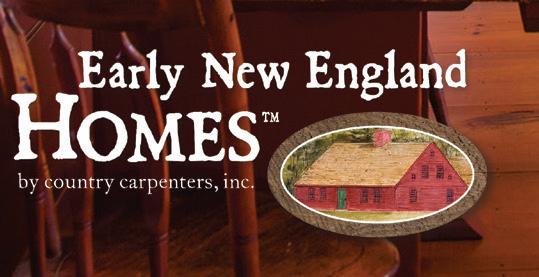

It was Riley Davis at the door,


860.643.1148

that soft knock that always made Alice wonder if it was just the wind. He stepped inside, hat in his hands.
“I come to see if you’re doing all right,” he said. Alice nodded, tears brimming her eyes.
“It’s hard, Riley,” she said. “It’s hard.”
He nodded, his eyes moving to the floor, to the pair of brown slippers that waited there each evening for Harland.
“The funeral place up in Thomaston called,” he said. “That’s where they took him. They figured I’d be the one to talk to, so as not to upset you. I can go ahead and make the arrangements.”
“That’s best,” Alice said. She watched through the window of the trailer door as Riley made his way through the knee-deep snow. He crossed the road that led down to the wharf. He walked toward the lights of his farmhouse where his wife, Eva, was waiting. It seemed to Alice as if he carried his entire life on his shoulders.
Paul was losing his sense of time. He had napped, sometimes thinking it was for 10 minutes, then checking his watch to see that it had been for an hour. Once, he woke certain he heard his little sister calling from her bedroom next door. “Paulie, are you all right?” His watch told him three o’clock. He was certain that meant early morning. He had been in the darkness, smothered in snow, for 30 hours.
As local residents snowshoed down Ireson Hill on their way to town for supplies, they had no way of knowing that beneath the snow now drifted to 10 feet high in the ditch at the foot of the hill was a young sailor buried alive in his car.
A funeral for Harland Davis would be held in Thomaston on Thursday. The
Adapted from Northeaster: A Story of Courage and Survival in the Blizzard of 1952 by Cathie Pelletier. Published by Pegasus Books, January 2023. © Cathie Pelletier. Adapted with permission.
To read Yankee editor Mel Allen’s interview with Cathie Pelletier on researching and writing Northeaster, go to newengland.com/cathie-pelletier.

burial would be in the spring. Spring seemed a long way off. By the time the silver poplar down near Harland’s wharf was green with leaves again, maybe Alice would have a better idea what to do with the rest of her life. The baby was due that summer. Alice needed a plan. So far, there was none on the horizon.
It was morning now, if his calculations were correct. Paul Delaney had been in the buried car for 38 hours. He was overwhelmed just then with the image of his mother’s smiling face. Uncontrollable tears were pouring from his eyes. He crawled into the back seat, emotionally exhausted. He was beginning to sleep more than he was awake.
Barbara Ann watched from the top of the stairs as they carried her father’s casket into the house and arranged it in front of the three windows that formed a bay in the parlor. She had promised herself to be brave for her mother. It’s what her father would want. She recited again the words she had adopted as her motto when she first heard of her father’s death. This is how it’s going to be from now on . This is your new life, Barbara Ann. So be a big girl and don’t cry.
Down in the parlor, Ellie beckoned to Barbie to stand with her at
the casket. Her father looked handsome, his head resting perfectly on a light gray pillow. He wasn’t wearing his glasses, so he looked like he did when he was swimming, or getting ready to go to bed at night.
“So handsome,” Ellie said. She leaned forward and kissed her husband’s face.
Barbie reached to touch the folded hands. “Daddy,” she said.
“Now he’s home,” said Ellie.
Paul was dreaming of a thunderstorm that struck when he had been no more than 10 years old. Standing in front of his childhood home, he watched as an electrical wire snapped and fell near his feet. Paul reached down and picked it up. That’s when he heard his father yelling. “Put it down, Paul! Put it down and get away from there!”
When the tapping noise broke through his dream, he worked toward awareness, finally opening his eyes. Had he heard it? Was it his imagination? There were muffled noises from above, distant. He sat up in the back seat and crawled to the front. There it was again. Tap. Tap. On the roof of the car. He opened a window.

“Help!” Paul shouted, hoping his voice could be heard. “Hey, I’m down here!” No response.
And then he saw the wooden pole cut through the snow just outside his window. He reached for it, but it was gone too quickly. He waited, cigarette lighter in his raised hand in case it came back. There it was again! He grabbed fast and this time caught the pole. He held onto it tightly, letting whoever was up there know he was alive.
Standing on packed snow almost a dozen feet above the car was Howard “Packie” McFarland, Bar Harbor’s chief of police, his son John, and a local officer. They had come to mark the depressed spot where it appeared



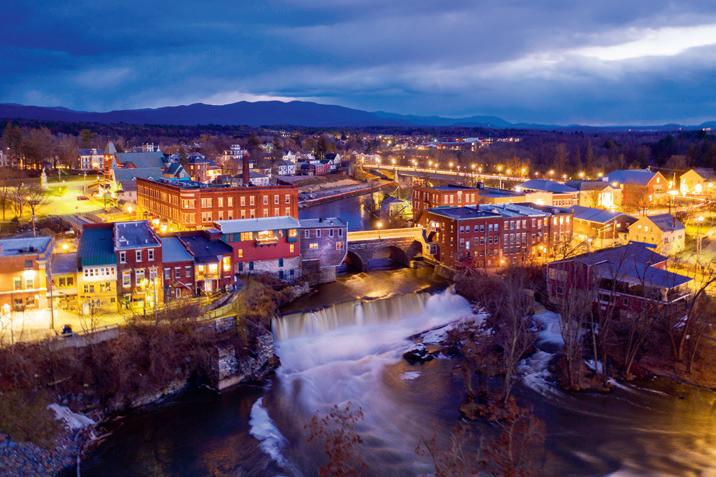
an automobile was buried in drifts so that the plow wouldn’t hit it. Chief McFarland was shocked to feel the weight of a hand grabbing onto the end of the pole he had poked down through the snow.
“We got someone buried here!” McFarland shouted. Workmen who had been clearing the road came quickly with their shovels. Twenty minutes later light broke through the darkness, causing Paul to blink. Gloved hands wiped snow from the windshield and Paul saw two booted feet standing on the hood.
“Who’s there?” he heard a deep voice ask. It came from a man who was now standing on the roof of the sedan.
“Seaman First Class Delaney!” Paul shouted out the window.
Now shovels ate the snow from around the top of the car, creating enough space near the driver’s door for Paul to get out. “Can you crawl out the window?” the voice asked, and now Paul saw faces on the hood, peering in at him.
“I’ll try,” he told the men. He edged himself out the driver’s window. Hands reached down and grabbed him, pulled him up.
“Are you all right, son?” McFarland asked, brushing snow from Paul’s coat.
“I think so,” Paul said. “What day is this?”
“It’s Wednesday morning,” McFar land told him. He had been buried in the car since early Sunday evening. Sixty hours.
The first thing Paul Delaney did, after a doctor pronounced him dehy drated but otherwise perfectly fine, was to telephone his parents on Staten Island.
The fishermen on Monhegan refused to cash the checks Harland Davis had paid them for their lobsters. One man kept his in the family Bible where it
was found after his own death many years later.
In her grief, and under pressure from her mother and the family doc tor, Alice Davis agreed to give her baby son up for adoption when he was born that summer. She was reminded that she had a young daughter to raise, with no means of income. For the rest of her life, Alice regretted that decision, at times overwhelmed with remorse. Six years after Har land died, she would marry again and have four more sons.
The child she gave up, Harland’s son, was adopted by a couple named Wilson. Bill Wilson grew up in Bath, nine miles from where his birth mother lived. When Bill was 5 years old, his adopted parents brought him to meet Alice. With her was a pretty girl named Carolyn, who took him for a walk along the water. He would not see them again until he was a senior at Bowdoin College. That’s when he learned Alice was his birth mother and Carolyn his half-sister. This was also the day Bill Wilson learned that he had four half-brothers.
Bill spent his career at Bath Iron Works, retiring after 35 years as a senior buyer and contracts specialist. He always felt fortunate that he met his grandfather Riley Davis before the older man’s death, and was even taken by his adopted parents to Riley’s funeral. He is still in close contact with his half-brothers.
Bill has collected photos and memories of the father who died before he was born. His favorite photo of Harland is one where he is kneeling on his beloved Sea Breeze , a lobster in his hands, proud of the new wharf he’d just finished build ing. Bill sees in his grandson, Kyler, some of his father’s characteristics, or so he’s been told by those who knew the man. Like Harland, when Kyler sets a goal, he follows through to the end. His favorite hobbies are repairing boats, deep-sea fishing, and pulling lobster traps for a friend. Quite often, even during the winter months, Kyler likes to swim in the cold waters of the ocean off Maine’s ragged coast.

EnergAire continuously puri es up to 4,000 cubic feet (a large room) of air and makes it breathable and invigorating. Restores natural ion balance to unhealthy environments caused by industrial pollution, automobile exhaust, central airconditioning, and heating, smoke, dust, pollen, animal fur. . . removes microscopic pollution particles not removed by any other method of air puri cation. EnergAire was rated Number One for speed of removal of cigarette smoke by the leading U.S. consumer protection magazine. It has no noisy fan, no costly lter, and requires no maintenance. Uses less than 2 watts. 9" high. 3" diameter. Weighs less than 1 pound. $69.95
RODAR is the super-powerful professional ultrasonic pest repeller with up to 60 or more times the power of other devices — and power is what makes RODAR so e ective. RODAR ultrasound equals a jet engine — noise unbearable to pests but at frequencies humans and pets cannot hear. RODAR units are completely safe. RODAR drives pests out and keeps them from getting in. Handsome simulated walnut cabinet 5-5/8" high. Weight 1-1/2 pounds. Uses less than 5 watts.















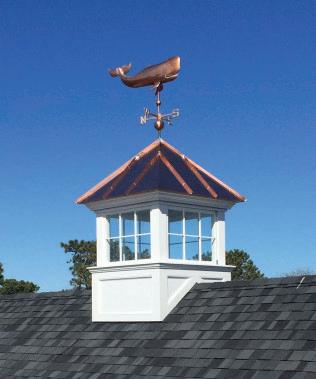












90-day money-back guarantee — 12-month warranty.To



“Your house for all occasions” 292 Chelmsford Street Chelmsford, MA 01824 For Free Brochure Call: 978-256-4061
Candies! For over 50 years we have used only the finest ingredients in our candies—cream, butter, honey, and special blends of chocolates. Call for a FREE brochure. Long famous for quality candies mailed all over the world. Treat yourself or someone special today.















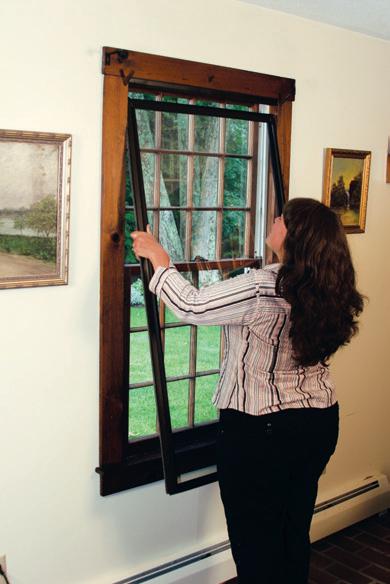





































(Continued from p. 120)















early departures from social gather ings, spontaneous trips not taken, leisurely mornings forsaken entirely. Tired? Chores. Raining? Chores. Sick? Chores. Cold? Chores. Dark? Chores. Really, really, really don’t want to do chores? Chores. Always, forever, unfail ingly, chores. And always the quiet awareness that your life is not entirely your own; there are living creatures who depend on you for the very basics of their survival, and the recognition of dependence is a small, constant gnaw ing on your consciousness. Of course, the same is true of pets, but in my expe rience there’s something about the way that pets live alongside you that makes their care feel less distinct from your own. Besides, livestock simply require more attention than most pets—not merely food and water, but also shelter and fencing, and none of this within the comfort of a shared home.
If I had to pick one species to live with, it wouldn’t even be close: I’m a cow guy, through and through. I think it’s because cows seem to embody a willingness to just let the world be as it is; their general attitude is one of quiet acceptance, and there’s a particular form of bovine contentment that I’m forever hopeful will rub off on me. So there’s that. I also love the smell of cows. Not the smell of their manure (which is the smell most people associate with cows and which, truth be told, I don’t mind in the least), but the up-close, nose-to-hide smell of them, the very essence of their cowness. I feel as though I should explain what it smells like, but the truth is, it just smells like cow. And maybe this is going to seem a bit shallow, but I like the way cows look. Specifically, I like the way they look when they’re grazing the knoll of pasture I can see from the table where I take my morning coffee. And I really like the way they look when I’ve been gone for the day and I come home to find them lying in the grass beneath the apple trees, resplendent in their bovine







contentment. In those moments, I can tell that it’s actually working: It is actually rubbing off on me.



Despite the sacrifices, I consider it a privilege to keep livestock. Or maybe the sacrifices are part of the privilege, because isn’t it true that the things that demand some sacrifice are often the same ones that bring the most mean ing to our lives? And I am grateful to live within an ecosystem that includes livestock, to see how the sun becomes the grass, the grass becomes the ani mal, and the animal becomes me. And then to spread their composted manure atop our garden or at the base of our blueberries, and watch all that life spring forth, too. Where, exactly, is the line between life and death? The longer I live among our livestock, the more porous that line becomes.
I used to imagine that we’d always keep livestock, but I’m old enough now to understand “always” is never as certain as we’d like to think. Besides, the boys are mostly gone, taking their insatiable appetites with them, and their absence is creating new possi bilities for Penny and me. For the first time in many, many years, I can imag ine that the sacrifices we’ve made to tend these animals over all these years could someday feel less meaningmaking. This is not true now, and I don’t know if it will come to pass. I only know that I can’t say for certain that it won’t.


But that is the possible story of another day, not this one. On this one, I’m going to finish writing the next few sentences, and then I’m going to throw another log on the fire. I’m going to lace up my chore boots and shrug into my chore jacket. It’s not a sunny day, but I can see the clouds thinning. On this day, I’m going to first move the lambs, then I’m going to feed the pigs, then I’ll check on the cows, though they shouldn’t need much. They’re graz ing the last of the rich orchard grass before winter, and just yesterday I filled their water trough. But I’m pretty sure that if I get down there early enough, they’ll still be lying beneath those trees, and the truth is, I just want to go have a look.






















Keeping animals means endless chores, and moments of contentment.
BY TOM HAUGOMAT
t occurred to me recently that we have now lived with animals for nearly 25 years, a habit that dates back to 1997, the year we bought our land. This was also when we built a chicken coop and populated it with hens before we broke ground on our own shelter. Since then, we’ve never not had livestock; shortly after the chickens we procured pigs, then cows, and before long the sheep came to live with us. Over the past quarter century, we’ve kept all the aforementioned species, plus a hand ful more: There were the cantankerous
ducks and the boys’ endlessly bleating dwarf goats, a brief foray into rabbits, and a few flocks of turkeys. It feels as if I might be missing something, but it also seems as if I’m running out of likely species, so perhaps that’s a full accounting. Full enough, anyhow.
Right now, we have three cows and four lambs and two pigs, though by the time you read this, we’ll have only two cows, and we might or might not still have two pigs, depending on how they size up. The lambs for sure will have met the fate they were always destined for. I like the lambs. I like moving them
to new grass every few days, a chore that almost invariably takes place in the half-lit morning just before the full onset of day, which is a very nice time to be outside. And I like how they gather around me when I step inside their fence. They nibble at my pants and, if I let them, on the tips of my outstretched fingers. But liking an animal—loving it, even—does not preclude the truth residing at the core of our relationship.
We’ve sacrificed a lot to keep live stock. There have been innumerable

Start off

















new year
visit to the legendary Omni Mount Washington Resort, Conde Nast Traveler’s Readers’ Choice for the #1 Resort in New Hampshire. Hit the slopes of Bretton Woods, recently named #4 Overall in the U.S., #2 Overall in the East and #1 in the East for Grooming and Lifts by readers of SKI magazine. Fly high on the Bretton Woods Canopy Tour, relax in the full-service Spa or take in the views from your private balcony in the new Presidential Wing guest rooms.
